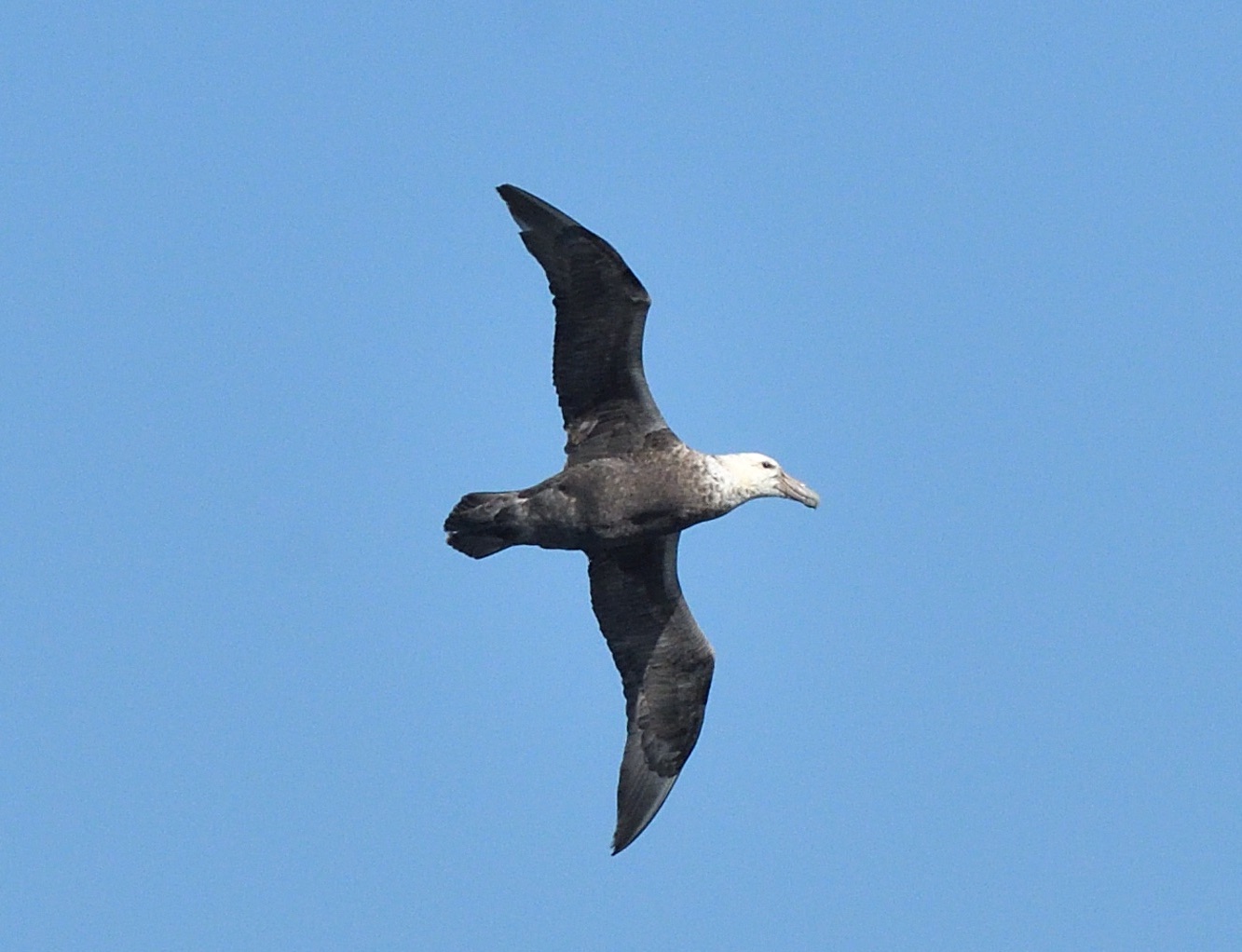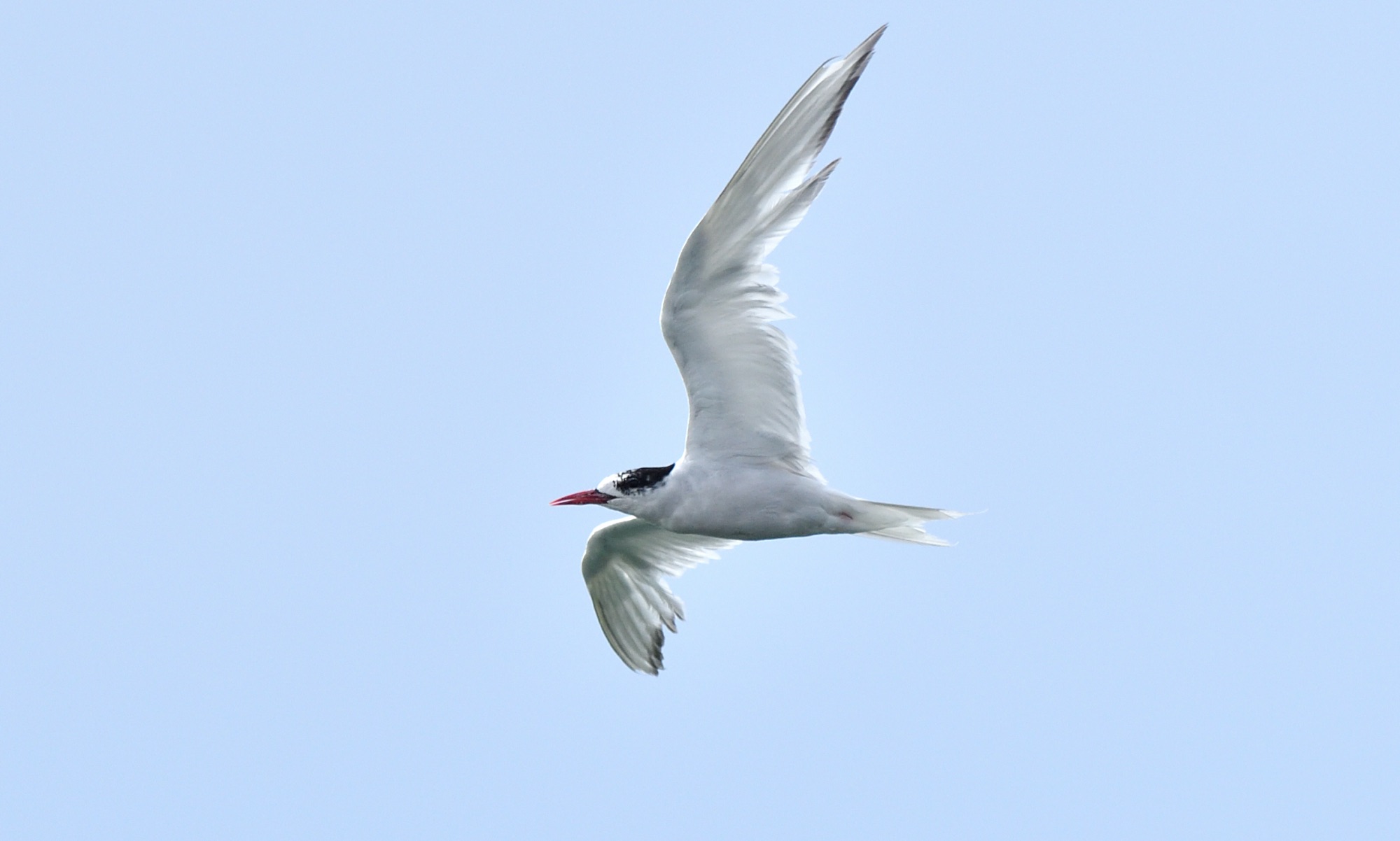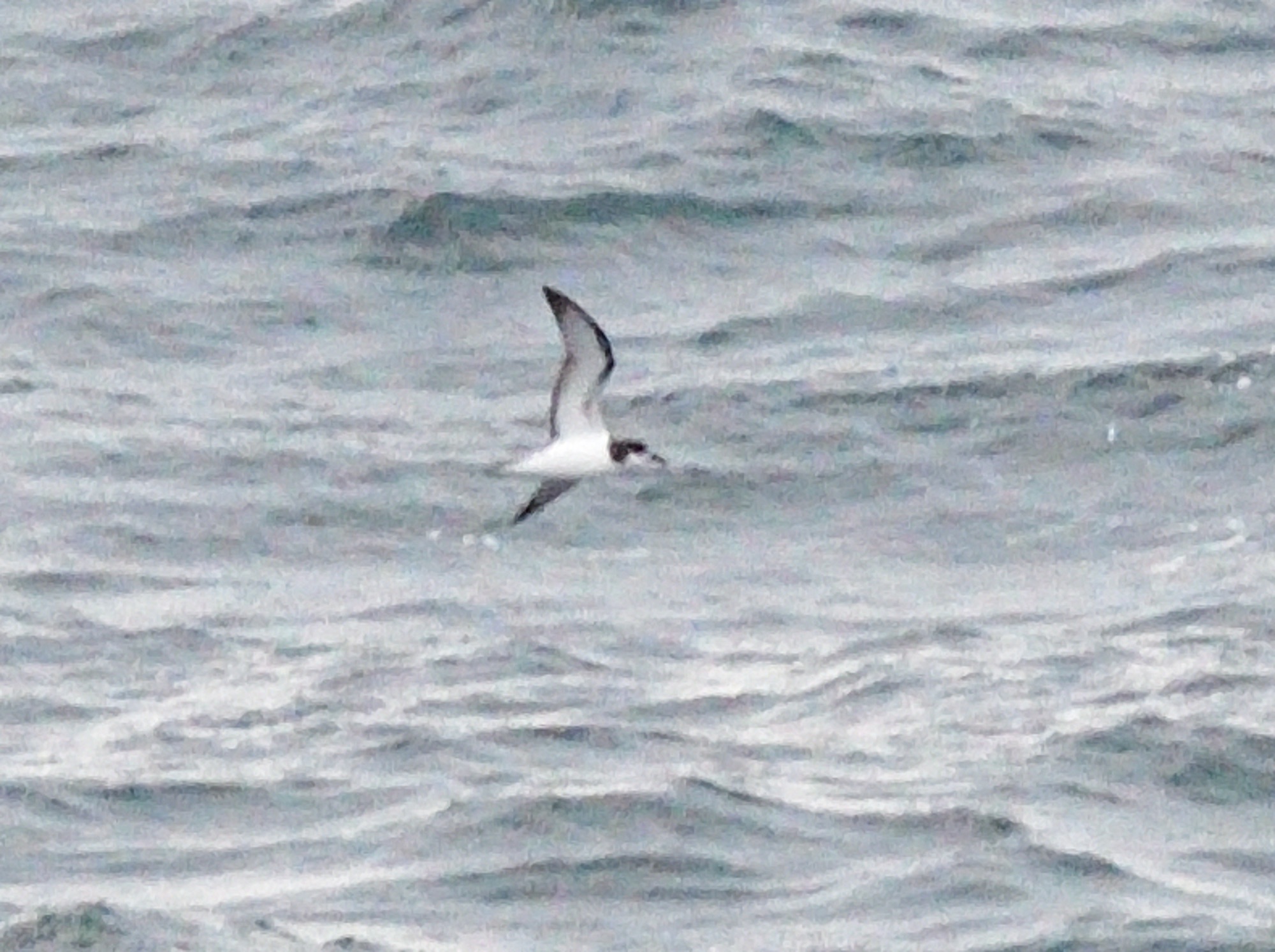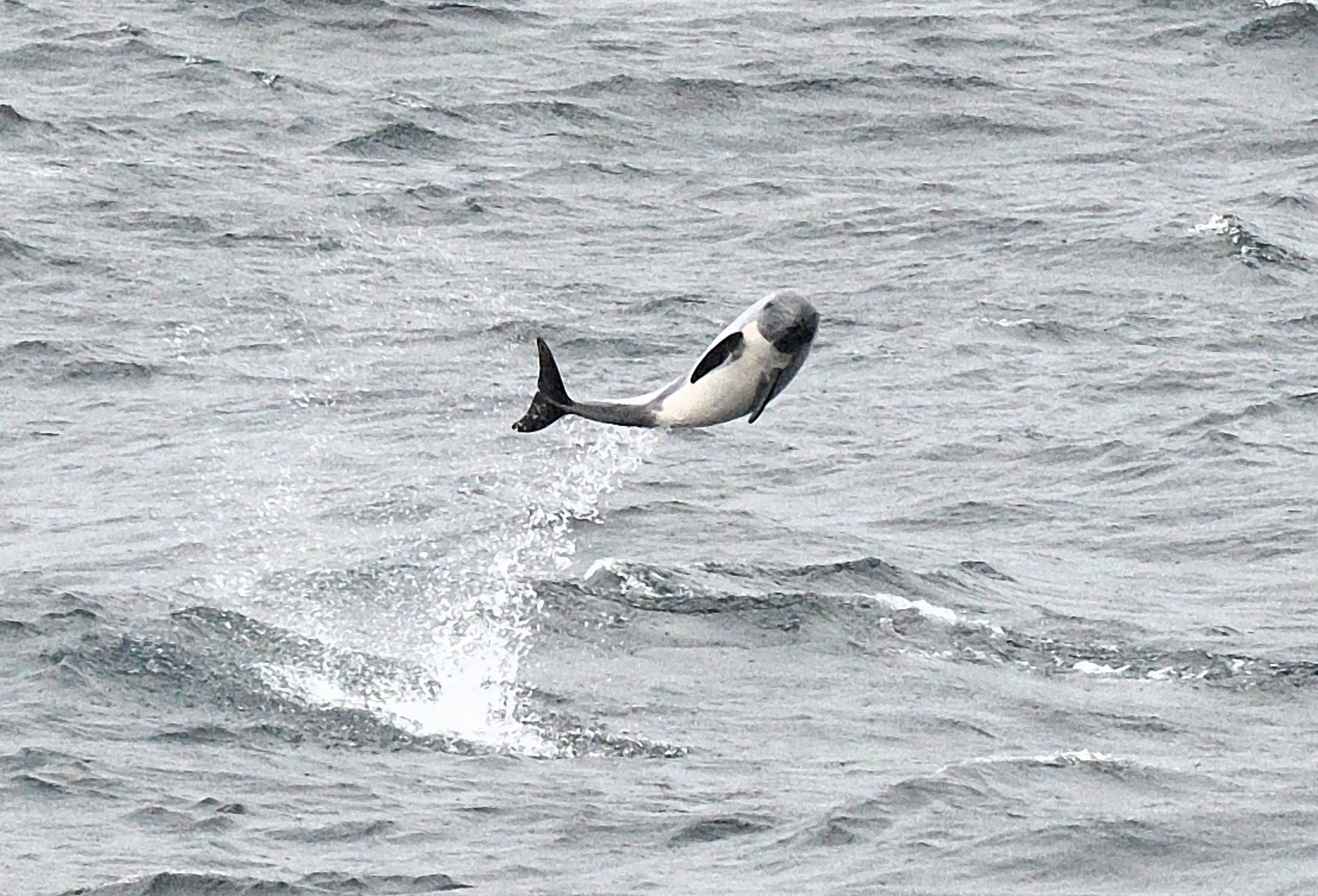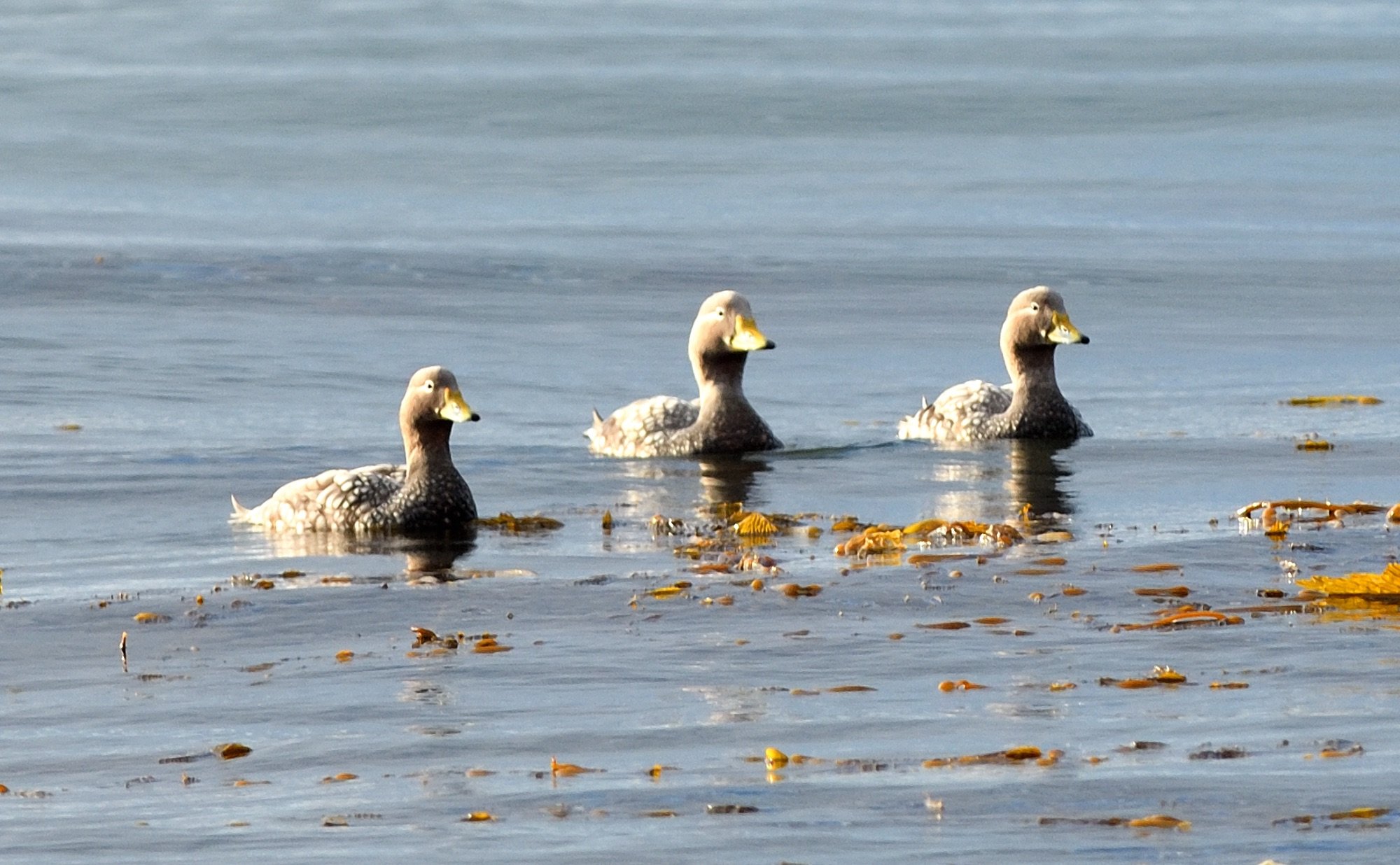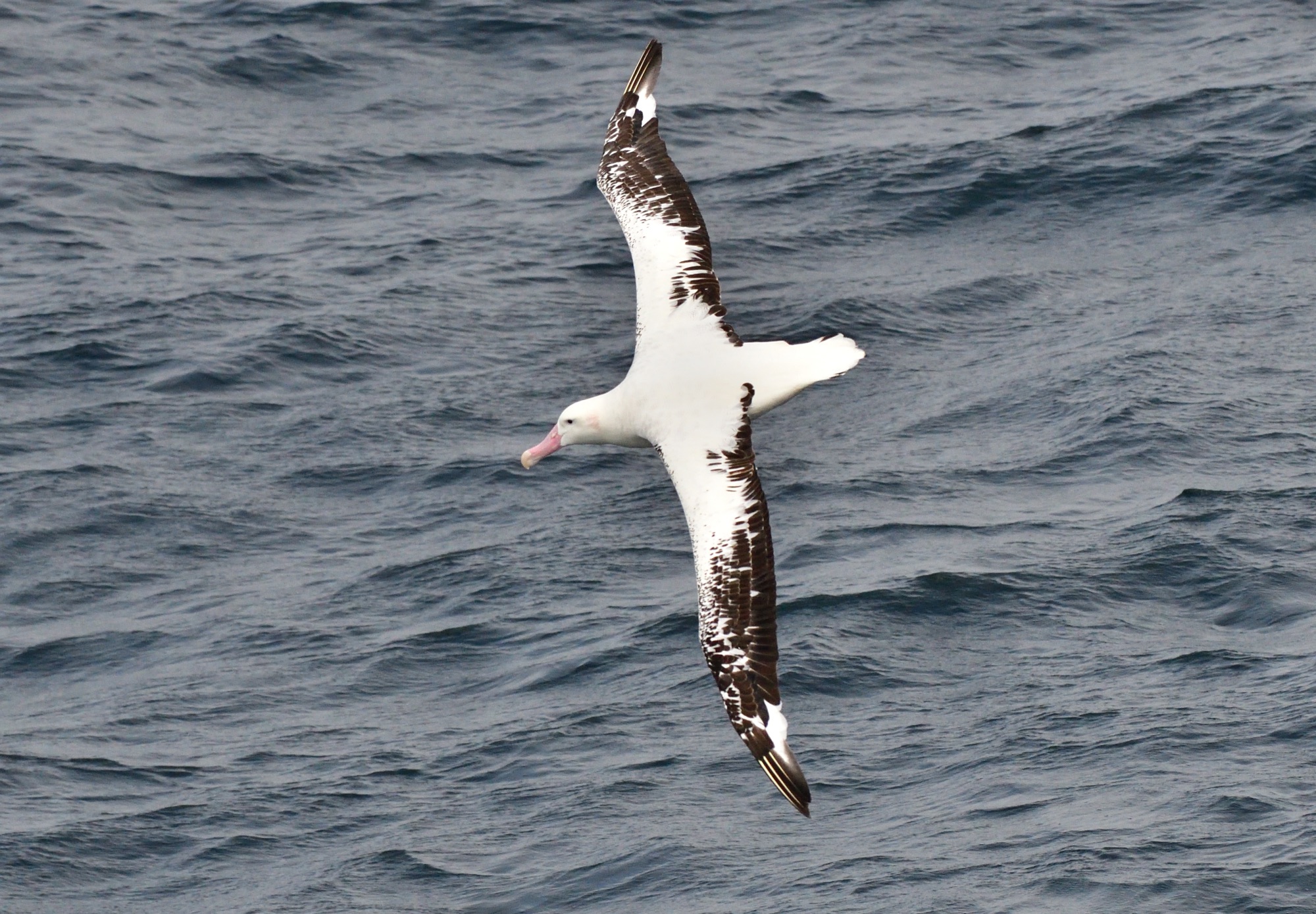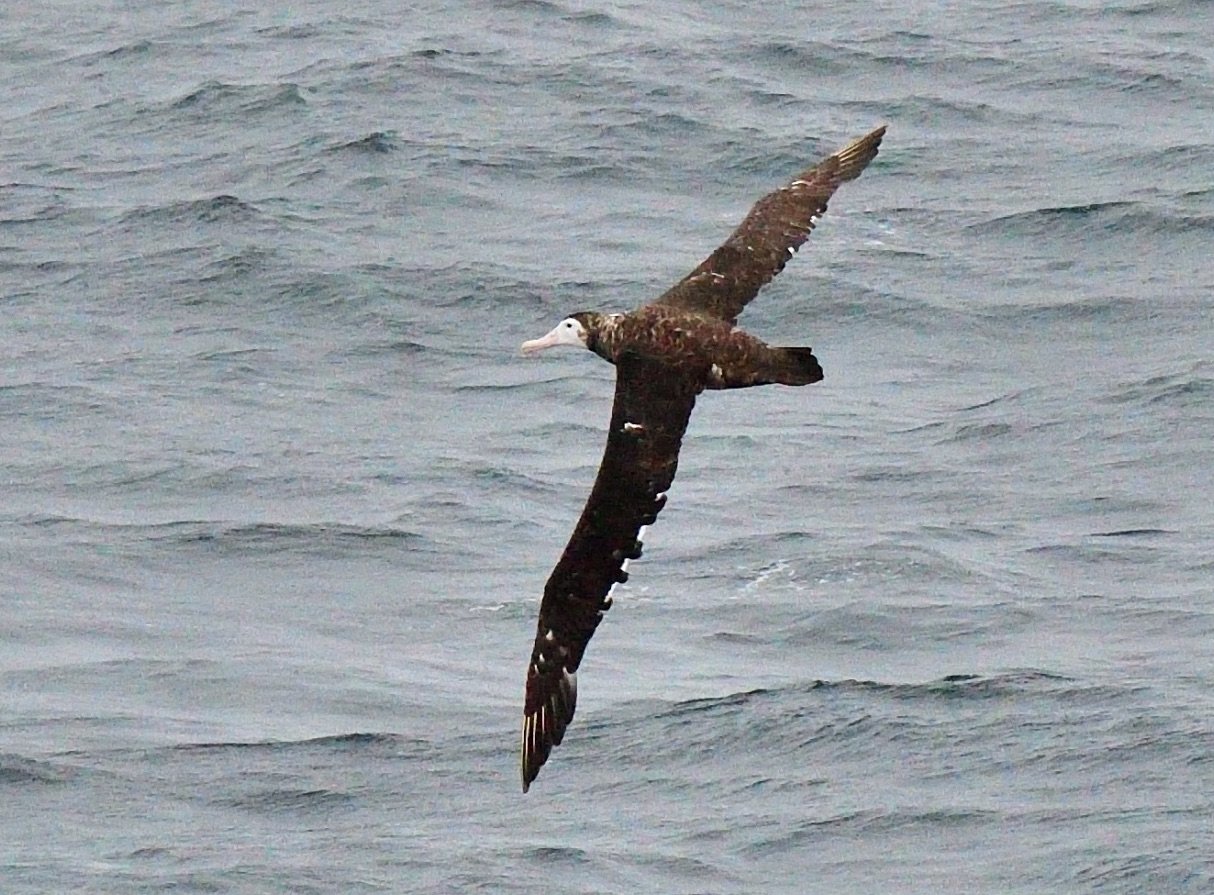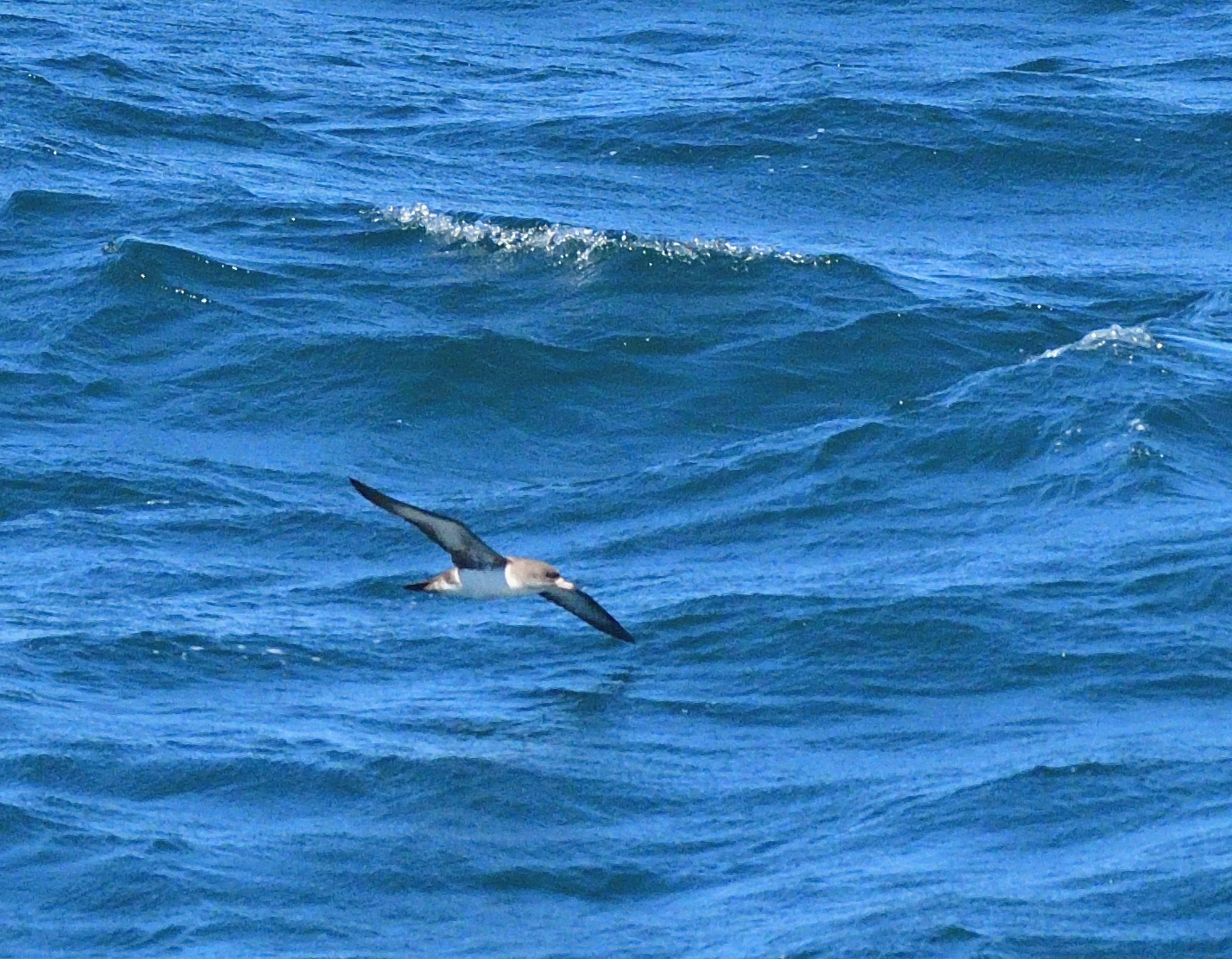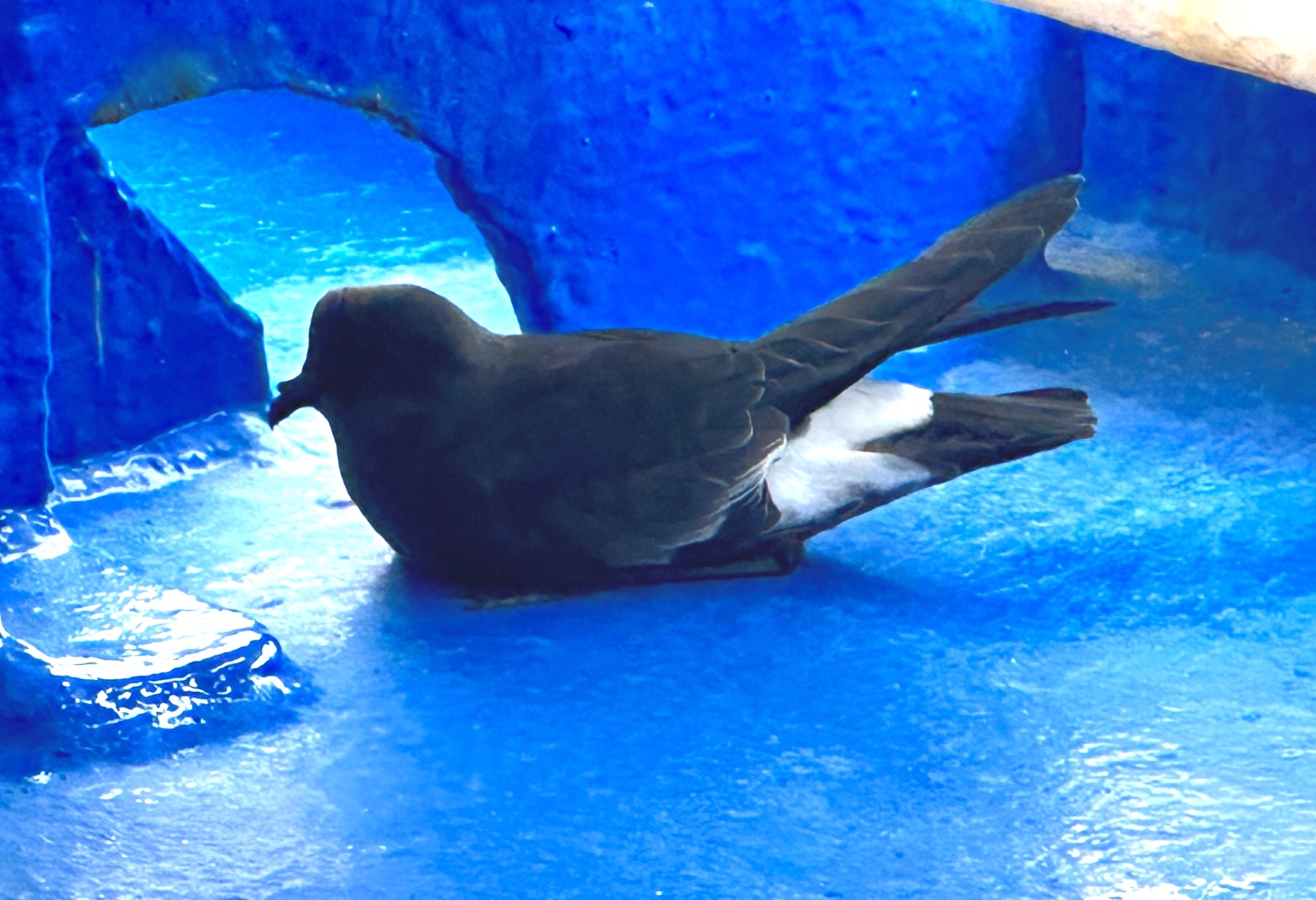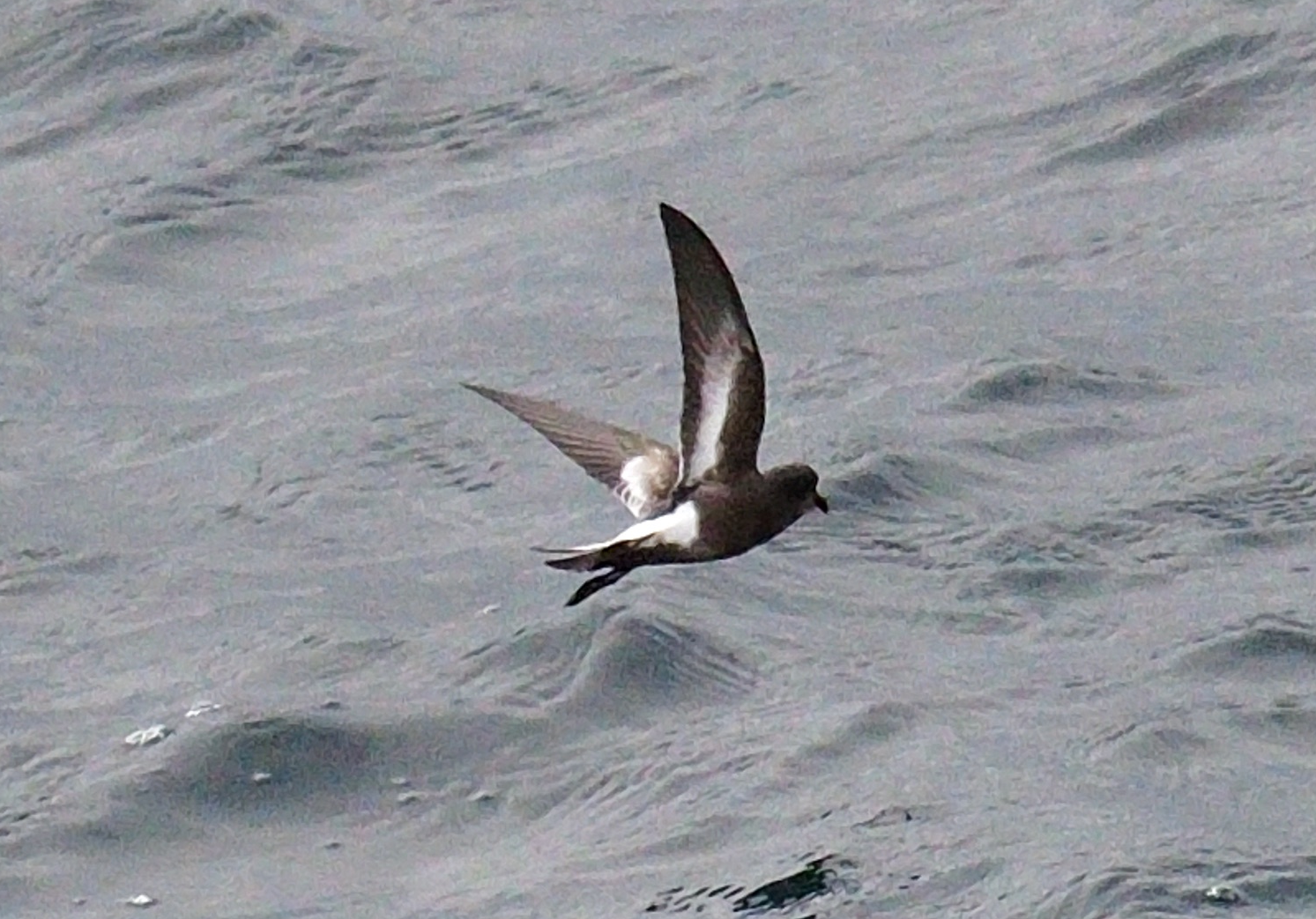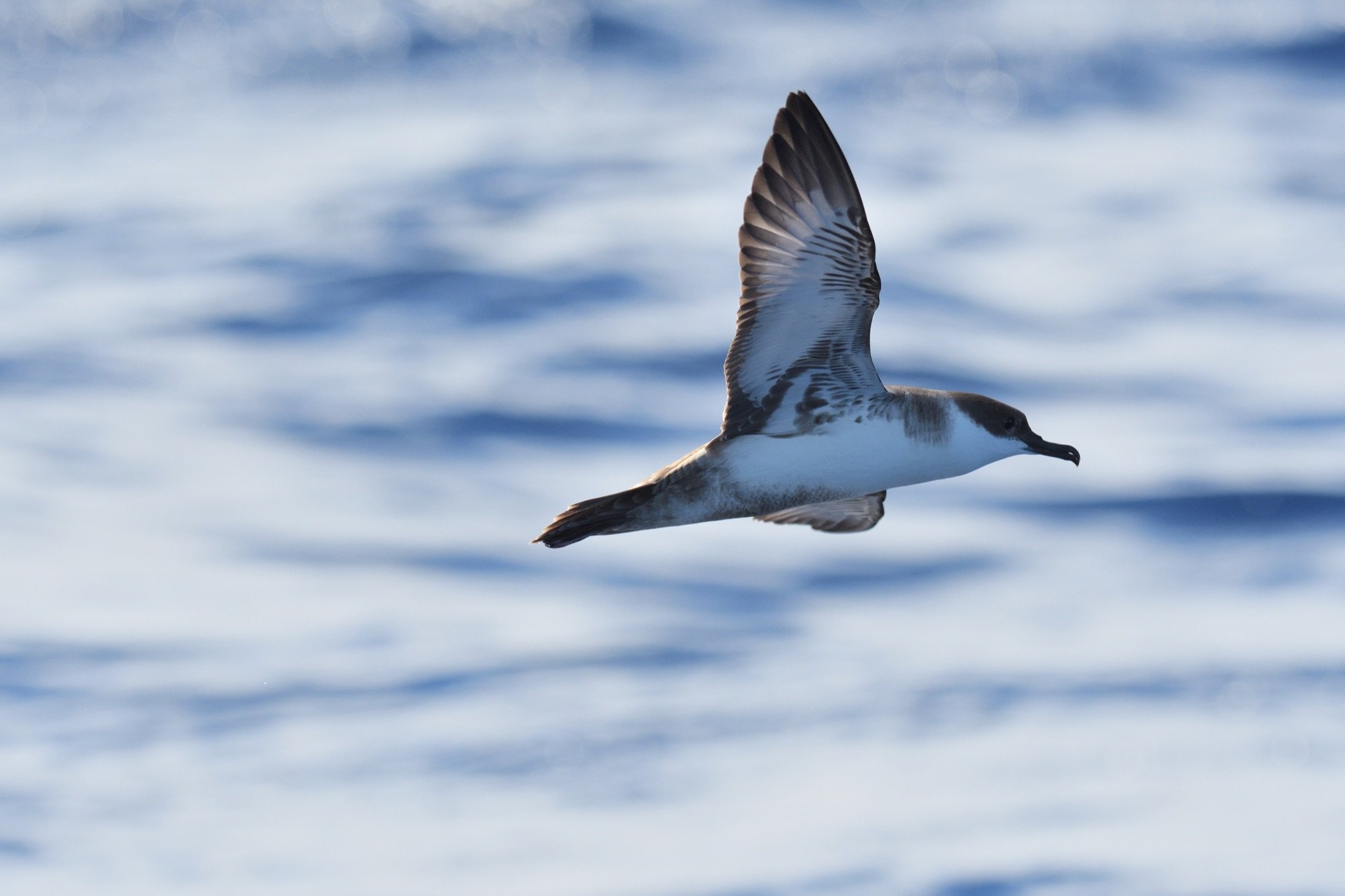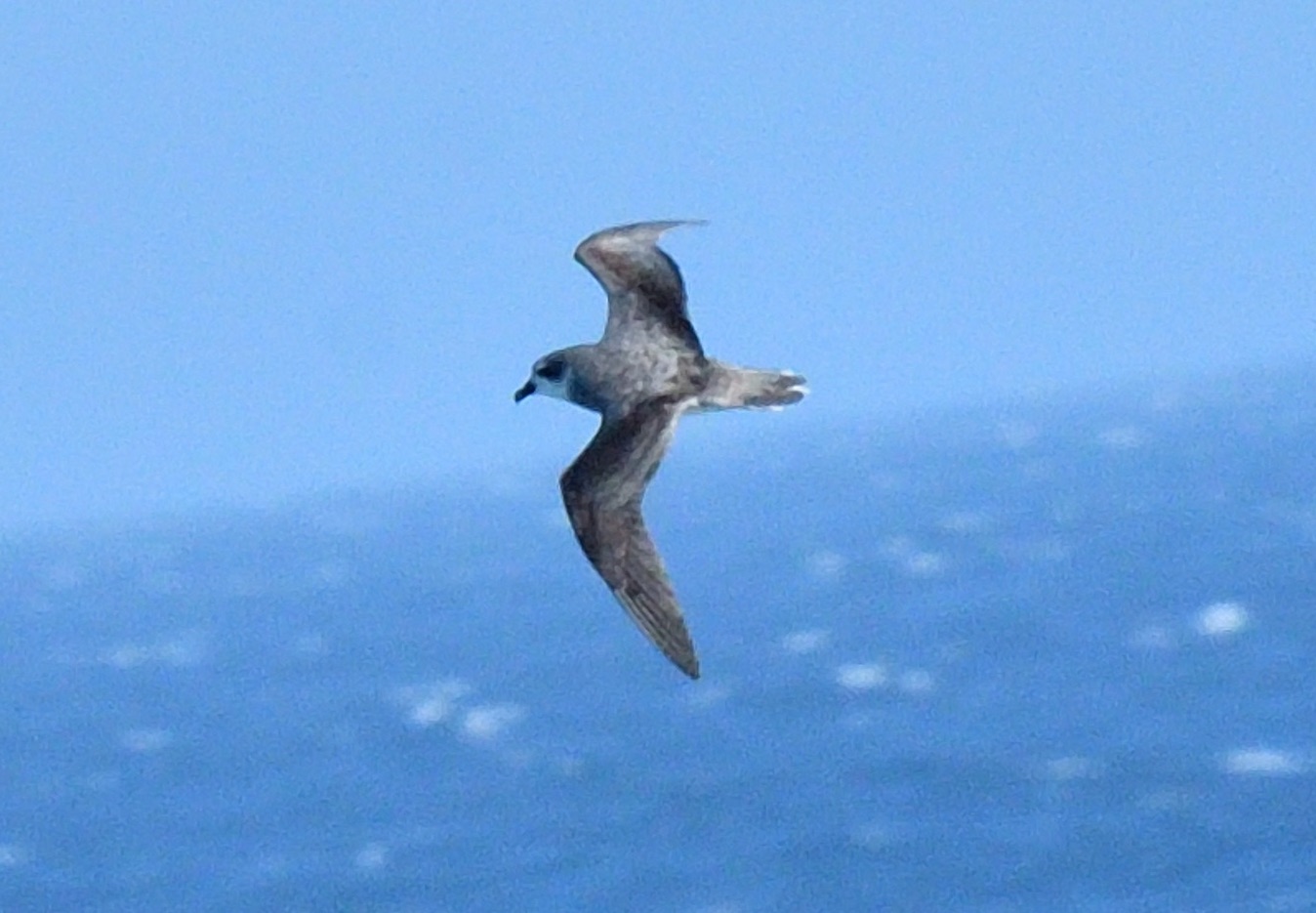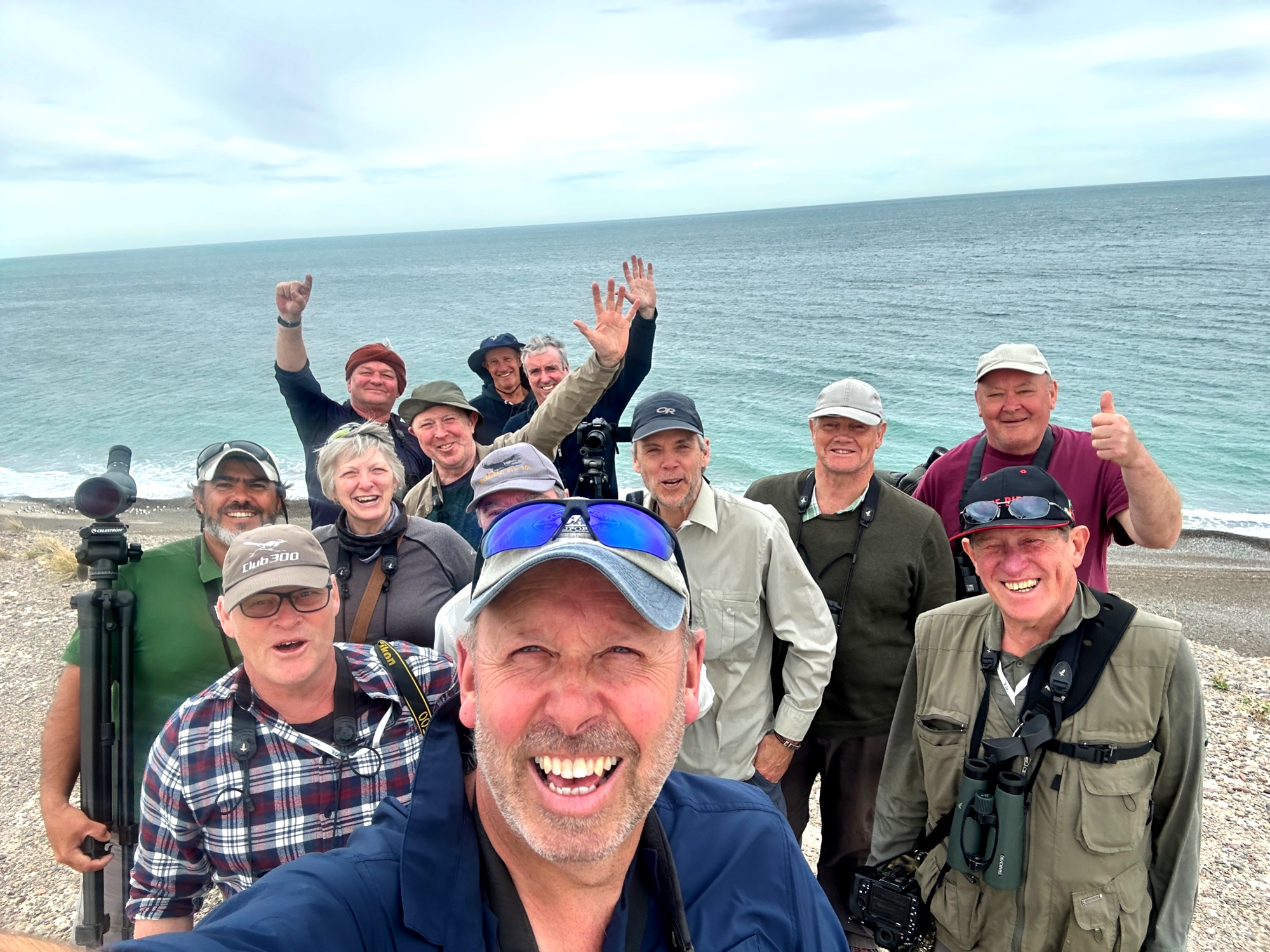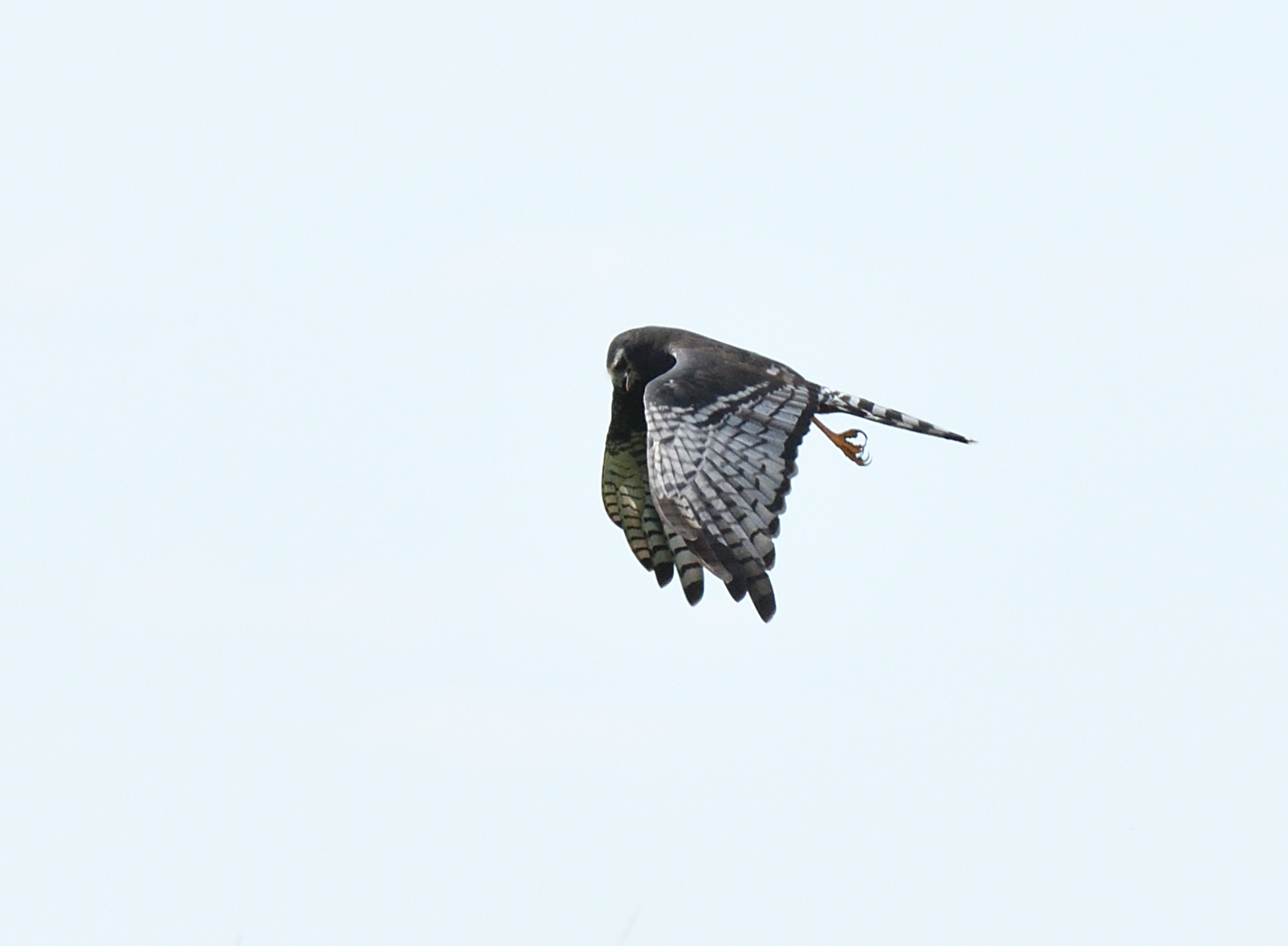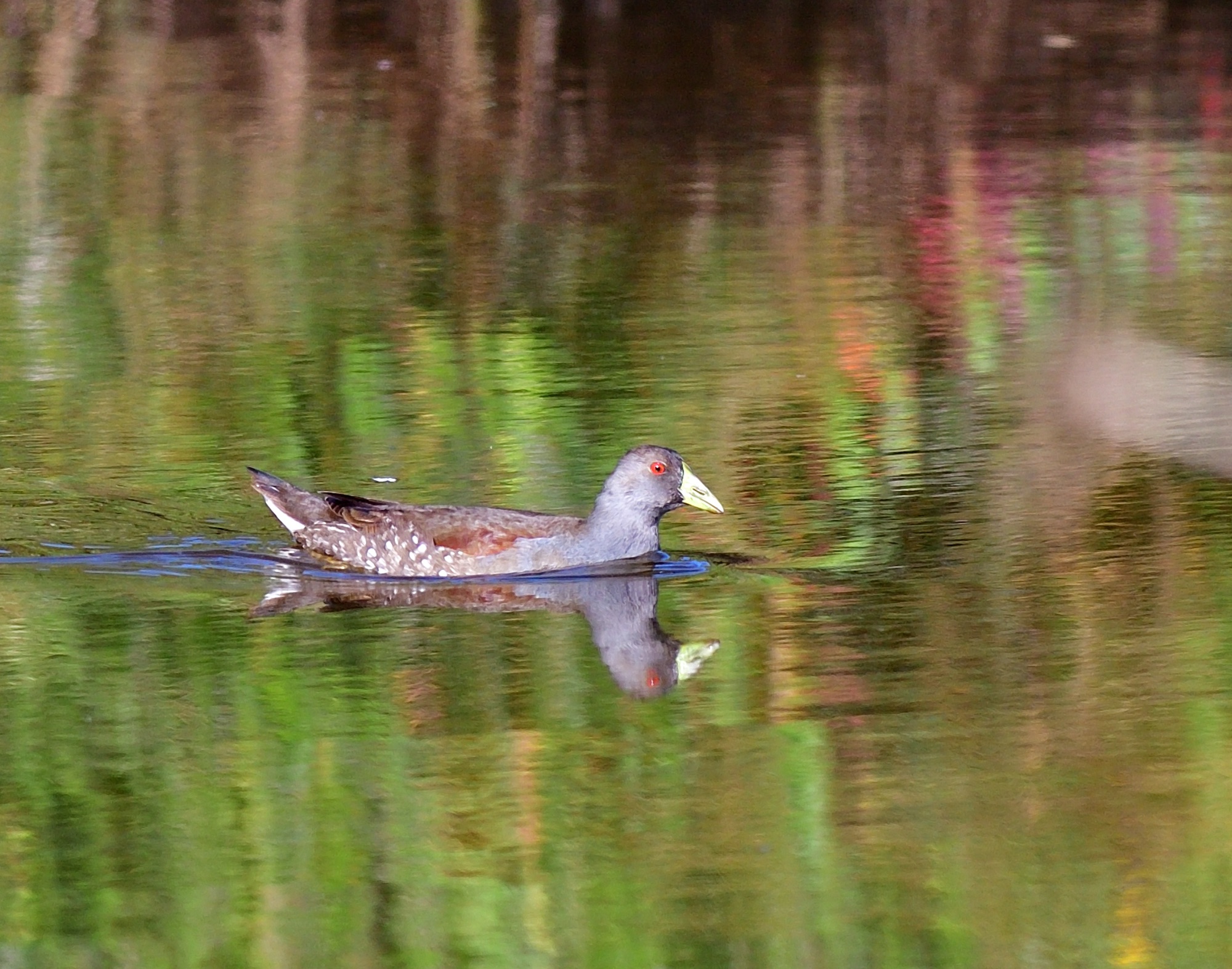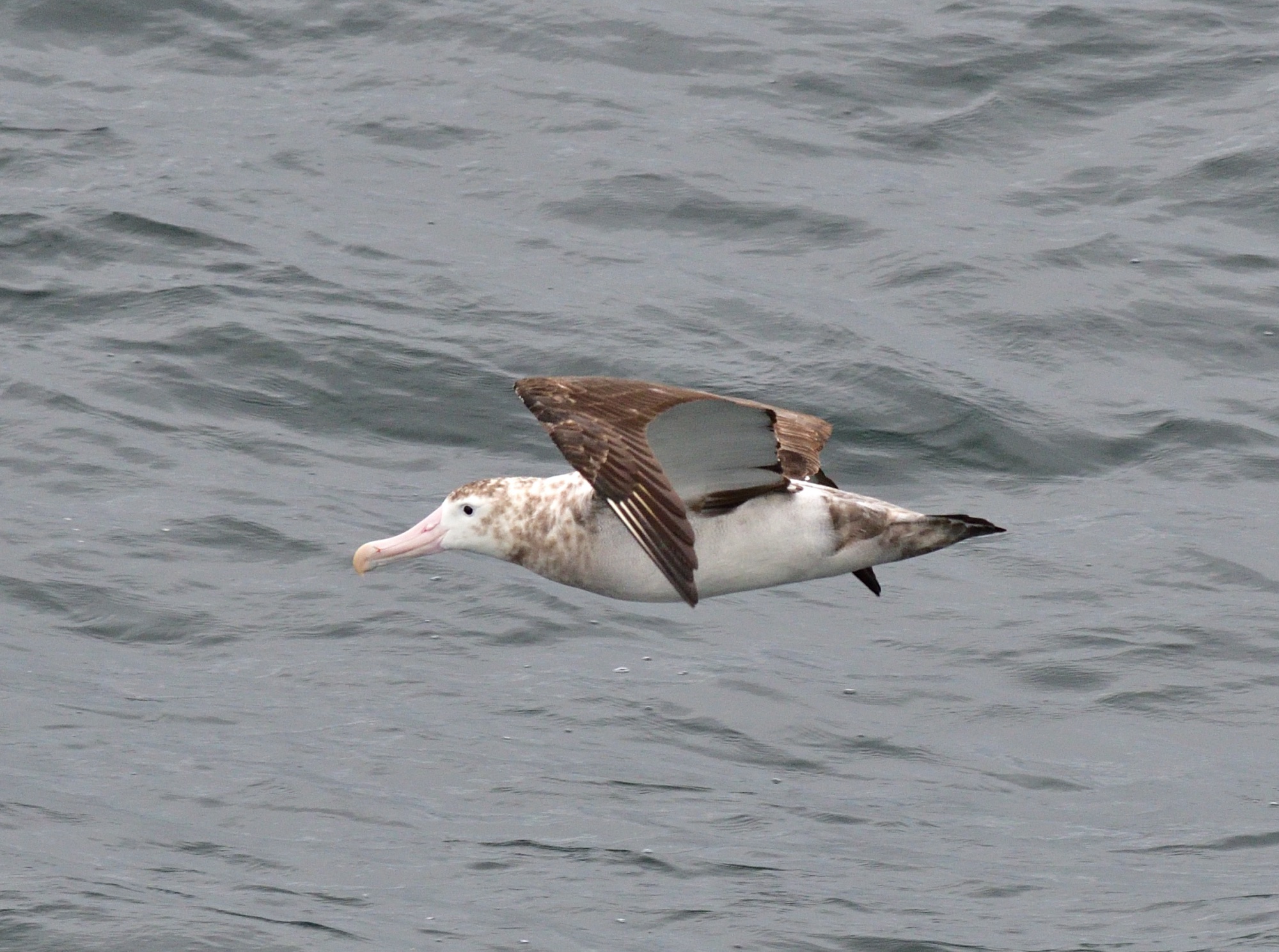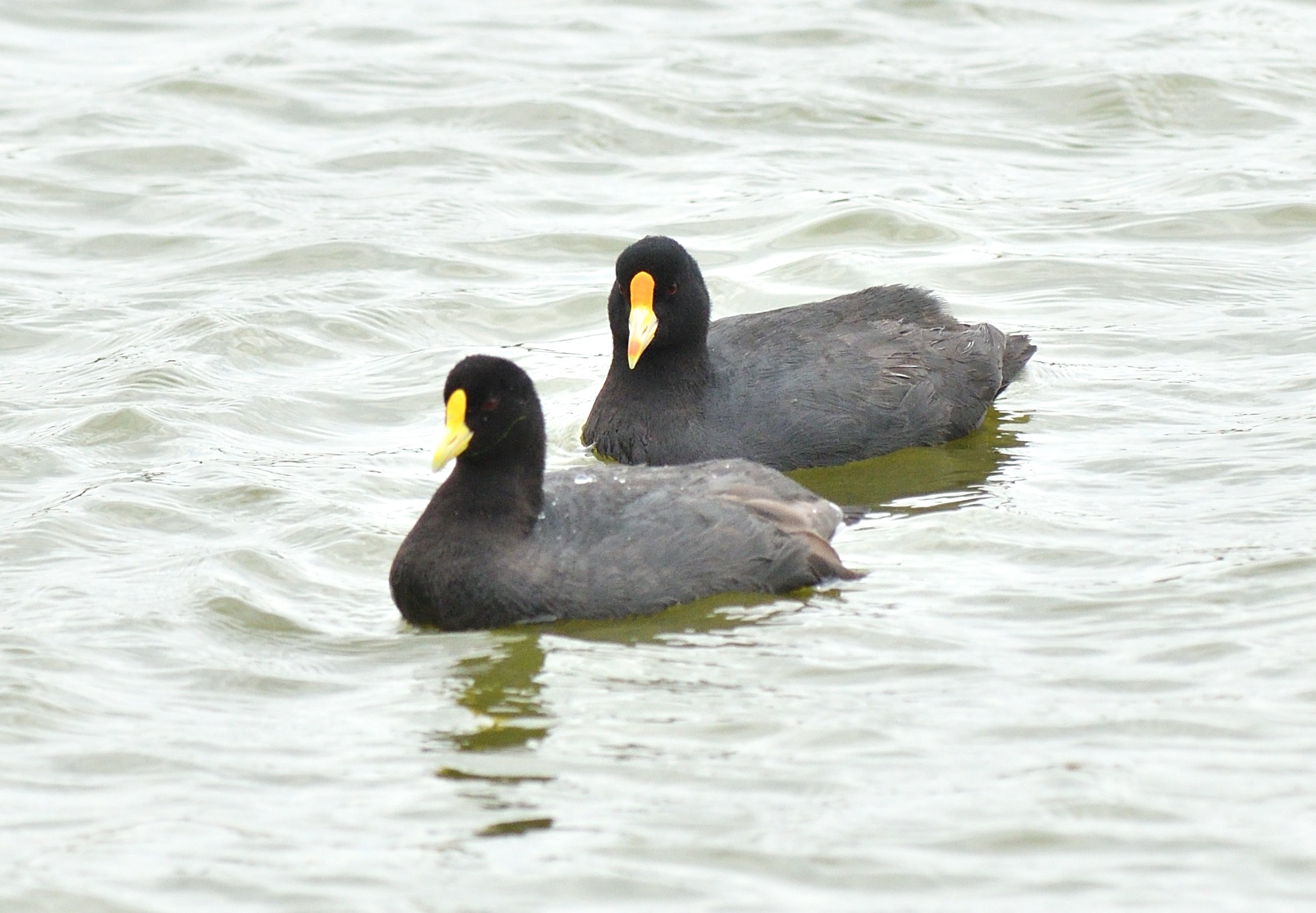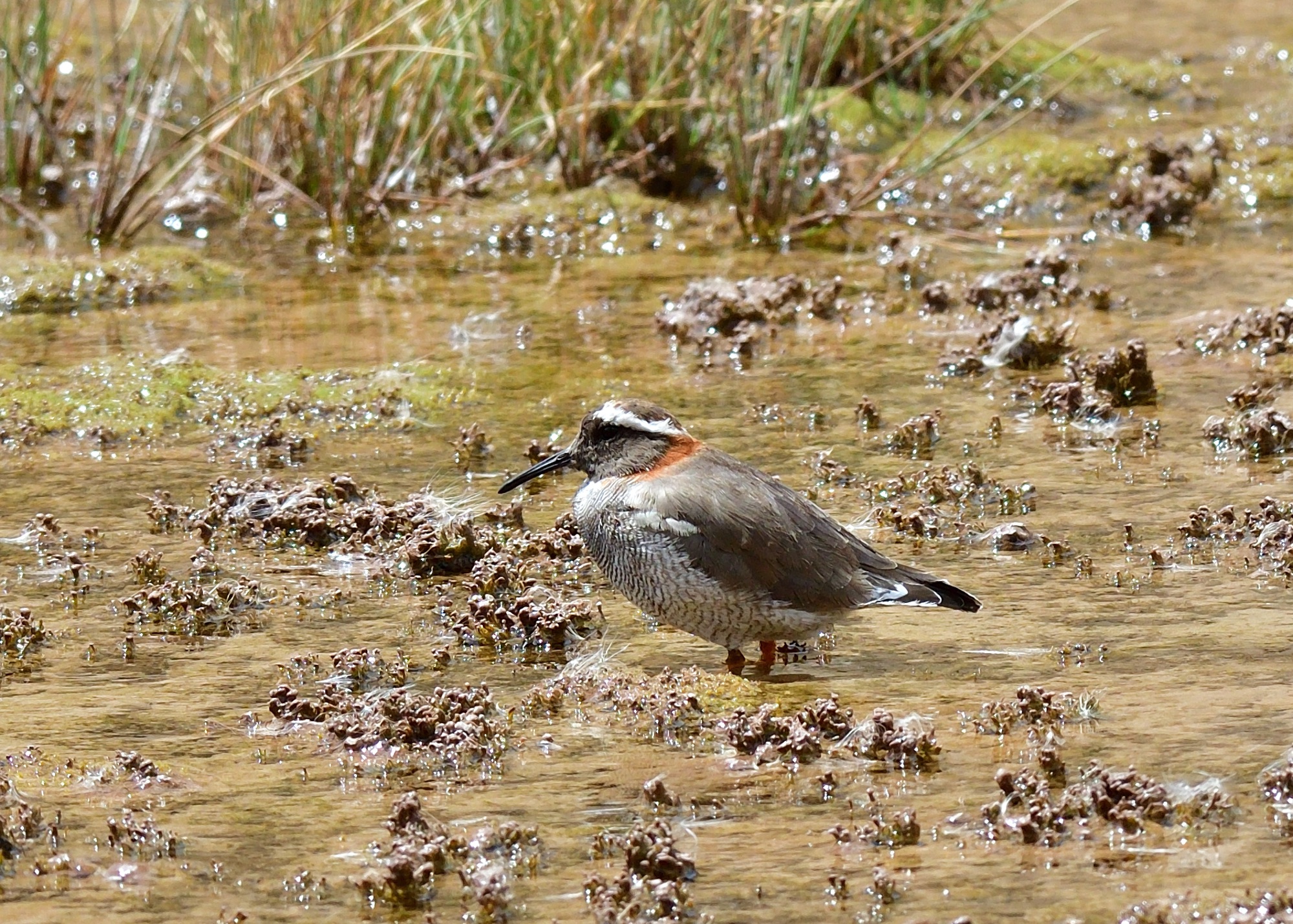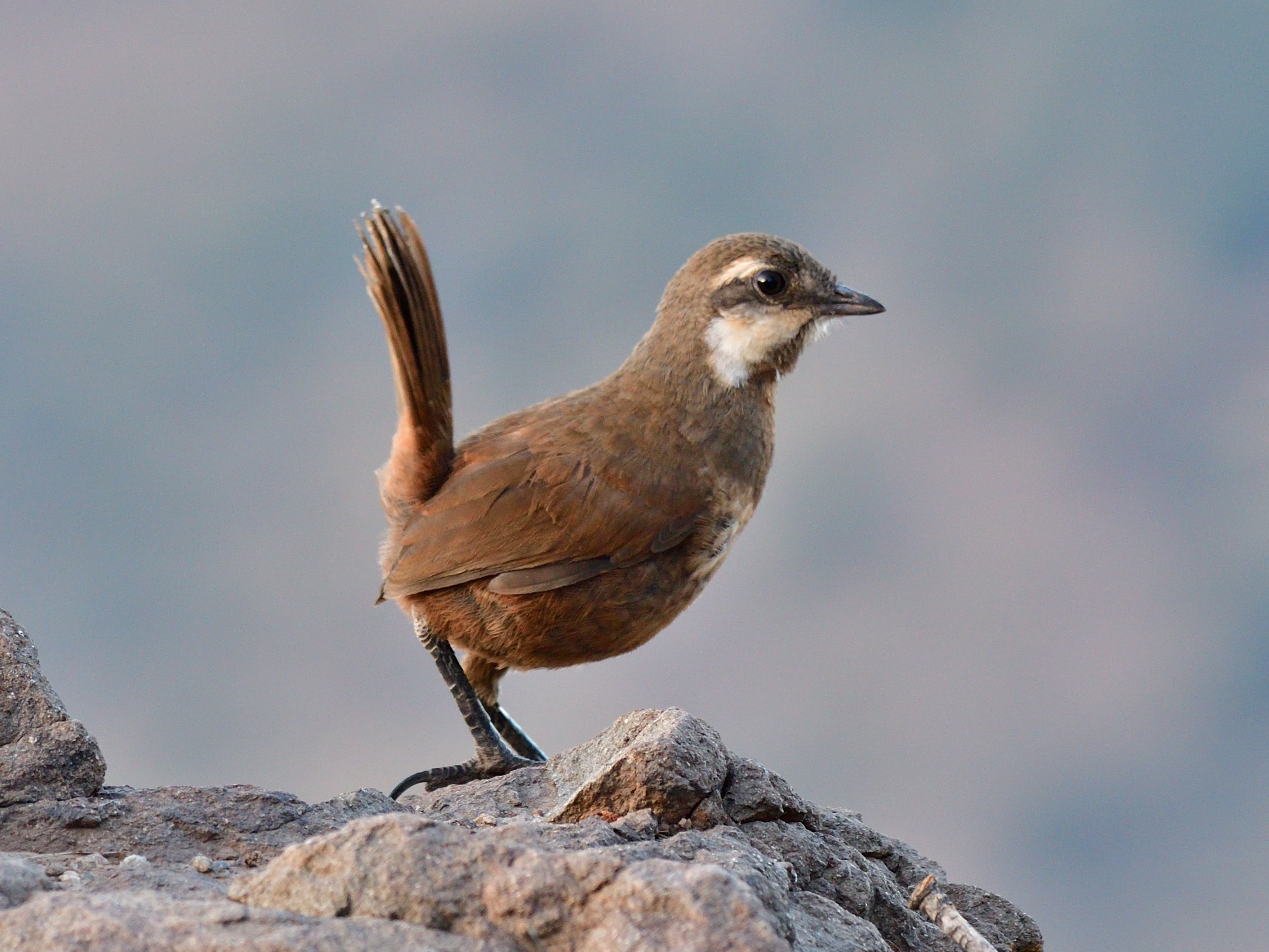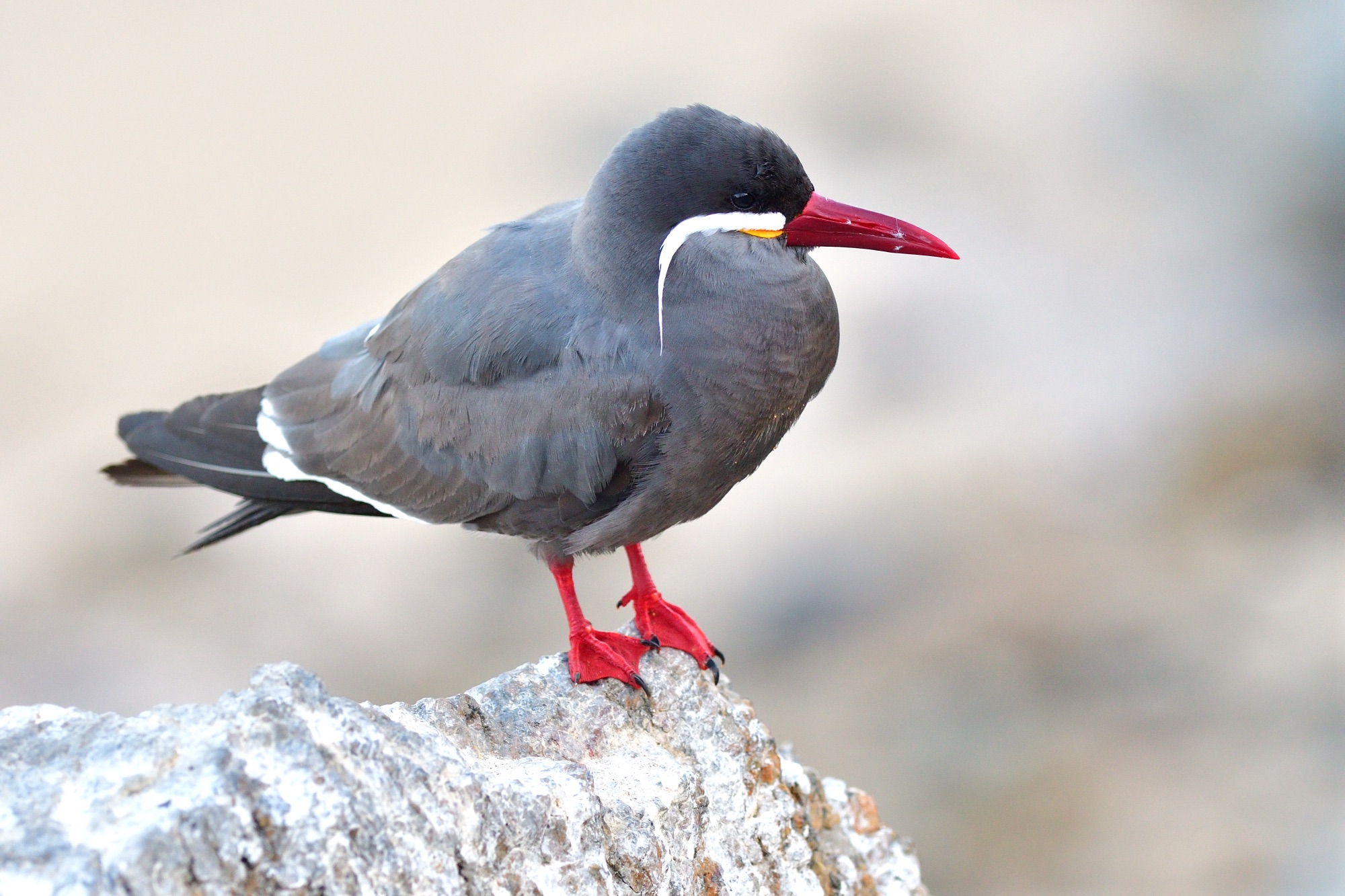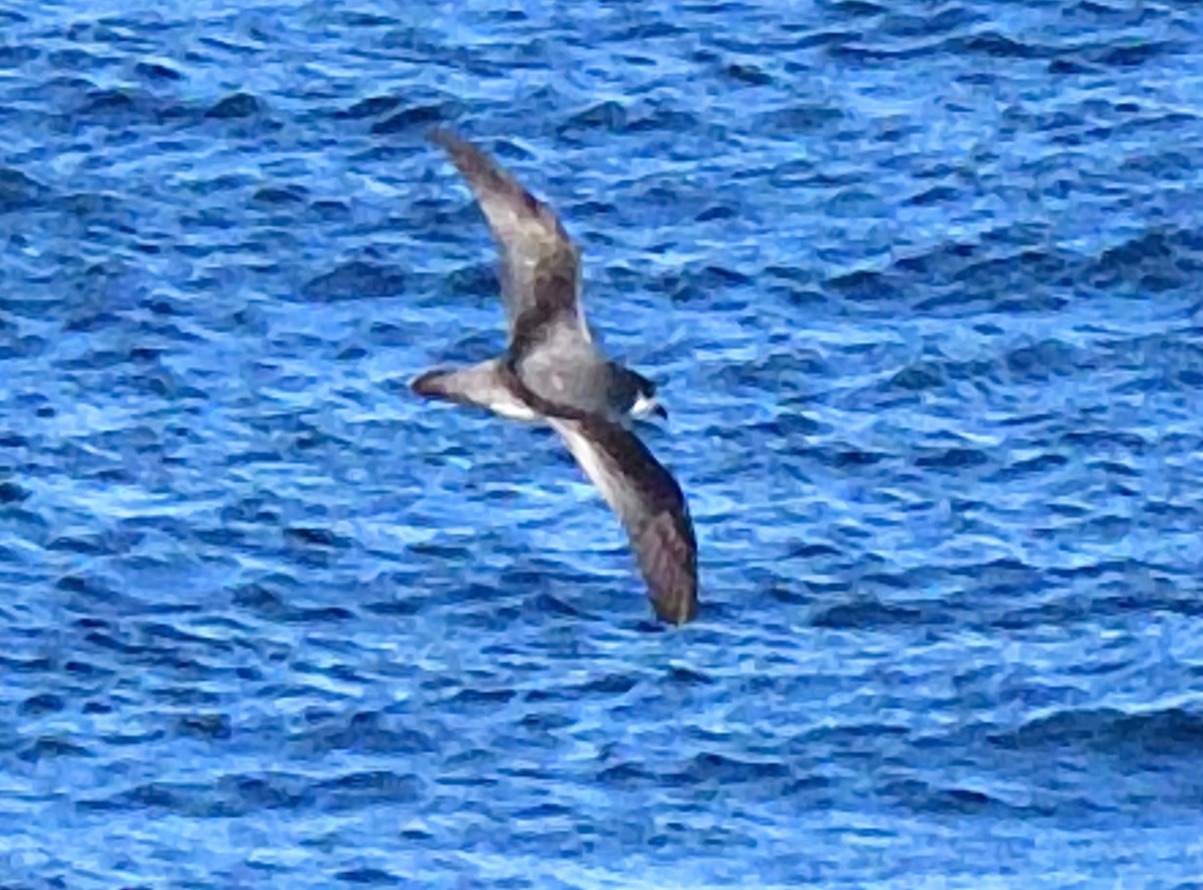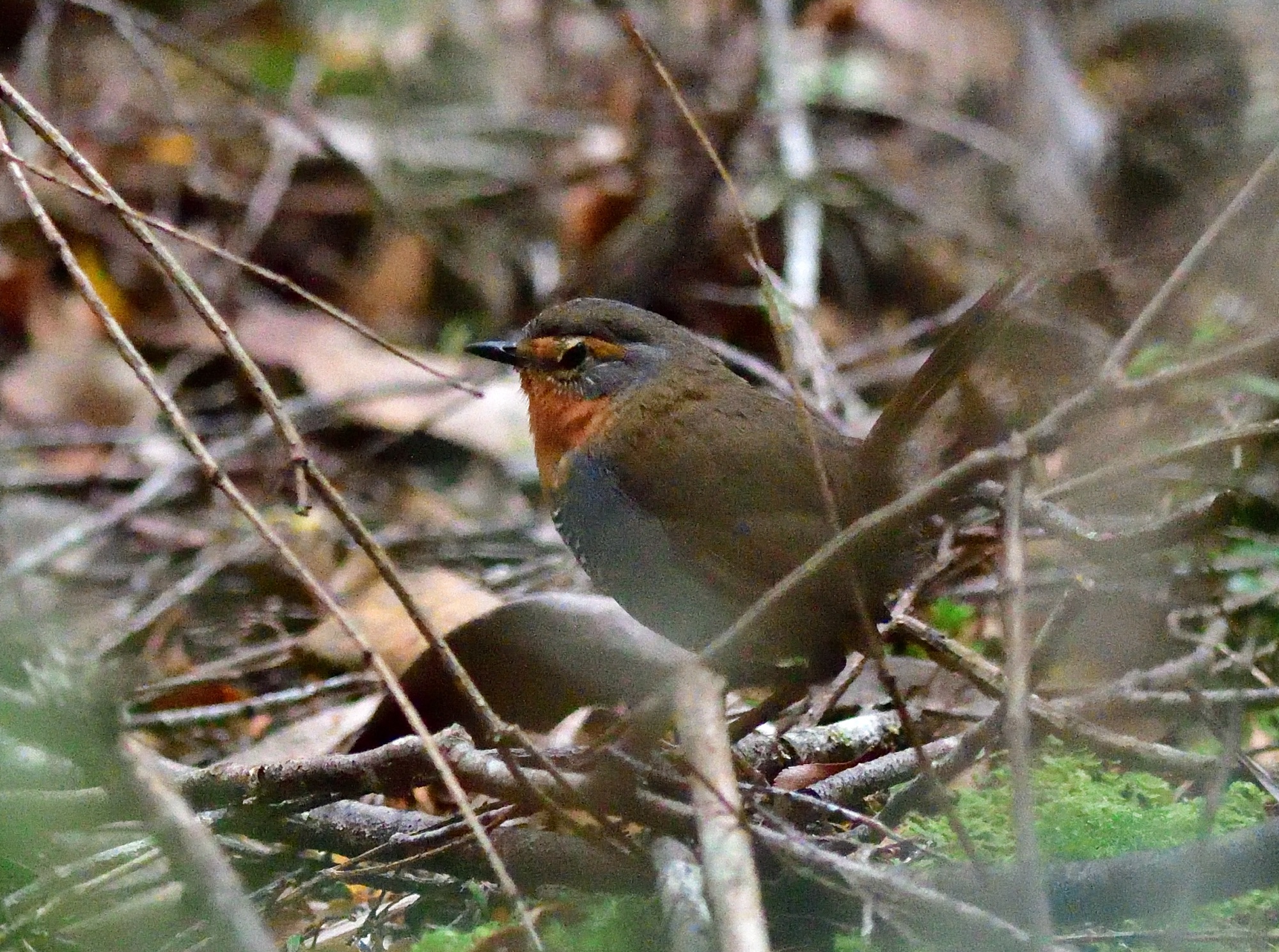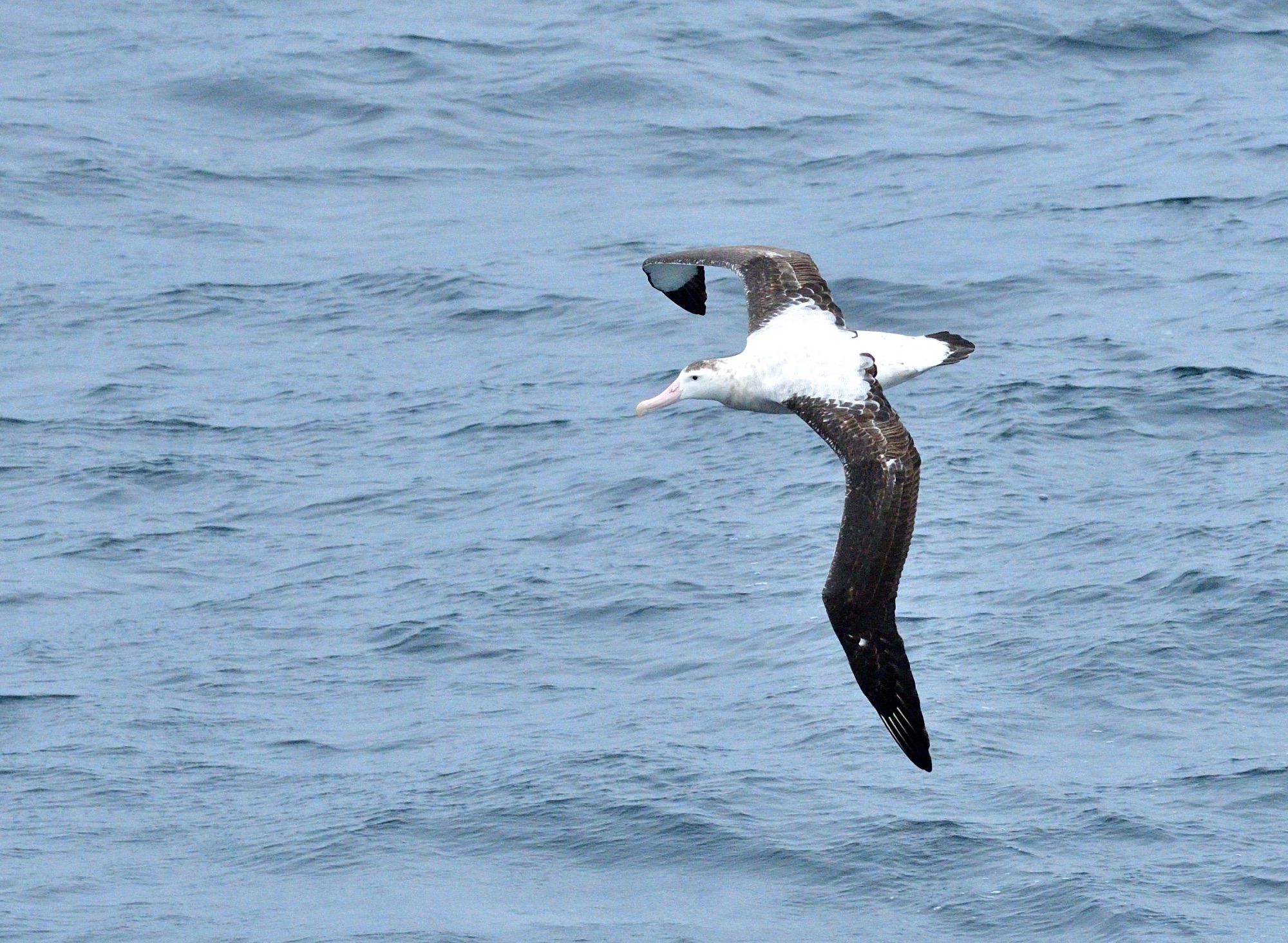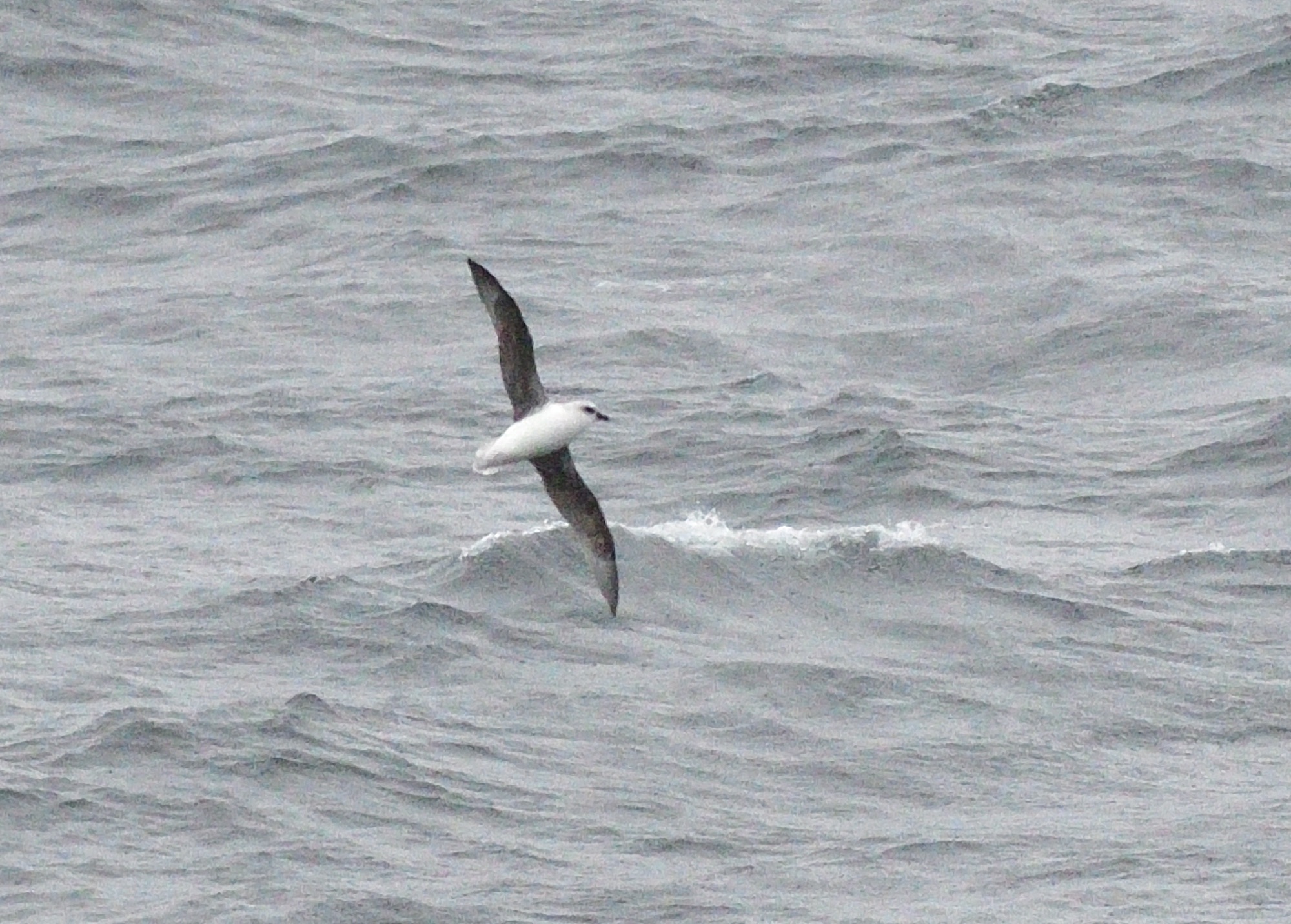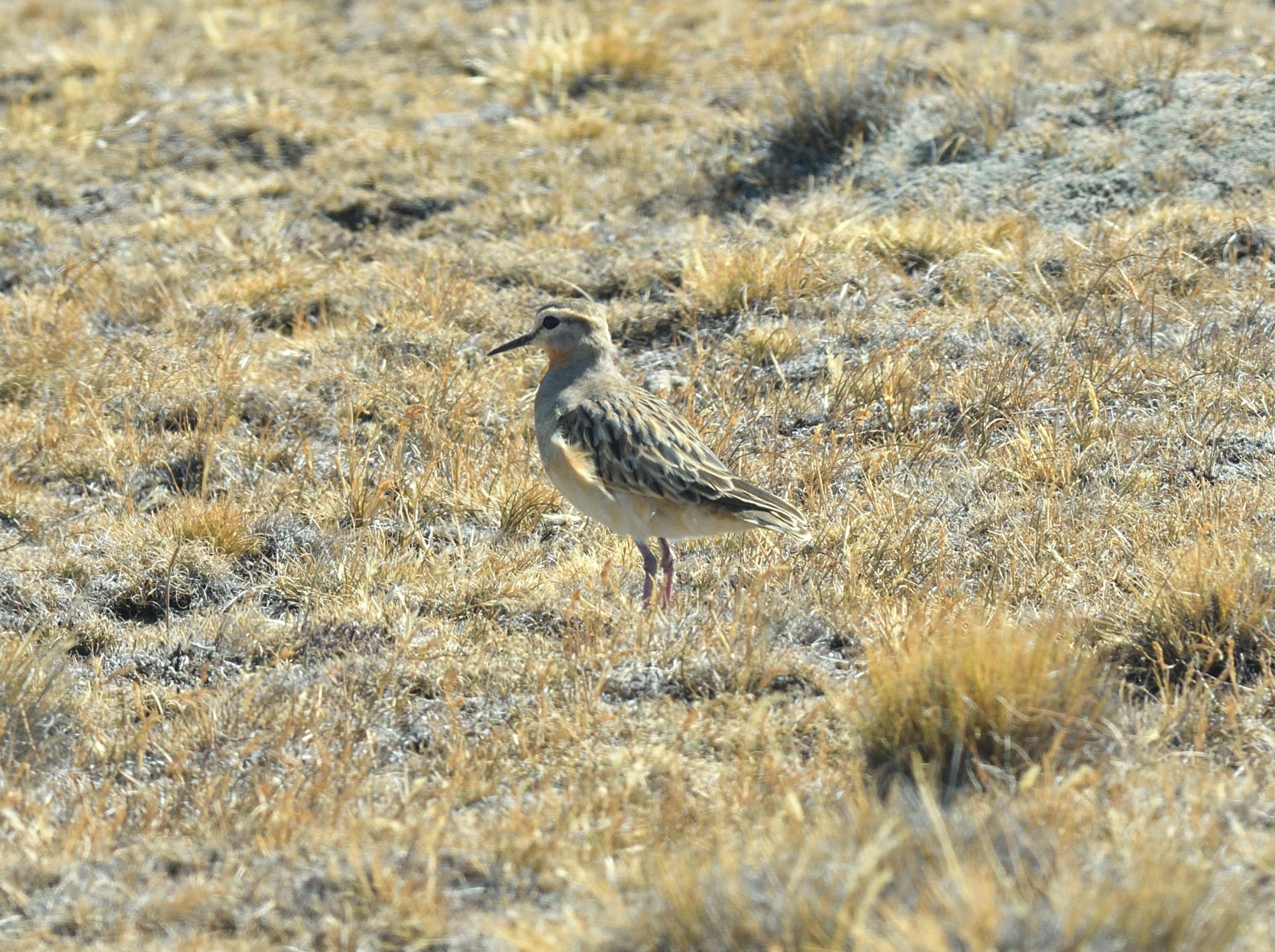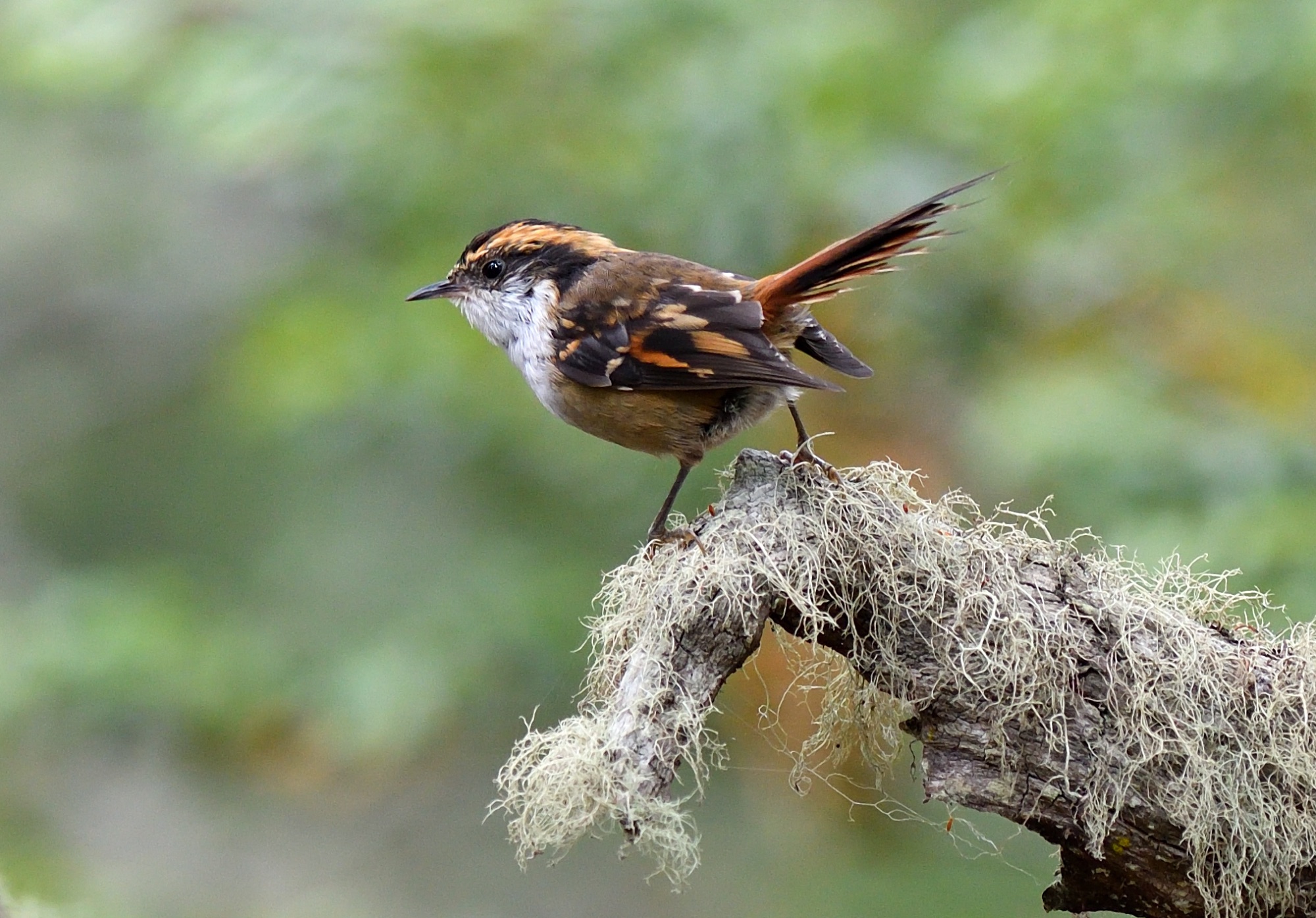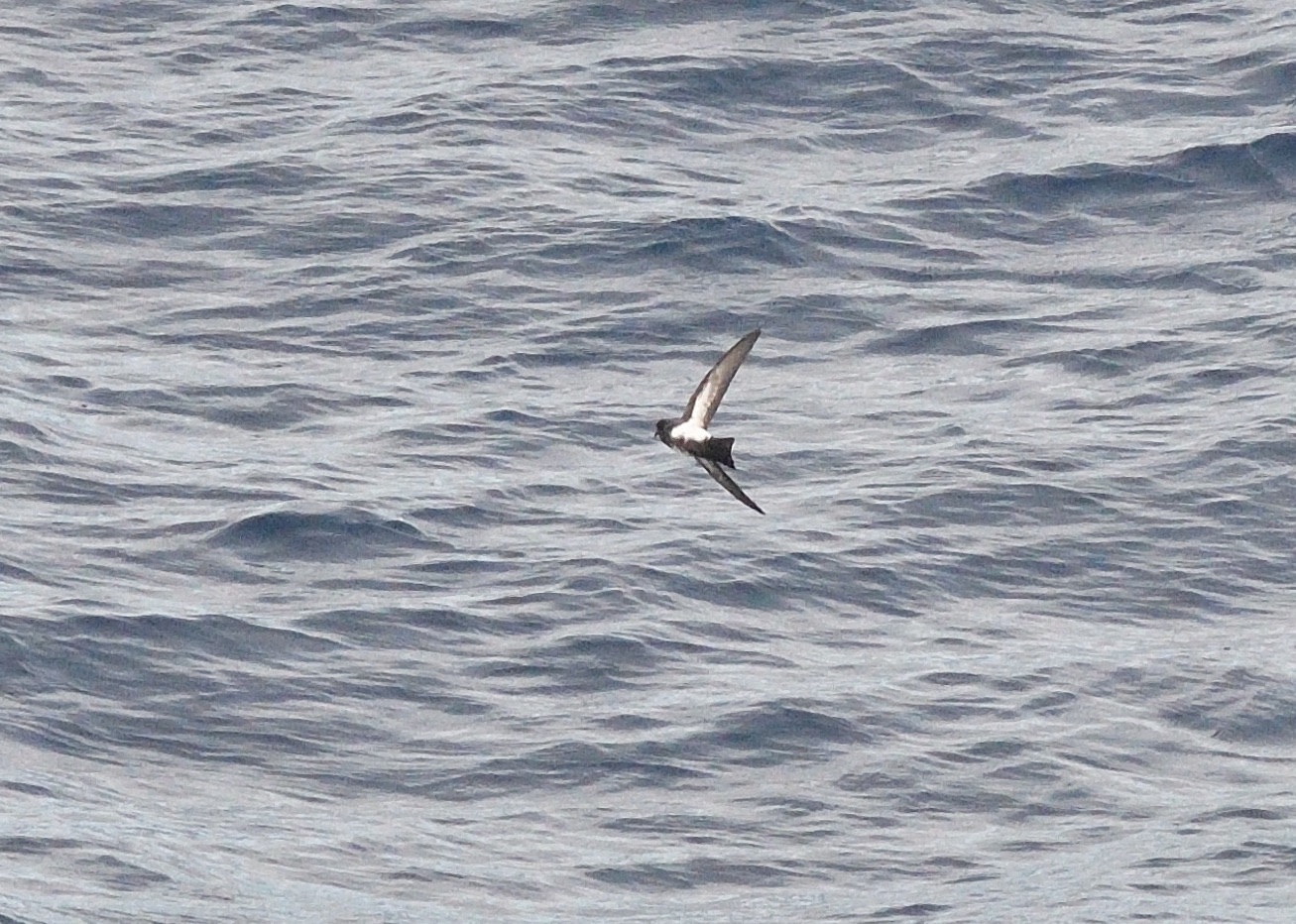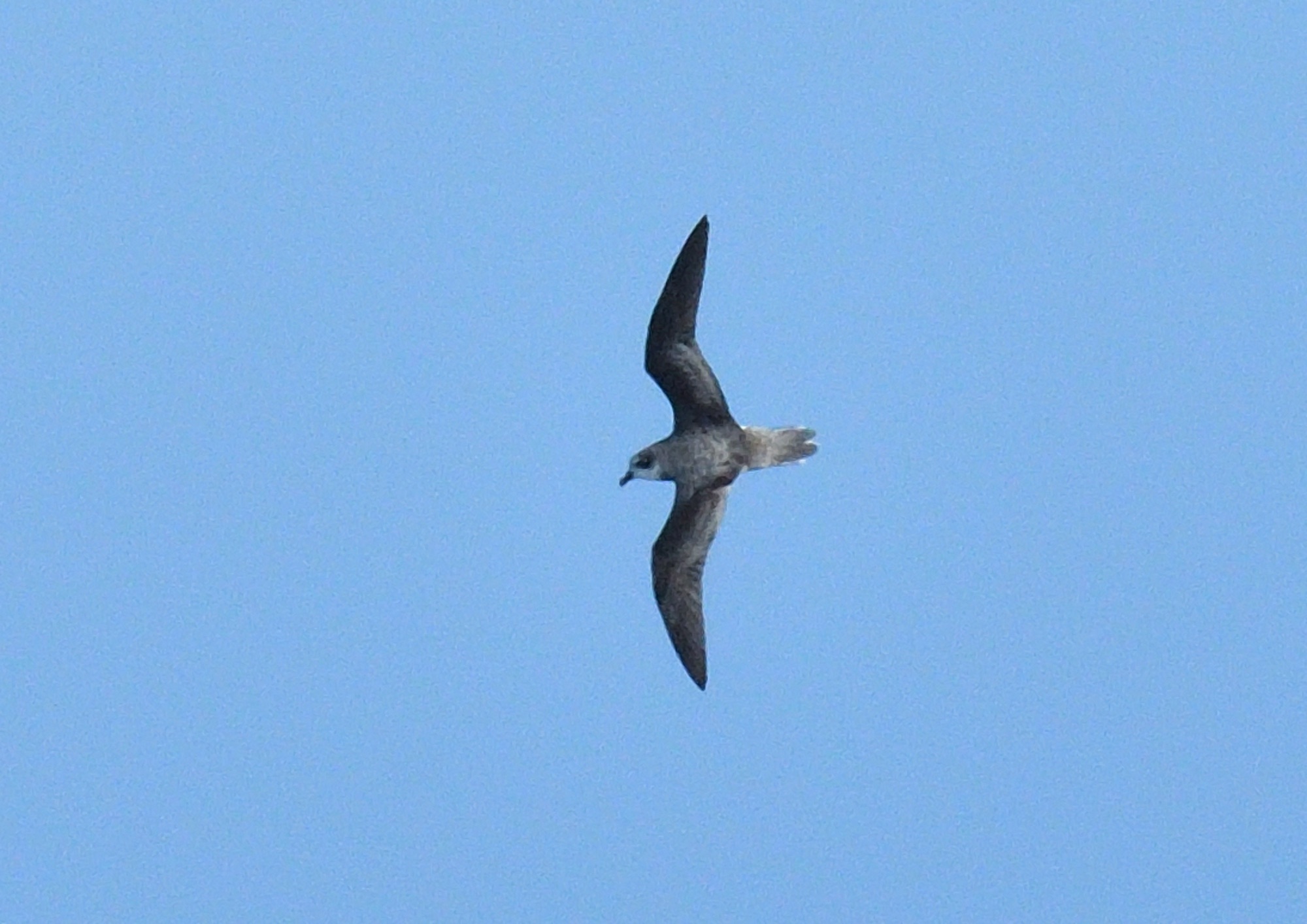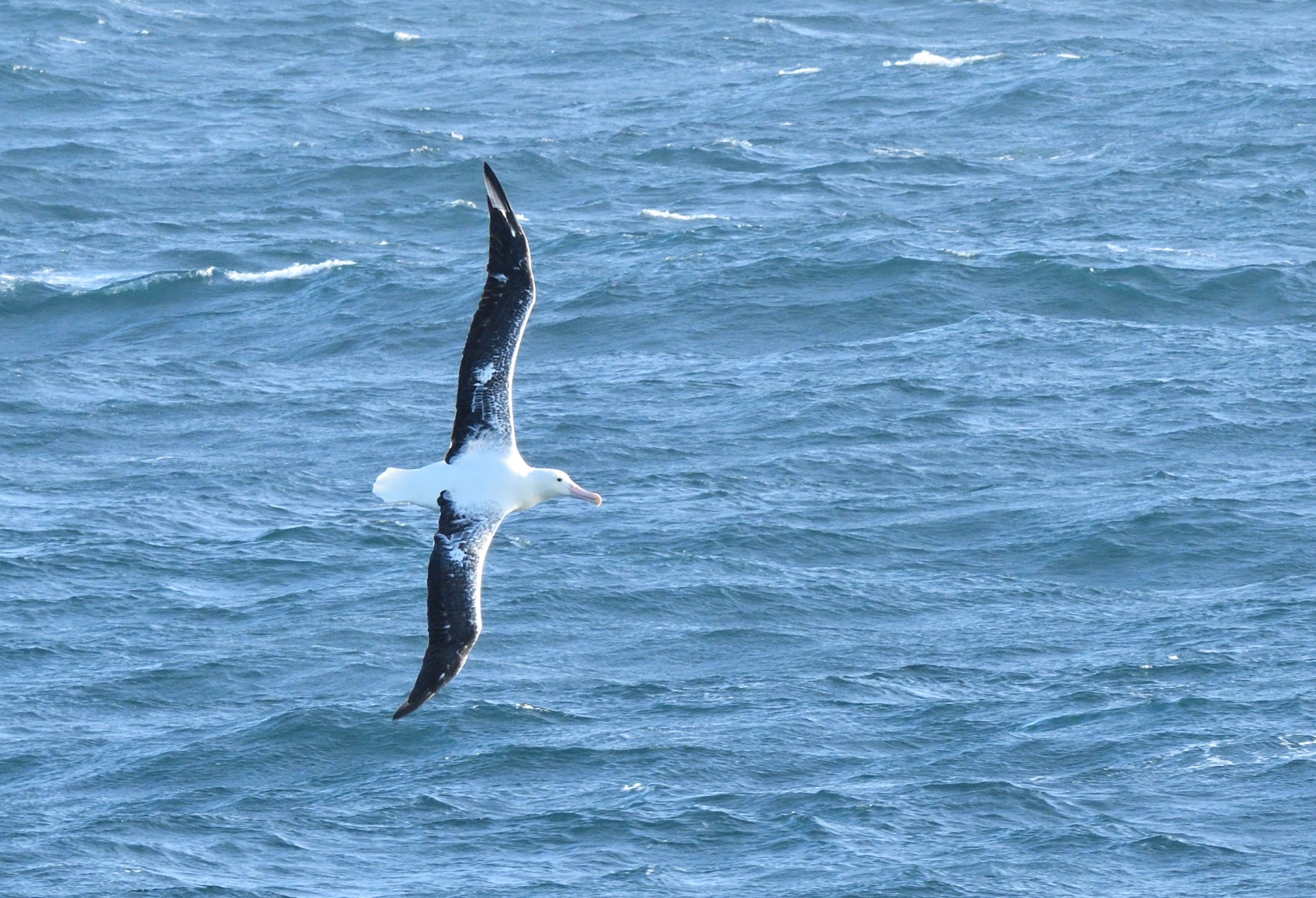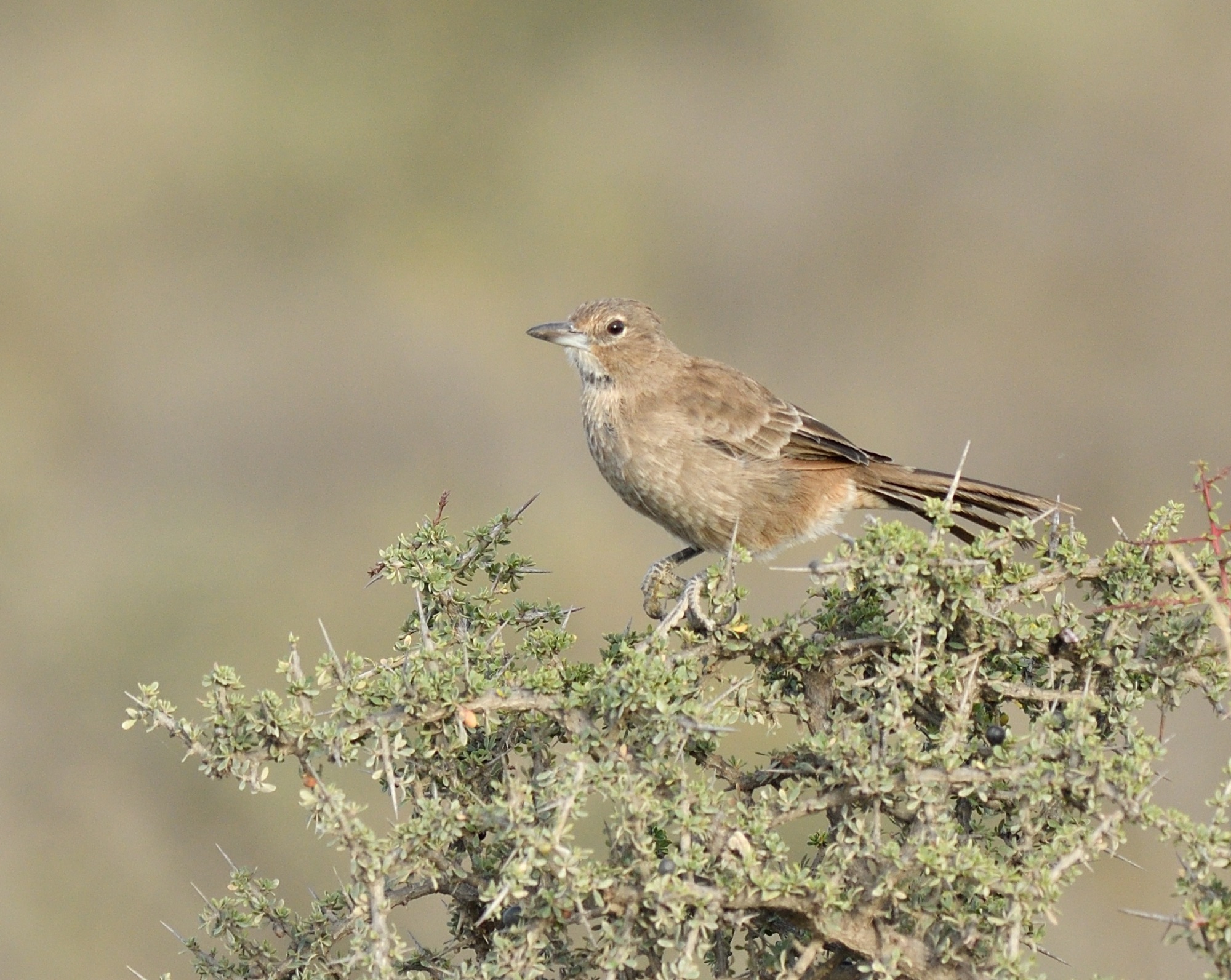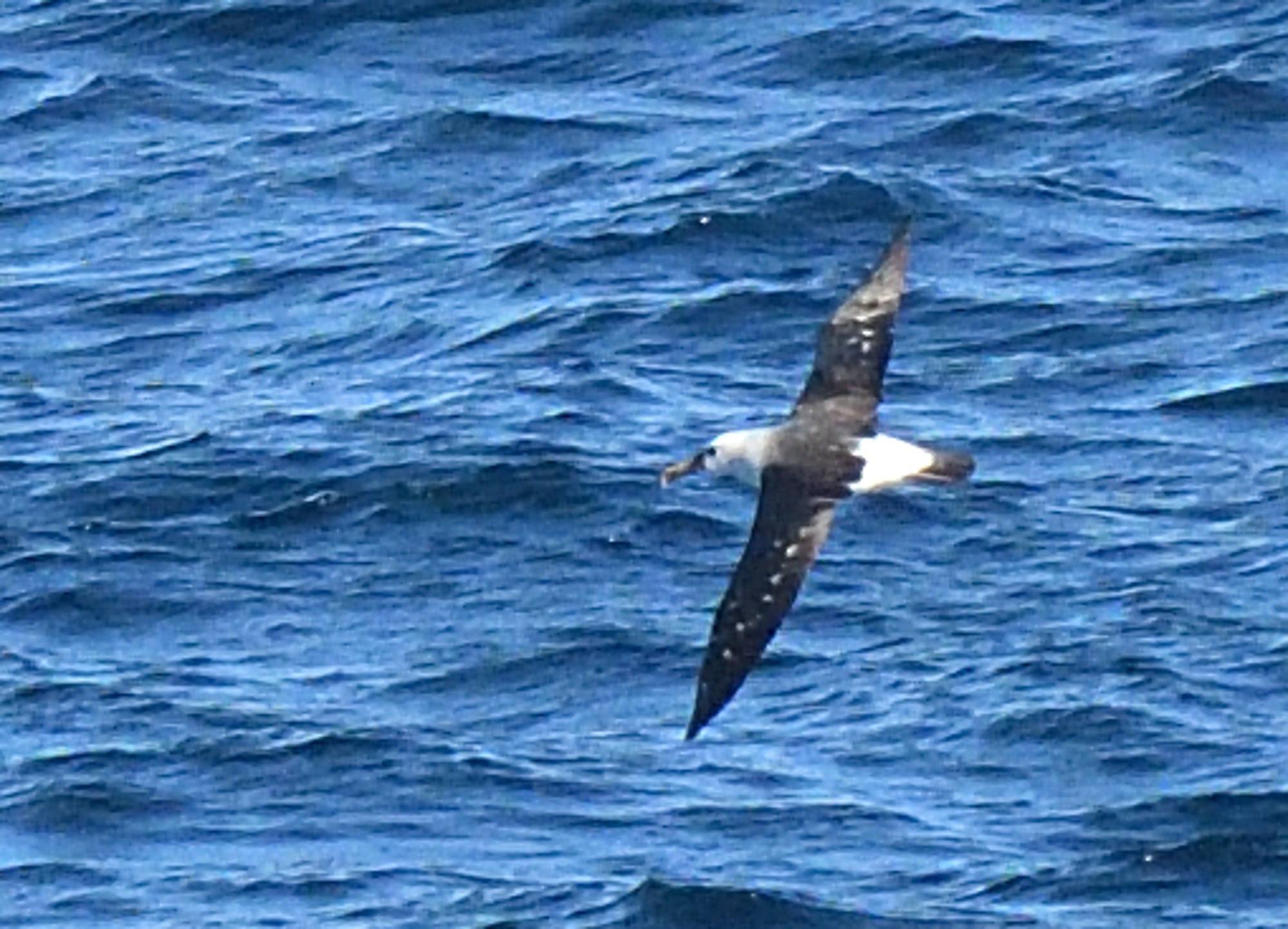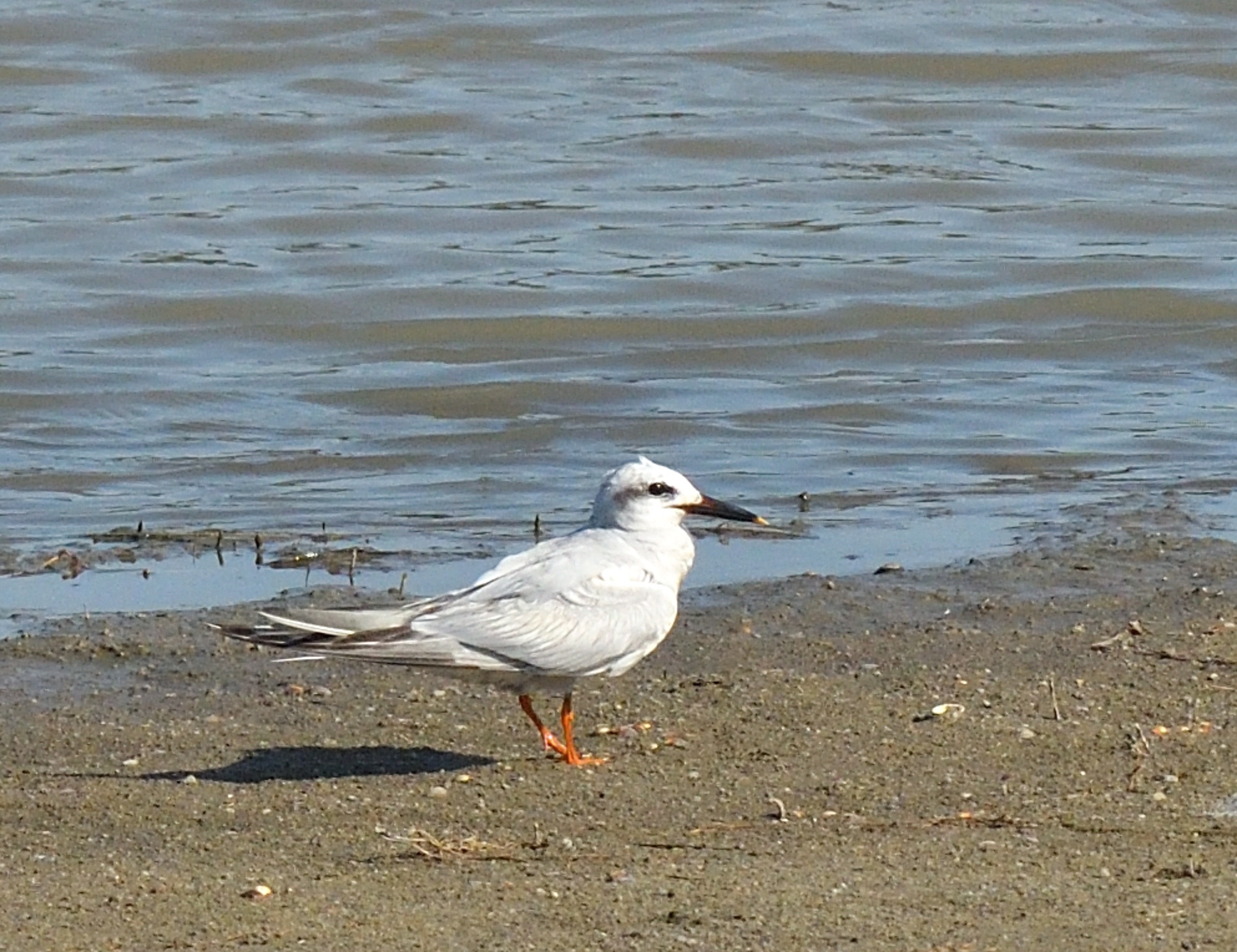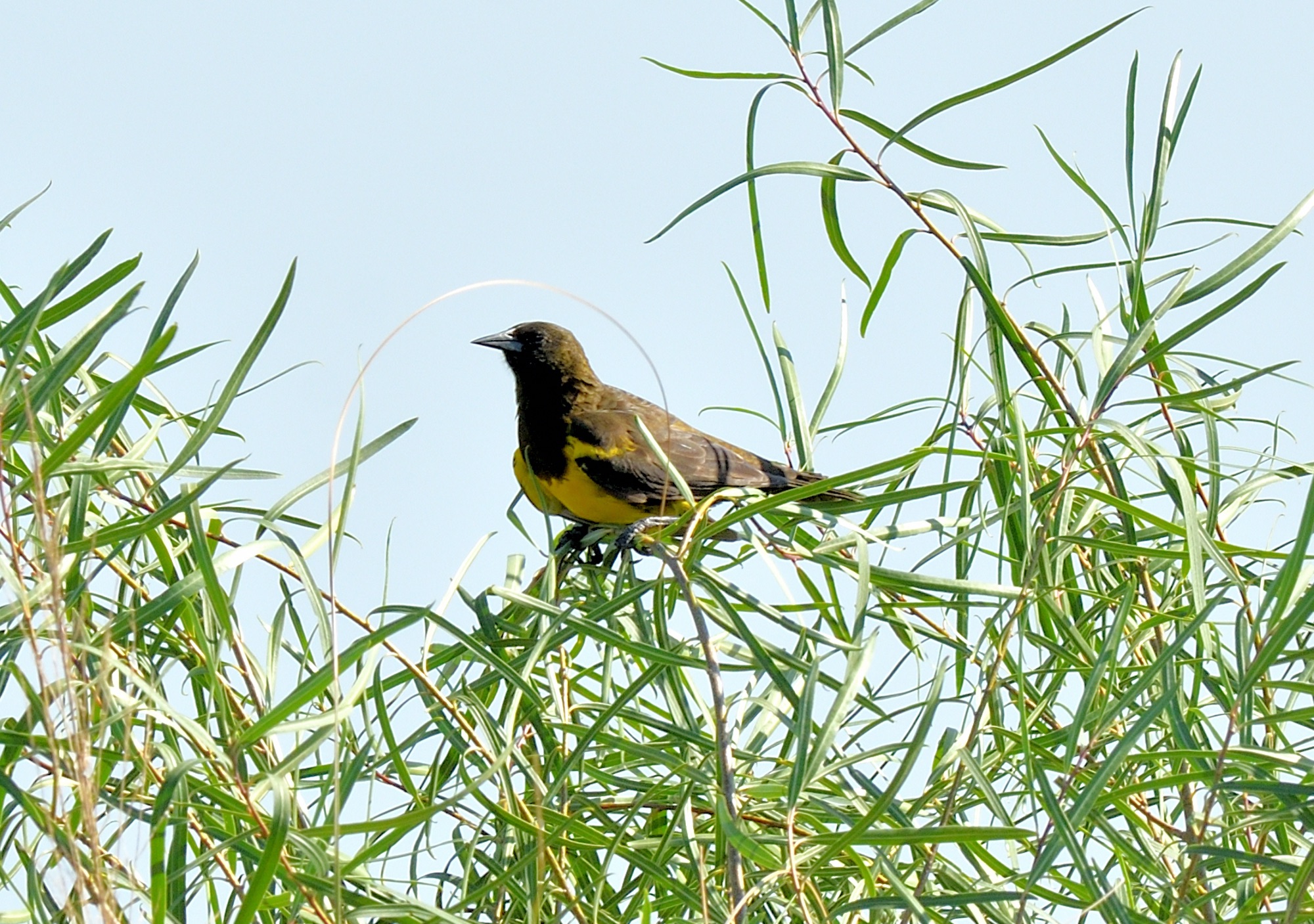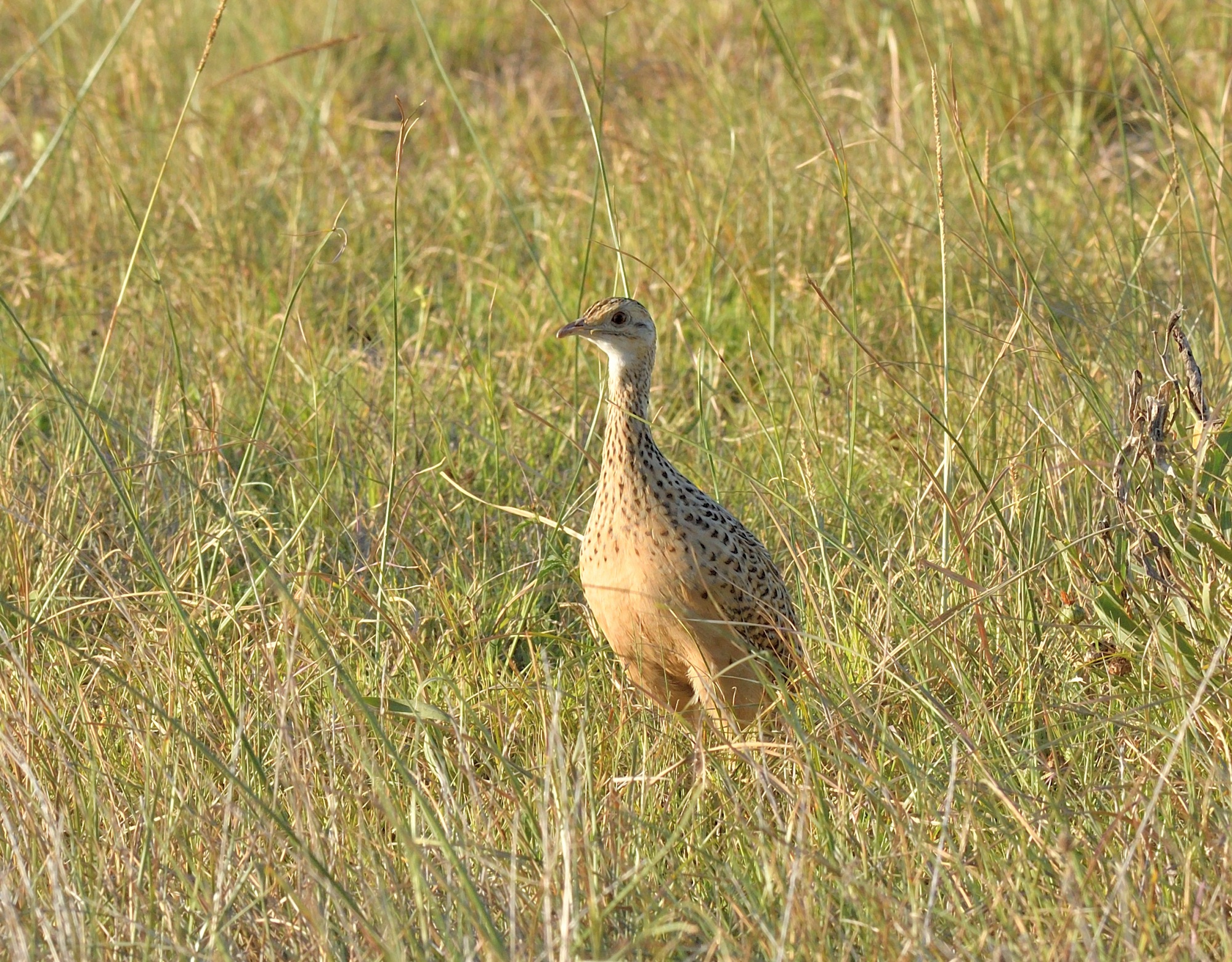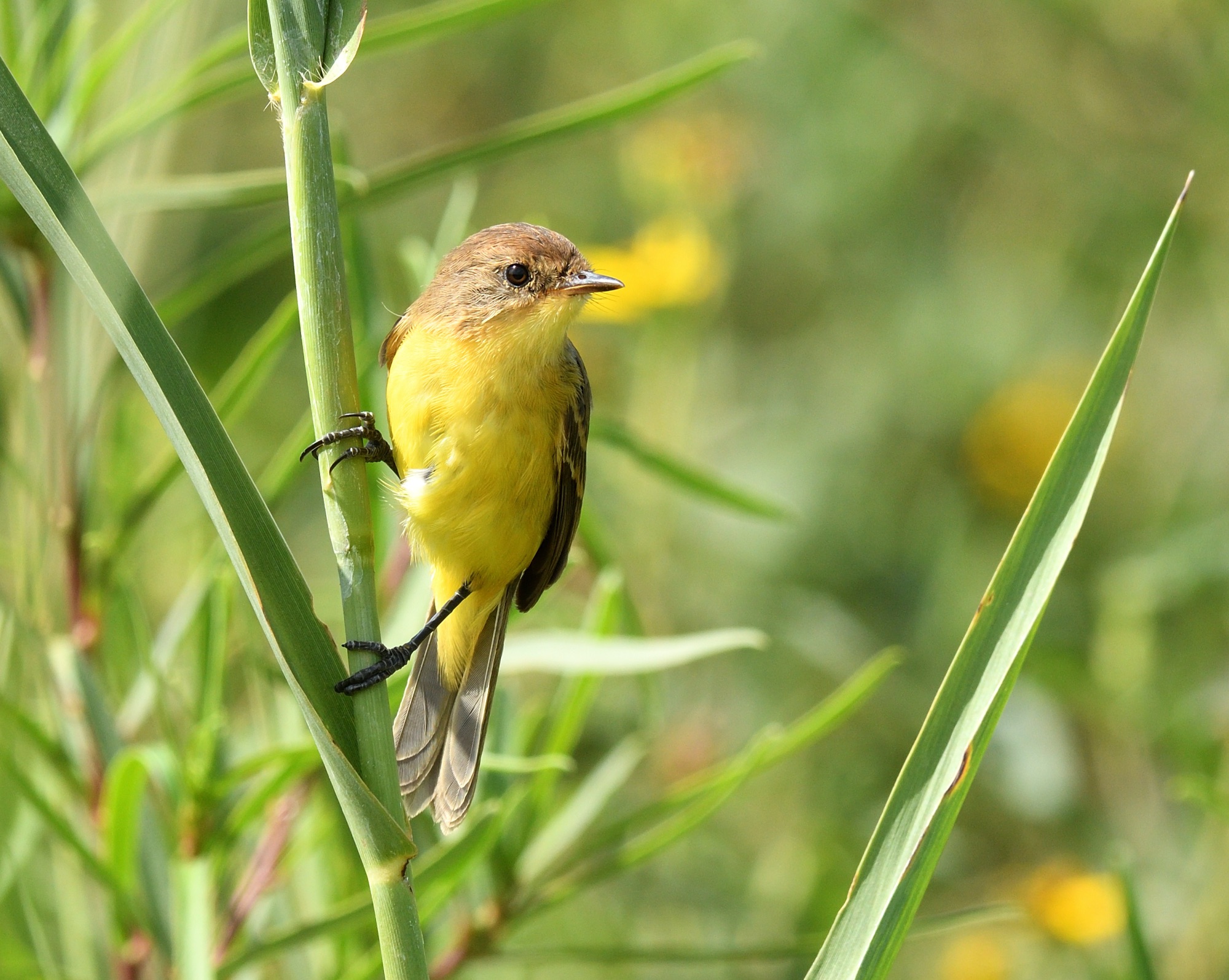EPIC CAPE HORN CRUISE TOUR REPORT 2023 Pre-cruise extension: 17th - 19th February Main Cruise: 19th February - 5th March Ceibas post-cruise extension: 5th - 8th March
Day 0 ARRIVAL DAY
After last night’s overnight flight to Santiago, Chile we arrived this morning and checked I to the Holiday Inn Hotel based at the airport. It had been a long haul getting here but we’d made it and as this was purely an arrival day we of course went birding. Laguna Caren is only a 15 minute taxi ride away and we spent a pleasant couple of hours wandering along the shoreline. We didn’t expect too much as it was early afternoon and rather hot & windy but we ended up doing pretty well. An easy walk scanning the lagoon and surrounding bushes began with a pair of Diuca Finches flying into a nearby tree, with Picui Ground-Doves and West Peruvian Doves also being noted early on. A Variable Hawk patrolled a hillside, whilst a few Chilean Swallowsflew overhead. A pair of Striped Woodpeckers gave close views in some leafy small trees and a Chilean Elaenia appeared briefly, plus a few Neotropic Cormorants were noted flying over the water. The strong wind certainly didn’t help us but definitely kept the temperature bearable, and it really didn’t bother a Giant Hummingbird perched right on top of a dead tree. A large open field held a pair of Long-tailed Meadowlarks and up to 8 Southern Lapwings too. At a bend in the lagoon we scoped a few Great Grebes, with an adult and 3 large chicks being seen. As we scanned the far bank a White-winged Coot was spotted, followed by several Red-fronted Coots, some Yellow-billed Teal were present and further scanning revealed at least 4 Yellow-billed Pintails, a Cocoi Heron and a Snowy Egret. We kept on scanning and eventually a Plumbeous Rail was seen and on the walk back a pair of Plain-mantled Tit-Spinetails, so a pretty satisfactory couple of hours. With a few hours still spare before dinner a few of us headed into downtown Santiago and visited Sky Costanera, the tallest building in South America and gives superlative views across Santiago. It was a perfect end to our first day in amazing Chile and we celebrated with some local beer and mojitos!
PRE-CRUISE EXTENSION Day 1 EL YESO VALLEY
What better way to start the day than with a female Torrent Duck giving close views along the Maipo River? Also here were a few Chilean Elaenias, several Chilean Mockingbirds, Austral Thrush and Tufted Tit-Tyrant. Our next stop along the Yeso Road was at stakeout for the endemic Crag Chilia where a pair showed well after a little wait, along with the endemic MoustachedTurca that flew in and scuttled away up the hillside, and a Black-chested Buzzard-Eagle flew low over our heads. We left here and drove higher up, stopping at a bend in the road where numerous flowering bushes were attracting several stunning White-sided Hillstars and we enjoyed very nice views as they fed on nectar right in front of us. Getting a good photo proved difficult but we contented ourselves with simply watching all of the action, and as if that wasn’t enough we had superb scope views of another Moustached Turca feeding on a lizard on the slope above us.
Another short drive higher up the road saw us scoping over 50 Andean Condors feeding on a carcass on a distant hillside. It was an unbelievable sighting and it was hard to leave here! Our next stop produced several Grey-hooded and Mourning Sierra-Finches, an extremely confiding Rufous-banded Miner and a group of distant Mountain Parakeets were scoped. Beyond the reservoir we searched for Diademed Sandpiper-Plover without joy, but did get a few Grey-breasted Seedsnipe, White-browed Ground-Tyrant, Plumbeous Sierra-Finch, many Greater Yellow-Finches, Dark-bellied and Buff-winged Cinclodes, Yellow-rumped Siskin, and a small group of Andean Goose. The next marsh gave us the Holy Grail of DSP, which we watched for ages and a flyby Black-billed Shrike-Tyrant.
It was around this time the final member of our group, David H, managed to catch up with us in a taxi and we revisited many of the previously seen species. Our final stop of the day also gave us our first Rufous-tailed Plantcutter and some exceptionally close Mountain Parakeets to round off a fine day in the Andes.
PRE-CRUISE EXTENSION Day 2 FARELLONES
This morning we left the hotel at 6.30am and headed around an hour to the start of the winding road up to approx. 3,000m to the ski resort at the top. We had a pair of Moustached Turcas on the road in front of us giving mind-blowing views, even when we all piled out of the minibus and started clicking away with cameras… Wow! Just up around the corner several Black-chinned Siskins were hanging around roadside telegraph wires, prompting another quick vehicle exit. There was also a close and I mean close, Black-billed Shrike-Tyrant, we scoped a Great Shrike-Tyrant, had another Rufous-tailed Plantcutter, saw many Grey-hooded Sierra-Finches, more Rufous-banded Miners, and our first Band-tailed Sierra-Finches. Not too far away we had a nice hour or so walking along a dirt track where we found a pair of Scaly-throated Earthcreepers, a close Cordilleran Canastero and eventually we tracked down 2 pairs of Sharp-billed Canasteros.
Leaving here we drove up to the ski resort right at the top of the road where we enjoyed nice close views of several Andean Condors flying overhead. There was also Aplomado Falcon, several Mountain Caracaras and a pair of Spot-billed Ground-Tyrants. Dan explored up the hill and found Creamy-rumped Miner but despite everyone searching for this species we had to give it up and go for lunch.
Dropping lower down for lunch we were all amazed when a White-throated Hawk flew in and landed in a large tree next to us! Wow again! A few Plain-mantled Tit-Tyrants were in nearby trees as well. Driving much lower we found our first Austral Blackbirds along the roadside, and a Chilean Tinamou was seen briefly. We then spent the last couple of hours trying in vain to find a White-throated Tapaculo before returning to the hotel for 6.15pm.
PRE-CRUISE EXTENSION Day 3 TO THE COAST & CRUISE DAY 1 We left Santiago early doors and headed to the coast some 90 minutes away to a shoreline called Renaca, which is north of Valparaiso. Our main target of Chilean Seaside Cinclodes fell almost immediately and nice views were had of a couple pairs along the rocky coastline. But there was so much activity it was hard to know where to look first, with Peruvian Pelicans, Peruvian Booby, several Inca Terns, a flock of Surfbirds, a few Blackish and many more American Oystercatchers, Hudsonian Whimbrel, Ruddy Turnstone, Neotropic Cormorant, a few Red-legged Cormorants and masses of Kelp Gulls. Just around the corner Inca Terns were almost within touching distance and brought the wow factor to proceedings, a flock of Franklin’s Gullswere seen on the beach and finally a group of Grey Gulls were found just before boarding the minibus.
Moving on to Estero Mantagua we searched for Stripe-backed Bittern in vain but had Many-coloured Rush-Tyrant, Wren-like Rushbird, Red-fronted and Red-gartered Coots, Spectacled Tyrant, a superb Spot-flanked Gallinule, Magellanic Snipe, many West Peruvian Doves, Fire-eyed Diucon and a pair of displaying Green-backed Firecrowns. Some familiar shorebirds were present with both Greater and Lesser Yellowlegs, and a flock of Baird’s Sandpipers. We finished off with brief looks at Dusky Tapaculo and Austral Negrito before having to leave.
Our final spot was Quirilluca where we nailed the endemic Dusky-tailed Canastero quickly and had views of Green-backed Firecrown, Tufted Tit-Tyrant, another Moustached Turca, Chilean Mockingbird, Long-tailed Meadowlark and Picui Ground-Doves, but failed to find White-throated Tapaculo.
All that remained was a 2 hour drive to the port of San Antonio to catch our cruise ship Sapphire Princess and the real start of our Cape Horn Cruise adventure! Upon arrival, check-in was a breeze ( we needn’t have bothered with QR Codes or Green Lane authorisation on the App!) and we were onboard by 4.15pm and had time to mooch around the ship and everyone could explore a little bit. The buffet was enticing to everyone and that was when Lynzi showed us a photo of a pale grey petrel sat on one of the decks that she and David T had found. We all rushed to see it and spent a good while figuring out that it was in fact a rare Masatierra Petrel. Wow! Unfortunately, our departure was delayed an hour and was pretty frustrating but in the meantime we saw an Inca Tern, Guanay Cormorant and some Peruvian Pelicans, with distant Elegant Terns fishing way out and David T even saw Humboldt Penguin in the harbour. Eventually our cruise ship was being pulled out of its mooring by a couple of tugboats and we were heading out into open water, passing many South American Terns along the way, plus Franklin’s Gulls and a few SouthAmerican Sealions. Once we’d left the sheltered port, the first of 5 Arctic Skuas appeared, along with a few Peruvian Boobies. And then everything went quiet and we wondered if that was it for the day. However, all of a sudden a Pink-footed Shearwaterappeared, and then another, followed by a couple of Sooty Shearwaters, more pinkfeet, and then a smaller shearwater with faster wingbeats – unbelievably it was a Manx Shearwater (in the Pacific Ocean!). it was only the second time I’d seen one in this part of the world! And then it all kicked off with a flurry of more shearwaters, and then the shout of “ALBATROSS” went up and our first couple of Black-browed Albatrosses were seen. As if this wasn’t enough, a Buller’s Albatross flew by and shortly after a very close Chatham Albatross was spotted sat on the sea really close to the ship. As we neared it, the bird flew away a short distance and settled on the water once again allowing a few record shots. More shearwaters of both species appeared, and then our first of several Fuegian (Wilson’s) Storm-Petrels appeared, and Keith even managed a view of a Peruvian Diving-Petrel. Events only came to an end when the light faded too much but we still managed a few close Sooty Shearwaters before close of play. What a day! And what was pleasing to everyone was that the views we were getting of these seabirds were very, very good. We had scopes set up and could scan the horizon but many of the birds seemed to want to pass close in front of the hull. Amazing! So this was our first evening onboard a cruise ship and we had dinner in the large buffet area, where an amazing variety of different dishes was available. A few of us retired to one of the numerous bars a little later to toast the day’s successful sightings but I think no-one was too late in bed as tomorrow promised to be epic!
CRUISE Day 2 AT SEA
This proved to be an absolute epic day as we sailed south towards Puerto Montt. Take a look at the list and numbers of each species seen. I have only noted species seen less than halfway to the horizon but when I scoped into the distance the sea was alive with birds all through the morning and you can multiply the numbers given by 5x, 10, 20x for a truer picture of total numbers. Highlights were White-bellied Storm-Petrel, a single White-faced Storm-Petrel, and seeing 7 species of Albatross.
Standing on deck, scopes out, coffee in hand, watching all of these seabirds.......... things don't get any better than that!
Here's a list of species seen today:
42 Fuegian Storm Petrel
4 White-bellied Storm Petrel
1 White-faced Storm Petrel
4 Wandering (Snowy) Albatross
33 Southern Royal Albatross
5 Northern Royal Albatross
83 Black-browed Albatross
19 Salvin’s Albatross
3 Grey-headed Albatross
6 Buller’s Albatross
2 Juan Fernandez Petrel
Masatierra (DeFilippi’s) Petrel
17 Stejneger’s Petrel
19 White-chinned Petrel
11 Westland Petrel
1400 Sooty Shearwater
300 Pink-footed Shearwater
1 Manx Shearwater
2000+ Grey Phalarope
4 Northern Giant Petrel
CRUISE Day 3 PUERTO MONTT
We woke up to calm waters in the sheltered fjord-like scenery as we were moored off Puerto Montt. Leaving the ship in a tender was a relatively easy affair and we were ashore by 8.15pm. We met our local guide Raphael and headed to the private forest of Las Cumbres, seeing several Black-faced Ibis, Southern Crested Caracara and Southern Lapwings along the way. Once we were parked up, a pair of Chilean Pigeons flew over and one landed in a bare tree nearby, giving nice scope views and a flock of Grassland Yellow-Finches fed on the track in front of us as we walked across a field into the forest. We followed a narrow trail inside this amazing forest and had great views of a couple endemic Chucao Tapaculo’s. The first one walked along a moss-covered log lying on the forest floor but the second individual fed around the base of a tree for several minutes, allowing awesome views. A few of us also had an endemic Black-throated Huet-Huet as well in the same area but it didn’t hang around very long. The lack of recent rain and dry conditions did not help our chances of seeing either of the other two endemic tapaculos, although we did hear Ochre-flanked Tapaculo later on today. Anyway, our walk through the forest also produced a mixed flock of Thorn-tailed Rayadito and White-throated Treerunners, plus a close Green-backed Firecrown. Leaving here we headed over to Lahuen Nadi National Park and another forested trail where some of us saw the endemic Des Mur’s Wiretail and we then drove to another site to try and get better views of the wiretail and also saw a Tufted Tit-Tyrant. A meandering drive across the countryside in search of flickers produced a pair of Slender-billed Parakeets to round off our first land-based shore excursion of the cruise. Once back aboard the Sapphire Princess we were out on deck enjoying our first Imperial Cormorants, as well as Brown-hooded Gulls and South American Terns.
As we sailed along the scenic channel towards the Gulf of Corcovoda we saw a few Humboldt Penguins and eventually we saw our main target – 9 Pincoya Storm-Petrels. This species is only found in this small area of Chile and we were extremely fortunate to see them.
We also had:
13 Westland/White-chinned Petrels
98 Pink-footed Shearwaters
70 Black-browed Albatross
2 Chilean Skua
1 Pomarine Skua
CRUISE Day 4 AT SEA
Spent the day at sea sailing south and turned up an amazing tally of seabirds today. The recent rough weather elsewhere must have pushed a few different species our way as you will see…
But what is really brilliant are the views you get from the ship and also that we could use our scopes as well. In between all of the activity, we took it in turns to go indoors to get a coffee and food, snacks, and more food, lunch, more coffee...... You ge the picture! And it was a long day of seawatching from sunset at 07:40 to sunset at 8pm, but what a day!
Here's today's list:
1000+ Sooty Shearwater
18 Pink-footed Shearwater
1 Manx Shearwater
8 Westland Petrel
34 White-chinned Petrel
64 Westland/White-chinned Petrels
260 Fuegian Storm-Petrel
1 Grey-backed Storm-Petrel…..!!!!!
4 White-faced Storm-Petrel
30 Southern Giant Petrel
6 Northern Giant Petrel
70 Giant Petrel sp.
27 Stejneger’s Petrel
1 Juan Fernandez Petrel
2 Gould’s Petrel…!!!!!
8 Chilean Skua
2 Common Diving-Petrel
22 Snowy Wandering Albatross
2 Antipodean Wandering Albatross
17 Salvin’s Albatross
147 Black-browed Albatross
2 Grey-headed Albatross
6 Southern Royal Albatross
2 Northern Royal Albatross
6 Imperial Shag
It was certainly an epic day.
CRUISE Day 5 AMALIA GLACIER - AT SEA
We woke this morning in another scenic wonderland at the Amalia Glacier, surrounding by mountains covered in forest. It was light just after 7.15am and we were out on deck in the cool early morning air. The ship remained at the glacier for 90 minutes before heading back out towards the open ocean. It took until 2pm to reach the Pacific Ocean but along the way we found 5 Flightless Steamer-Ducks, 4 Magellanic Penguins, 15 Magellanic Diving-Petrels, 250 Fuegian Storm-Petrels (with one on deck) and 4 Chilean Skuas.
We had only been in the ocean for a few minutes before we found an absolutely awesome White-headed Petrel that gave a couple of passes in front of the ship. This has been confirmed as the first record for Chile! Wow! The rest of our journey until we finished was in a really rough sea which produced our first Slender-billed Prions right in front of the ship. Numerous Fuegian Storm-Petrels were passing, there was a single Snowy Wandering Albatross and Southern Royal Albatross, 102 Black-browed Albatross, lots of Sooty Shearwaters, many Southern Giant Petrels, over 30 White-chinned Petrels and 7 Grey Phalaropes.
CRUISE Day 6 PUNTA ARENAS
Arriving in Punta Arenas at 7am we were on the first tender and landing at the dock by 8am where our first Dolphin Gullslounged on the quay. A Dark-bellied Cinclodes was also seen under our minibus when we met our excellent local guide Claudio Vidal. Heading along the coastal road we stopped at some pools where Chilean Flamingo’s, Chiloe Wigeon and Red Shovelerswere seen. Many Upland Geese were dotted around the area, along with a few Black-faced Ibis and a couple of Coscoroba Swans. After a short drive further along the coastal road we stopped to view a gathering of Flying Steamer-Ducks and we were lucky to spot a pair of Flightless Steamer-Ducks perched on a rock together. There was also a Rock Shag, many Imperial (King) Cormorants here as well, along with a pair of Crested Ducks and even a few Peale’s Dolphins.
We then headed inland, seeing lots of Lesser (Darwin’s) Rhea’s and drove to a large lake. Here we found the key species of our day, Magellanic Plover, although it took some searching in the strong winds. Also here were a few Two-banded Plovers, a flock of Patagonian Yellow-Finch, Austral Negrito and several White-rumped Sandpipers and Chilean Skuas gave close views. Heading further inland for around 90kms we found 100’s of Least Seedsnipe, over 50 Tawny-throated Dotterels, Common Miner, Scale-throated Earthcreeper, Correndera Pipit, more Two-banded Plovers and eventually a couple Rufous-chested Dotterels. A small wetland held a few Ashy-headed Geese, Chiloe Wigeon, as well as numerous Upland Geese. Leaving here we saw many more Lesser Rhea’s and Guanacos, some fox thing as well before heading back to the port and our cruise ship.
Once aboard, we had time to get some food from the buffet restaurant and grab a nice coffee before meeting on deck. Our view from the very front of the ship is superb and as we sailed along the Magellan Straits we enjoyed pretty decent views of a few Magellanic Diving Petrels, 23 Black-browed Albatross, 2 Southern Giant Petrels and a couple of Magellanic Penguins to round off a brilliant day. Oh and we had some distant views of another wacky pteradroma species as well…..
CRUISE Day 7 USHUAIA
We sailed through the Beagle Channel to the most southerly town in the world of Ushuaia, surrounded by snow-capped mountains and looking as beautiful as I remembered it form my first visit in 2009. Along the Beagle Channel to the west of Ushuaia Michel picked up a group of Andean Condors perched by the shoreline on a small island and the views through scopes were very nice indeed! There was also Magellanic Oystercatcher, Kelp Goose, Magellanic Diving Petrels, Magellanic Penguins, even a couple distant Snowy Sheathbills, and a few Chilean Skuas.
The sailing in to the port was very scenic and as we neared the town we were very fortunate to spot a King Penguin on a rocky beach absolutely dwarfing the Imperial Cormorants and Dolphin Gulls alongside it. With members of the group dispersed and preparing for our next shore excursion our WhatsApp group announcements certainly helped and eventually everyone saw it and enjoyed decent scope views from the front deck. With that excitement boding well for a good day ashore in Tierra del Fuego National Park we met up with our local guide and set off in a minibus into the national park. Our first stop was at a forest trail where we walked for around a kilometre hoping to find Magellanic Woodpecker….. but we didn’t. On return to the minibus we met a Danish birder who had seen a pair of woodpeckers along the same trail but a little further on, so we walked back up the hill and down the other side. Well, we met at least 3 other groups of walkers who had all seen woodpeckers and we staked out the area for a good while, but it was apparent that the birds had moved on. Unbelievable! So we walked a different trail, drove to a lake and walked a bit more, drove to another spot and walked some more. All futile! I may well be the only birder to visit here on two separate occasions and dip the woodpecker! I cannot explain our miss except to say we were extremely unlucky. We did see some Chiloe Wigeon, Thorn-tailed Rayadito, White-throated Treerunner, Flightless Steamer-Duck, Upland Goose, Blackish Oystercatchers, Great Grebe, Chilean Elaenia, Tufted Tit-Tyrant, Fire-eyed Diucon, Austral Thrush, Patagonian Sierra-Finch, and even a Culpeo Fox. So we ended our birding at the nearby landfill site and ticked the localised White-throated Caracara, which was a nice way to end our time in Ushuaia.
Back on board Sapphire Princess, the usual procedure of getting a bite to eat and a coffee pre-empted our anticipated departure from port and everyone was on deck. The captain then made an announcement that high winds would delay our departure, so that meant we had some down time to enjoy onboard facilities, visit a few bars onboard and generally relax!
CRUISE Day 8 CAPE HORN ONWARDS
We left Ushuaia port well after midnight due to high winds and several hours later than scheduled and we woke around 3 hours north of Cape Horn, our destination this morning. Unbelievably this normally rough Southern Ocean was extremely calm and unfortunately rather quiet with just a few Black-browed Albatross and Sooty Shearwaters for company. As we neared the Cape more and more of the same two species appeared before we began the journey north-east towards The Falklands. This is very deep water and not conducive to good seabird movements or observations, so we all took plenty of ‘time off’ up until around 5pm when things really kicked off. First of all we had a superb Black-bellied Storm-Petrel along the starboard side of the boat, which not everyone managed to get on. And a little while later a couple Cape Petrels flew by. But we had a better and much closer individual a bit later that even lingered long enough for a couple quick record shots. But the most amazing sighting was of a Sooty Albatross that flew around 200m from right to left and right across in front of us. And this most extraordinary sighting pre-empted an absolute albatross-fest, with maybe over 150 individuals of mainly Southern Royal Albatross, but with the some Snowy Wanderers and the extremely common Black-browed Albatross in amongst them all in view at one time. It was a fantastic experience to see the sea alive with these magnificent birds, undoubtedly drawn in by a nearby fishing vessel.
So today’s totals:
210 Black-browed Albatross
19 Snowy Wandering Albatross
95 Southern Royal Albatross
1 Grey-headed Albatross
110 Fuegian/Wilson’s Storm Petrel
2 Black-bellied Storm Petrel
45 Southern Giant Petrel
6 Northern Giant Petrel
2 Cape Petrel
575 Sooty Shearwater
75 White-chinned Petrel
4 Westland Petrel
200+ White-chinned/Westland Petrel
100+ Imperial Cormorant
CRUISE Day 9 SAILING PAST THE FALKLAND ISLANDS!
Yes, we should have been in the Falkland Islands ticking Falkland Steamer-Ducks, visiting the penguin colony at Volunteer Point etc etc. But our captain i his infinite wisdom decided the weather was too rough to dock, even without consulting the port authorities in Port Stanley. So the captain informed us that we would sail towards our next port of call at Puerto Madryn very slowly. Anyway, what can you do apart from carry on sea-watching and it did prove to be rather productive with a count of 55+ Soft-plumaged Petrels today. In August 1988 as a 20 year old manic twitcher I was sea-watching at Porthgwarra when Peter Harrison uttered those immortal words “SOFT-PLUMAGED PETREL” and this was, at that time, possibly my most exciting moment as a birder. Subsequently this Pterodroma complex has been split into several species and I’ve been fortunate to see Desertas Petrel & Zino’s Petrel over the past few years. And so Soft-plumaged Petrel remained a mythical being for me as it inhabited the far away South Atlantic Ocean. That was until today when this species was our constant companion all day as we sailed north towards the Argentinian coast.
Other keynote species from today were a single Subantarctic Shearwater that just Dan and I saw, 1 probable and 1 confirmed Blue Petrel, 8 Slender-billed Prions, and some extremely acrobatic Peale's Dolphins.
Today’s count:
3 Southern Royal Albatross
12 Great Shearwater
1 Subantarctic Shearwater
1 Blue Petrel
55 Soft-plumaged Petrel
15 Southern Giant Petrel
8 Slender-billed Prion
3 Brown Skua
CRUISE Day 10 AT SEA
A rather quiet day as we continued our slow sailing towards the Argentinian coast and Puerto Madryn. The undoubted highlight being our 3 Grey Petrels seen at various stages throughout the day. So most of us took advantage of a fully working cruise ship at some stage today, and to be honest, it's not a bad way to spend a day!
Today’s Totals:
5 Southern Royal Albatross
20 Black-browed Albatross
3 Grey Petrel
7 Southern Giant Petrel
9 White-chinned Petrel
8 Great Shearwater
12 Sooty Shearwater
4 Brown Skua
CRUISE Day 11 PUERTO MADRYN
This was truly an epic day ashore as we docked in Puerto Madryn, Argentina. Once we were allowed to walk off the ship, we found it to be a fairly long walk along the pier to our waiting minibus. Along the way we saw Great Grebes and several numerous & very close South American Terns. Our first stop was just along the coast a few minutes away to view a high tide roost of gulls and shorebirds, but not the hoped for (and definitely a long shot) Chubut (White-headed) Steamer-Duck that had been reported a few days ago. We just saw some Crested Ducks, American and Blackish Oystercatchers, Grey-hooded Gulls etc etc. Moving north towards the Valdes Peninsula we made a few quick stops to view Variable Hawk, Chalk-browed and Patagonian Mockingbirds, Southern Martin and Chiguanco Thrush. Veering inland slightly we entered steppe country covered in bushes and pulled up beside an isolated house. There were several Elegant Crested Tinamous present and we had nice views of these and a couple more over the next hour. As well as this superb species, one of the non-avian highlights for some in the group was the Lesser Cavy! However, we were here for one special bird – White-throated Cachalote, an Argentinian endemic. It took a while to locate it but with the breeding season over, I think we were extremely fortunate to get the crippling views we did. What a bird! So, moving on we had Rufous Hornero, Burrowing Owl, Harris’s Hawk and other common species before arriving at a lake in Trelew, about an hour south of the port. This was choc full of waterbirds and we thoroughly enjoyed sifting through all the ducks and other goodies present. The main stars for ‘duck’ enthusiasts comprised Black-headed Duck, Lake Duck, Red Shoveller and Yellow-billed Pintail, with many White-tufted and just a couple of Silvery Grebes also in the mix. All three species of coot were here: White-winged, Red-fronted and Red-gartered Coot, and we saw them all at close quarters. At the far end a few Chilean Flamingo’s were largely ignored in favour of Picui Ground-Dove, Great Kiskadee, Shiny Cowbird and a very confiding Southern Lapwing!
Leaving here we drove even further south and inland, into the wild and remote Patagonian Steppes, passing Lesser Rheas along the roadside. I couldn’t believe how easy it was to nail Carbonated Sierra-Finch – yet another Argentinian endemic. But we did!
Our next major target was at a seemingly random place amidst this vast landscape where, despite the strong wind, we located a party of the endemic Rusty-backed Monjita. A Chocolate-vented Tyrant was also found and scoped. After the disappointment of dipping on this mega at Punta Arenas, this was a particularly thrilling encounter. So with better views of the monjita for everyone we continued to another spot for Mourning Sierra-Finch before hitting the coast for a last throw of the Chubut dice. A walk along a sandy cliff top path to view a beach yielded nothing, but the walk back gave us the endemic Patagonian Canastero and this bird proved to be rather inquisitive! A few Royal Terns also flew by before we reached the minibus. Amazingly, Dan picked up a pair of steamer-ducks about a mile further along the beach, so with inconclusive views we pushed our luck (and time) to drive around and get closer. With Flying Steamer-Duck also a possibility even this far north, we just had to be sure and sure enough the views were much better and we could high-five each other with our lifer Chubut (White-headed) Steamer-Duck. What a result! And all that was left was to hightail it back to the ship and go get some food and coffee, despite having the best packed lunch of the trip so far!
As we walked along the pier to the ship, some Cayenne Terns flew over. Now, depending on your taxonomy (or religion as I sometimes say!) this is either a new species for you or just a race of Cabot’s Tern (and we had these as well) and according to the IOC is a sister species to Elegant Tern and not Sandwich Tern. So there you go! Anyway, as we sailed away from Puerto Madryn we all met at the front of the ship to see what was about. You are actually in a vast bay and sheltered from northerly and southerly winds, so this may have been why we had Pomarine, Long-tailed and Arctic Skuas here! Sailing further out we were surrounded by many Sooty and Great Shearwaters, as well as a surprising number of Manx Shearwaters. Oh and of course there were the usual Black-browed Albatrosses present as well. Nice!
CRUISE Day 12 AT SEA
Another day at sea, sailing north towards Uruguay resulted in a superb shearwater spectacle as we estimated 1450+ Great Shearwaters, 200+ Sooty Shearwaters and at least 25 Manx Shearwaters. Many of these were sat on the water just in front of the ship and we could hear the ‘pitter patter’ of their little feet as they struggled to take off and move away! We could often look right down on them and could literally see every feather detail. There was also 26 Black-browed Albatross, 73 Magellanic Penguins and 8 White-chinned Petrels as well. We were looking all day for Atlantic Yellow-nosed Albatross and had to wait until late in the day to finally nail one, but we were all ecstatic with it. Just before getting this much-wanted species, we’d had a weird albie that we initially called as yellow-nosed but realised that it was much too long winged and wondered if it was a Salvin’s, which shouldn’t really be in the Atlantic Ocean. I’m still not sure on it, but wondering if it’s an immature White-capped Albatross….?
Anyway, that’s all for today!
CRUISE Day 13 MONTEVIDEO
Today was incredibly successful, as we birded the shoreline, lakes and marshes on the outskirts of Montevideo. No tender ashore required today, we just walked off the ship and met up with our excellent local guide, Florencia Ocampo. When I say today was a great day, it was! We saw 106 species in total and I think i'm right in saying that none of us wanted today to end. Our first site was a large lagoon just inland form the massively wide Rio de la Plata, where we spent a pleasant hour or so watching all the activity as birds kept coming and going, and we notched up many new trip ticks. My particular favourite was a Snowy-crowned Tern that appeared right in front of us and landed on a small island. Amazing! This was proper birding and thoroughly enjoyable and we began with Picazurro and Spot-winged Pigeons, Green Kingfisher, Rufescent Tiger-Heron, a flock of Black Skimmers, Spot-flanked Gallinule, several Hudsonian Godwits, and plenty of common species. In the sedges right in front of us, a few stunning Rusty-collared Seedeaters appeared and looked gorgeous! On the far side of the lagoon a Sooty Tyrannulet was spotted, then a few Black-necked Stilts appeared, followed by both Greater and Lesser Yellowlegs, and a couple of Baird’s Sandpipers. We continued scanning through the masses of Lake Ducks and found a few Silver Teals as well before moving on towards the river. As we walked out to the beach, a pair of Long-tailed Reed-Finch showed well and a Spectacled Tyrant popped up in view. Along the shoreline there were masses of birds present, flocks of Snowy-crowned, Cabot’s and a few Common Ternswere constantly on view and flying past us, several groups of American Golden Plovers were present, there were more skimmers, godwits and yellowlegs, groups of White-fronted Ibis took to the air, flocks of ducks whizzed by, and we also found a few Royal Terns. Florencia was excited by a Magnificent Frigatebird out on the river, apparently a rare bird here. Moving inland again we picked up Small-billed Elaenia and Gilded Hummingbird, before calling at another section of beach where a few Chilean Flamingo’s were another rare bird for Uruguay, and we also had nice close views of White-rumped Sandpiper too. Then we drove to a pool beside the highway where a flock of Black-necked Swans looked superb in the sunshine, there was another Spot-flanked Gallinule, a family of Cinnamon Teals and best of all, a Rufous-sided Crake skulking at the base of the reeds. A flock of Bare-faced Ibis also flew over as we rejoined the minibus.
By now it was late morning and our stomachs were grumbling and we were ready for lunch, so drove to a Eucalypt woodland along the river. But the drive there was superb and we picked up many trip ticks and a few previously seen species, beginning with Burrowing Owl, Greyish Baywing, Screaming Cowbird, Red-crested Cardinal, White Woodpecker, Brazilian Teal, Whistling Heron, Fork-tailed Flycatcher, Grey Monjita, and also a brief White Monjita.
Lunch consisted of a selection of empanadas, before we staked out a nearby marsh. There’s been a drought so the marsh was practically dry but that didn’t deter a pair of Narrow-billed Woodcreepers that were on view for quite a while. But it was my new favourite family, seedeaters that stole the show as we saw several Double-collared, a few Chestnut and a stunning male Dark-throated Seedeater. Further scanning produced White-tipped Dove, Dark-billed Cuckoo, Rufous-capped Antshrike, Black-and-rufous Warbling-Finch, Masked Gnatcatcher, Hooded and Black-chinned Siskins, Southern Yellowthroat, Variable Oriole, a skulking Freckle-breasted Thornbill, and a White-crested Tyrannulet. So, by now it was late afternoon and we had to return to the ship, arriving in plenty of time for yet more food and drinks and time to relax! It’s a little bit like a holiday!!!
POST-CRUISE EXTENSION Day 1 COSTANERA SUR - CEIBAS
Well, yesterday was a disaster. A huge tanker had got stuck in the channel leading into Buenos Aires harbour and we were unable to dock, so spent the entire day moored in the middle of the Rio de la Plata. The ship causing the problem was a ‘sister’ to the one that blocked the Suez Canal last year! You just couldn’t write this s***!!!!! Anyway, we left the ship one last time ‘early doors’ and met up with our excellent local guide Lucas Marti, who took us to Costanera Sur first. We birded the approach, as the gates are locked to the actual reserve until 8am and notched up a fine selection of species. To a backdrop of salsa music we birded from the main path, seeing White-faced Whistling-Duck, Cocoi Heron, Southern Screamer, Giant Woodrail, Limpkin, Bare-faced Ibis, Wattled Jacana, a flyover Long-winged Harrier, White-eyed & Monk Parakeets, Green-barred Woodpecker, Yellow-chinned Spinetail, Cattle Tyrant, Tropical Kingbird, Creamy-bellied and Rufous-bellied Thrush and Yellow-billed Cardinal. Of course there were plenty of birds we’d already seen and I particularly enjoyed the close views of Rosy-billed Pochard, Spot-flanked Gallinule, a superb Rufescent Tiger-Heron, some more Brazilian Teal, a stunning Fork-tailed Flycatcher in the scope, and a really cool pair of close Narrow-billed Woodcreepers amongst others.
After a little under two hour drive we arrived at Ceibas and birded along a dusty road. Boy it was hot but the birding was good with White-fronted and White Woodpeckers, Short-billed Canastero, Black-capped Warbling-Finch, Red-crested Cardinal and the hulking Brown Cachalote. But by now it was well into lunchtime, so we drove to a nearby restaurant that just happened to be located right next to a wetland (well, despite the drought there was still some mud and water!) and either side of our lunchtime feast we notched up quite a few decent species including the very common Southern Screamer, Roseate Spoonbill, Giant Woodrail, Black-necked Stilts, a load of Pectoral Sandpipers, Spot-winged Pigeon, Scarlet Flycatcher (split form vermilion Flycatcher), and more common species. A short drive away was a small pond where we finally saw Ringed Teal, a very wanted species I can tell you! In fact there were several males and a few females and very nice in the scope they were too! A pair of Collared Plovers were also a nice addition to our list, as was Pantanal Snipe and Guira Cuckoo. We also saw another Brown Cachalote, White-fronted Woodpecker and Chalk-browed Mockingbird here as well. With our lodge just a short distance away we headed over there to drop our luggage off, seeing a few Upland Sandpipers standing in the shade of some bushes along the way. There was also Savannah Hawk, White-tipped Dove, Brown-and-yellow Marshbird, and at a boggy spot right beside the track we were driving on a close Pantanal Snipe was stood next to 3 Yellowish Pipits.
After we had dropped our bags into our rooms we had a short rest before heading out once again into the vast landscape. What an amazing place this is and the birding just kept on getting better and better. A few of the group saw a Spotted Nothura in the gardens, but we’d be seeing plenty of them tomorrow…. So we drove to different spots in the area, walked a bit, drove a bit, bided some more and began with Suiriri Flycatcher, followed by Checkered Woodpecker, yet another Brown Cachalote, Tufted Tit-Spinetail, Small-billed Elaenia, and eventually a group of 3 Lark-like Brushrunners. I’d have dearly liked to get a photo but it wasn’t doable so kept on birding, seeing Chotoy Spinetail, Screaming Cowbird, Golden-billed Saltator, Spectacled Tyrant, White-barred Piculet, White-rumped Swallow, Black-and-rufous Warbling-Finch, Hooded Siskin, Ferruginous Pygmy-Owl, Stripe-crowned Spinetail and bird of the day – Scimitar-billed Woodcreeper. What a day this had been and we returned to the lodge at dusk, unprepared for the feast to follow! But the free beer tasted mighty fine!
It’s the perfect base for a birder, being in the middle of nowhere surrounded by excellent habitat and plenty of birds to keep us occupied during the early afternoon siesta sessions!
POST-CRUISE EXTENSION Day 2 CEIBAS
We checked out the surroundings of our lodge before breakfast, following a trail through the bushes and trees to a marshy area seeing Crowned Slaty-Flycatcher, Southern Yellowthroat, Freckle-breasted Thornbird, and after a bit of a battle everyone had views of a typically skulking Sulphur-bearded Reedhaunter. Back at the lodge we straked out the trees and bushes from beside the swimming pool where Greyish Saltator, Blue-and-yellow Tanager, Sayaca Tanager, White-naped Xenopsaris and a flyoverAmerican Cliff Swallow were all new for our list. After a great breakfast we drove out to a different area, passing fields full of Southern Screamers. I mean we saw literally hundreds and hundreds of them, and it really was quite phenomenal. We began with our best views of Pampa-Finch, followed by Sooty-fronted Spinetail and White-crested Tyrannulet. The road we were on was once again dusty and he few cars that were using it kicked up clouds of dust, which was more of an inconvenience than anything else. But the birds kept on coming, and a tiny Fulvous-crowned Scrub-Tyrant showed repeatedly in the bushes bordering the road, as did a pair of Little Thornbirds. The same stretch of road also produced Pale-breasted Spinetail, White Monjita and a pair of White-tipped Plantcutters, the latter species has usually departed this area by now so we were once again fortunate to get them.
After lunch back at the wonderful Rio de las Aves and a siesta during the heat of the early afternoon we drove to another section of Ceibas, and we found ourselves amidst a huge, wide-open landscape of fields and dried-up marshes. We were on the look out for Greater Rhea and drove quite a long way before Michel somehow spotted a lone individual a long way off. Views in the scope were ok and again, we were lucky. But the afternoon was a roaring success for the views of several Spotted Nothuras that eventually proved to be rather obliging. From the first bird that squatted in the grass becoming near-invisible (that was the one next to the shark’s fin rock!) to one or two birds walking in the open practically beside the minibus. There were huge flocks of American Golden Plovers in the fields and we spent some time scanning them for Buff-breasted Sandpipers without any joy, but we did see a few Burrowing Owls, a pair of Firewood-Gatherers that had a nest in a small windmill, and our only White-browed Blackbird of the trip. With the sun setting all too quickly we stopped at an area that Lucas said was our only shot at Marsh Seedeater, and a small chance at that. Well, despite their rare and erratic appearances here we had stunning views of a few birds in a big overgrown ditch – and what a bird they are! A Warbling Doradito was also present, along with another Freckle-breasted Thornbird. It was a very pleasant way to end the day watching such great birds and with a huge, super moon rising we left for the drive back to the lodge. Along the way we stopped when a few Nacunda Nighthawks flew over the road, much to Stephen’s relief! As we got out of the minibus, more and more nighthawks flew over and we witnessed a spectacular show as they passed overhead in streams. Amazing.
Once back at the lodge we had time to shower and change before yet another amazing feast complimented by copious amounts of wine and beer. But we weren’t done yet, as a short night-birding session resulted in great views of Tropical Screech-Owl and Little Nightjar to round off another exceedingly successful day in Argentina.
POST-CRUISE EXTENSION Day 3 CEIBAS - BUENOS AIRES
So this is it, the last day. The last blog post from our epic cruise and believe me when I say that none of us wanted this to be over. It’s been that good! So what would today bring….? Well, we found ourselves driving across rolling green farm fields shortly after first light, spotting a family of Greater Rheas that were much closer than yesterday’s sighting and seeing our one and only Campo Flicker of the tour. New birds came thick and fast as we spent the entire morning walking along a kilometre stretch of road and we notched up some pretty decent looks at a few Glaucous-blue Grosbeaks feeding in roadside bushes and even feeding on seed right out in the open on the road itself. We took our time and birds kept appearing, including a confiding Green Kingfisher, another Rufous-capped Antshrike, Stripe-crowned Spinetail, Southern Yellowthroat, a skulking Bran-colored Flycatcher and a close Checkered Woodpecker. I particularly enjoyed a rather tame White-barred Piculet that seemed oblivious to us, first picked up in a tangle of bare branches just above eye-level before flying across the road and perching on a fence post. Superb!
About half way along the road was an open, scrubby area and about 75m away a line of low bushes bordering an arable field played host to several groups of seedeaters. For the furthest birds a scope was necessary and we picked up closer Double-collared Seedeater, whilst a few Rufous-rumped Seedeaters were eventually seen by most of the group. But a very close Dark-throated Seedeater pretty much stole the show here as it fed very close and right in front of us. We also saw a few Grassland Sparrows and a Chotoy Spinetail as well. And by now it was late morning and the temperature was rising so we drove back to the lodge seeing another Spotted Nothura before stopping just before the last bridge and walking into the taller section of trees seeing Tufted Tit-Spinetail and White-winged Becard.
After packing our luggage we enjoyed another fine feast at Rio de las Aves Lodge before setting out towards Buenos Aires. Along the way we birded along a track between pools and marshes and despite the hot conditions enjoyed cracking views of a very confiding Warbling Doradito right in front of us. It took a while but eventually a Curve-billed Reedhaunter gave itself up and as we did battle with this skulker a superb Long-winged Harrier flew low over the marsh next to us, and we also had a Gilded Sapphire along with some other previously seen species. And that was it. The fat lady was singing and we drove to our hotel in downtown Buenos Aires and had our farewell dinner and time to reminisce over an epic Cape Horn trip.
SPECIES LIST.
BIRDS:
1. Greater Rhea Rhea americana albescens
A couple of sightings from the post-cruise extension to Ceibas. The first a magnificent find by Michel of a very distant bird. A closer sighting of a family group on our last day was much nearer!
2. Lesser Rhea Rhea pennata
A seemingly common bird in the Patagonian steppe near Punta Arenas. A few also seen during our excellent day from Puerto Madryn.
3. Chilean Tinamou Nothoprocta perdicaria Endemic
A single seen by some of the group during our day at Farellones, during the pre-cruise extension.
4. Spotted Nothura Nothura maculosa
We had some very nice views at Ceibas during the post-cruise extension.
5. Elegant Crested Tinamou Eudromia elegans
At least 5 seen near the Valdes Peninsula.
6. Southern Screamer Chauna torquata
The first few were seen at Costanera Sur, but then we saw unbelievable numbers at Ceibas. Driving by some fields there were literally hundreds stood around, plus we had some exquisitely close flybys.
7. White-faced Whistling Duck Dendrocygna viduata
Fairly common at Ceibas.
8. Fulvous Whistling Duck Dendrocygna bicolor
Just the one sighting at Costanera Sur in Buenos Aires.
9. Coscoroba Swan Coscoroba coscoroba
Small numbers present at Estero Mantagua, Punta Arenas, Puerto Madryn, Montevideo, Costanera Sur and Ceibas.
10. Black-necked Swan Cygnus melancoryphus
Only seen around the marshes near Montevideo.
11. Flying Steamer Duck Tachyeres patachonicus
Fairly common species around Punta Arenas.
12. Fuegian (Flightless) Steamer Duck Tachyeres pteneres
4 Strait of Magellan, Región de Magallanes 23.2 and quite a few seen near Punta Arenas 24.2, with a few more around Ushuaia 25.2
13. Chubut Steamer Duck Tachyeres leucocephalus Endemic
We were very fortunate to find a pair at Punta Tombo NR – a long way south of Puerto Madryn.
14. Torrent Duck Merganetta armata
Female along a fast-flowing river as we headed to the El Yeso Valley during the Chile pre-cruise extension on 17.2
15. Andean Goose Chloephaga melanoptera
Our only sighting was high up the El Yeso Valley during the pre-cruise extension of a group of 5 birds.
16. Upland Goose Chloephaga picta picta
A common sighting at Punta Arenas and in Tierra del Fuego National Park.
17. Kelp Goose Chloephaga hybrida hybrida
Several along the first section of the Strait of Magellan, Región de Magallanes, with a sprinkling of sightings as we sailed towards Ushuaia.
18. Ashy-headed Goose Chloephaga poliocephala
Just a couple seen near Punta Arenas.
19. Brazilian Teal Amazonetta brasiliensis ipecutiri
Fairly common at Montevideo and a daily sighting at Ceibas.
20. Ringed Teal Callonetta leucophrys
We really searched for this species and eventually our perseverance was rewarded with 5 on a pond as we drove to Ceibas.
21. Crested Duck Lophonetta specularioides
Fairly common species from Punta Arenas, Tierra del Fuego NP and Puerto Madryn.
22. Silver Teal Spatula versicolor
Common at Montevideo, Costanera Sur and Ceibas.
23. Red Shoveler Spatula platalea
Several seen at Punta Arenas, Ushuaia, Puerto Madryn, Montevideo and Ceibas.
24. Cinnamon Teal Spatula cyanoptera
Just the one sighting near Montevideo.
25. Chiloe Wigeon Mareca sibilatrix
Several sightings from Punta Arenas, Tierra del Fuego NP, Puerto Madryn and Costanera Sur.
26. Yellow-billed Pintail Anas georgica spinicauda
Fairly common species at Punta Arenas, Ushuaia, Puerto Madryn and Montevideo.
27. Yellow-billed Teal Anas flavirostris
Another fairly common species from Estero Mantagua, Tierra del Fuego NP, Puerto Madryn, Montevideo and Ceibas.
28. Rosy-billed Pochard Netta peposaca
Some nice views at Montevideo and Costanera Sur.
29. Black-headed Duck Heteronetta atricapilla
Our first sighting was during our excellent day as we birded south from Puerto Madryn, with more sightings around Montevideo and Costanera Sur.
30. Lake Duck Oxyura vittata
We had a large flock on a lake south of Puerto Madryn, with many more seen around Montevideo and Costanera Sur.
31. California Quail Callipepla californica
We saw a couple of groups during the Chile pre-cruise extension.
32. Nacunda Nighthawk Chordeiles nacunda nacunda
Great views on 2 dates at Ceibas with a fantastic flypast from over 40 birds one evening, which flew low over our minibus.
33. Little Nightjar Setopagis parvula
Single at Ceibas, just behind our lodge showed incredibly well.
34. Green-backed Firecrown Sephanoides sephanoides
Several nice sightings throughout Chile. The one hovering just a few feet away from us as we were moored close to Amalia Glacier was stunning!
35. White-sided Hillstar Oreotrochilus leucopleurus
Nice views of several individuals feeding on flowers in the El Yeso Valley, Región Metropolitana and also another couple at Farellones the next day.
36. Giant Hummingbird Patagona gigas gigas
We saw a couple during the Chile pre-cruise extension.
37. Glittering-bellied Emerald Chlorostilbon lucidus
Seen daily at Ceibas.
38. Gilded Sapphire Hylocharis chrysura
Just a couple seen well near Montevideo.
39. Guira Cuckoo Guira guira
A few groups seen on all three days at Ceibas.
40. Dark-billed Cuckoo Coccyzus melacoryphus
1 near Montevideo was the only sighting.
41. Rock Dove Columba livia domestica
Seen during the pre-cruise extension in the Andes, plus a few more domestic types later in the tour at Montevideo and Buenos Aires.
42. Picazuro Pigeon Patagioenas picazuro picazuro
A fairly common sighting around Puerto Madryn, Montevideo, Buenos Aires and Ceibas.
43. Spot-winged Pigeon Patagioenas maculosa
Our first was near Montevideo, followed by daily sightings around Ceibas.
44. Chilean Pigeon Patagioenas araucana
The only sighting was of a pair at Puerto Montt.
45. Picui Ground Dove Columbina picui picui
Common and seen on 7 dates.
46. Black-winged Ground Dove Metriopelia melanoptera melanoptera
Several seen during the Chile pre-cruise extension.
47. White-tipped Dove Leptotila verreauxi chalcauchenia
Singles seen at Montevideo and Ceibas.
48. West Peruvian Dove Zenaida meloda
Only seen during the Chile pre-cruise extension in small numbers.
49. Eared Dove Zenaida auriculata
Common.
50. Plumbeous Rail Pardirallus sanguinolentus
Just the one sighting from our excellent day around Montevideo.
51. Giant Wood Rail Aramides ypecaha
Seen at Costanera Sur and then daily at Ceibas.
52. Spot-flanked Gallinule Porphyriops melanops
Singles seen at Estero Mantagua during the pre-cruise extension, followed by further nice views in Montevideo and Costanera Sur.
53. Common Gallinule Gallinula galeata
Fairly common species at Montevideo Costanera Sur and Ceibas.
54. Red-fronted Coot Fulica rufifrons
Sightings from Estero Mantagua, Puerto Madryn, Montevideo and Costanera Sur.
55. Red-gartered Coot Fulica armillata
Several nice looks from Estero Mantagua during the pre-cruise extension, Puerto Madryn, Montevideo and Costanera Sur.
56. White-winged Coot Fulica leucoptera
Several present with the previous 2 coot species on a large lake south of Puerto Madryn, with further decent views at Montevideo and Costanera Sur.
57. Rufous-sided Crake Laterallus melanophaius melanophaius
Single showed well at the edge of a small lake near Montevideo.
58. Limpkin Aramus guarauna guarauna
A few seen at Montevideo and Costanera Sur.
59. Pied-billed Grebe Podilymbus podiceps antarcticus
3 at Costanera Sur was the only sighting.
60. White-tufted Grebe Rollandia rolland chilensis
Our first were some extremely close feeding birds south of Puerto Madryn, with subsequent sightings from Montevideo and Costanera Sur.
61. Great Grebe Podiceps major
2 during the pre-cruise extension at Estero Mantagua, followed by small numbers near Ushuaia and several on a bird-filled lake south of Puerto Madryn.
62. Silvery Grebe Podiceps occipitalis occipitalis
2 at Puerto Madryn were the only ones.
63. Chilean Flamingo Phoenicopterus chilensis
A few sightings from Punta Arenas, Puerto Madryn and Montevideo
64. Snowy Sheathbill Chionis albus
2 distant sightings as we sailed towards Ushuaia.
65. Magellanic Plover Pluvianellus socialis
This was a ‘must see’ species and during our exciting day from Punta Arenas we saw 2 individuals at a large lake, but they took some finding.
66. Magellanic Oystercatcher Haematopus leucopodus
We saw a handful sailing along the Strait of Magellan and a few around Ushuaia.
67. Blackish Oystercatcher Haematopus ater
Several present along the rocky shoreline at Cormorant Rock, Reñaca, Región Viña del Mar during the Chile pre-cruise extension. During the main cruise we saw several around Ushuaia (a few standing next to the King Penguin!) and Puerto Madryn.
68. American Oystercatcher Haematopus palliatus palliatus
Quite a few were around Cormorant Rock, Reñaca, Región Viña del Mar on the pre-cruise extension, followed by sightings from Puerto Madryn and Montevideo.
69. Black-necked Stilt Himantopus mexicanus
Fairly common species around and on the post-cruise extension to Ceibas.
70. Southern Lapwing Vanellus chilensis
Common and seen on 10 dates throughout the tour.
71. American Golden Plover Pluvialis dominica
5 on a beach near Montevideo but we saw a massive flock of several hundred at Ceibas, which was quite a spectacle.
72. Collared Plover Charadrius collaris
Just a pair at Ceibas at the same lake as our only Ringed Teal on the post-cruise extension to Ceibas.
73. Two-banded Plover Charadrius falklandicus
Very nice view in the Patagonian steppe of several individuals near Punta Arenas, Chile.
74. Rufous-chested Plover Charadrius modestus
We had to drive about 130kms inland from Punta Arenas where we found at least 6 individuals, associating loosely with Tawny-throated Dotterel and Least Seedsnipe. Quite a sight!
75. Tawny-throated Dotterel Oreopholus ruficollis ruficollis
Amazing numbers of this much-wanted species in the Patagonian steppe near Punta Arenas, Chile. The first flock was about 40 individuals, with at least 2 larger flocks seen further inland. What a cracker!
76. Diademed Sandpiper-Plover Phegornis mitchellii
We eventually found a single bird in the marshes high up the El Yeso valley. It wasn’t far from the main track and we watched it for quite a long time as it seemed to be resting from the strong wind. A strong contender for ‘bird of the trip’.
77. Wattled Jacana Jacana jacana jacana
Fairly common sighting from the marshes of Montevideo, Costanera Sur, and Ceibas.
78. Grey-breasted Seedsnipe Thinocorus orbignyianus
El Yeso Valley produced the only sightings of at least 5 birds during the Chile pre-cruise extension.
79. Least Seedsnipe Thinocorus rumicivorus
Amazing numbers of this species as we drove across the Patagonian steppe near Punta Arenas. Also quite a few in the steppe south of Puerto Madryn.
80. Upland Sandpiper Bartramia longicauda
We saw a few at Ceibas during the post-cruise extension.
81. Hudsonian Whimbrel Numenius hudsonicus
2 Cormorant Rock, Reñaca, Región Viña del Mar during the pre-cruise extension and another couple at Puerto Montt, Región de los Lagos during the main cruise.
82. Hudsonian Godwit Limosa haemastica
Fairly common at the marshes near Montevideo.
83. Ruddy Turnstone Arenaria interpres morinella
Only seen on the rocky shoreline of Cormorant Rock, Reñaca, Región Viña del Mar before the main cruise began.
84. Surfbird Calidris virgata
5 at Cormorant Rock, Reñaca, Región Viña del Mar were the only ones of the entire tour.
85. Baird's Sandpiper Calidris bairdii
At least 8 at Estero Mantagua on the Chile pre-cruise extension and was fairly common at Punta Arenas, with a few more in the marshes around Montevideo.
86. White-rumped Sandpiper Calidris fuscicollis
A fairly common species around the lakes near Punta Arenas and also at Montevideo.
87. Pectoral Sandpiper Calidris melanotos
Seen on each of the 3 days at Ceibas.
88. Pantanal Snipe Gallinago paraguaiae
Fairly common in small numbers at Ceibas and seen on each of our 3 days at that amazing site.
89. Magellanic Snipe Gallinago magellanica
Just a couple seen during the Chile pre-cruise extension.
90. Red Phalarope Phalaropus fulicarius
We saw 100’s during our day’s sailing towards Puerto Montt, a few more in the Strait of Magellan, and yet more near Punta Arenas.
91. Solitary Sandpiper Tringa solitaria cinnamomea
Single bird seen at Ceibas.
92. Lesser Yellowlegs Tringa flavipes
Seen in small numbers during the pre-cruise extension, Montevideo and Ceibas.
93. Greater Yellowlegs Tringa melanoleuca
2 seen during the pre-cruise extension, and also seen at Montevideo and at Ceibas.
94. Black Skimmer Rynchops niger
Only seen around the lakes outside of Montevideo, Uruguay.
95. Brown-hooded Gull Chroicocephalus maculipennis
Common.
96. Grey-headed Gull Chroicocephalus cirrocephalus cirrocephalus
Sightings from Puerto Madryn and Montevideo.
97. Dolphin Gull Leucophaeus scoresbii
Our first stunners were in Punta Arenas port, followed by plenty more around Ushuaia.
98. Franklin's Gull Leucophaeus pipixcan
Only seen during the Chile pre-cruise extension, with approx. 100 loafing on a at Reñaca.
99. Grey Gull Leucophaeus modestus
We got lucky finding a roosting flock of around 30 tucked into the rocks at Reñaca during the pre-cruise extension.
100. Kelp Gull Larus dominicanus dominicanus
Common and seen on 8 dates.
101. Royal Tern Thalasseus maximus
A few seen around Puerto Madryn and Montevideo.
102. Elegant Tern Thalasseus elegans
Several present in San Antonio Harbour, as well as a few seen around Puerto Montt port.
103. Cabot's Tern Thalasseus acuflavidus
Fairly common at Puerto Madryn and Montevideo.
104. South American Tern Sterna hirundinacea
Fairly common and seen on 7 dates from Puerto Montt to Montevideo.
105. Common Tern Sterna hirundo hirundo
3 spotted in a mixed tern roost along a beach of the Rio de La Plata near Montevideo.
106. Snowy-crowned Tern Sterna trudeaui
Very nice views of several individuals near Montevideo.
107. Inca Tern Larosterna inca
We saw a nice nesting colony near Cormorant Rock, Reñaca, Región Viña del Mar during the pre-cruise extension. And what stuning close views we were treated to!
108. Chilean Skua Stercorarius chilensis
Fairly common in small numbers, with sightings from Puerto Montt, Región de los Lagos to the Falkland Islands.
109. Brown Skua Stercorarius antarcticus
A fairly common sighting from Cape Horn to Puerto Madryn.
110. Pomarine Jaeger Stercorarius pomarinus
Single at sea off Puerto Montt, Chile, followed by at least 2 as we sailed away from Puerto Madryn.
111. Long-tailed Jaeger Stercorarius longicaudus pallescens
Single bird flew alongside the ship as we sailed beside the Valdes Peninsula and out to sea.
112. Parasitic Jaeger Stercorarius parasiticus
Single as we left San Antonio port, with at least 3 more as we left Puerto Madryn and headed out to sea.
113. King Penguin Aptenodytes patagonicus
We were lucky to find an adult stood on the shoreline as we approached Ushuaia.
114. Humboldt Penguin Spheniscus humboldti
2 seen by David T in San Antonio Harbour.
115. Magellanic Penguin Spheniscus magellanicus
A pretty common species from Puerto Montt, Región de los Lagos to north of the Valdes Peninsula.
116. Fuegian (Wilson's) Storm Petrel Oceanites oceanicus chilensis
This seabird was incredibly common, with 100’s seen on many days at sea. We even had a bird land on deck where it rested for a while before flying off!
117. Pincoya Storm Petrel Oceanites pincoyae NEAR ENDEMIC
We saw at least 8 as we sailed from Puerto Montt, Región de los Lagos on 21.2, This is an incredibly rare seabird and one of the highlights of the tour.
118. Grey-backed Storm Petrel Garrodia nereis
2 seen during our full day at sea between Puerto Montt and Amalia Glacier.
119. White-faced Storm Petrel Pelagodroma marina
A couple seen on our first full day’s sailing from San Antonio and then 2 more seen around the same time the previous species was spotted at sea – that was quite some day!
120. White-bellied Storm Petrel Fregetta grallaria segethi
2 seen quite well during our full day’s sailing between San Antonio and Puerto Montt. The first few days of this cruise we exceptional!
121. Black-bellied Storm Petrel Fregetta tropica tropica
Single bird in waters off Cape Horn, Región de Magallanes.
122. Wandering Albatross Diomedea exulans
This is the bird everyone wants to see. And what views we had, with some very close birds flying right in front of the ship. Our viewpoint on the bow provided a superb vantage point for seawatching. Seen on at least 4 dates, we saw over 50 on our full days at sea off the Chile coast.
123. Antipodean Albatross Diomedea antipodensis antipodensis
Just 2 definite sightings at sea 22.2
124. Southern Royal Albatross Diomedea epomophora
The most common large albatross and seen on 5 dates, with numbers exceeding 150 individuals on some days.
125. Northern Royal Albatross Diomedea sanfordi
A common sighting during our full day’s sailings on 20.2 and 22.2
126. Sooty Albatross Phoebetria fusca
1 seen as we sailed north from Cape Horn, Región de Magallanes 26.2 was a surprise.
127. Black-browed Albatross Thalassarche melanophris
Abundant and seen on 12 dates. This species was practically on view the entire time of our cruise!
128. Chatham Albatross Thalassarche eremita
1 seen well about an hour’s sailing south from San Antonio Harbour
129. Salvin's Albatross Thalassarche salvini
Fairly common sighting between San Antonio and Amalia Glacier.
130. Grey-headed Albatross Thalassarche chrysostoma
Fairly common during our first full day at sea, with several more around Cape Horn, Región de Magallanes.
131. Atlantic Yellow-nosed Albatross Thalassarche chlororhynchos
At least 2 definites seen as we sailed from Puerto Madryn towards Montevideo, but they made us wait and were not seen until late afternoon.
132. Buller's Albatross Thalassarche bulleri platei
Fairly common albatross as we sailed south from San Antonio port on 19.2 and reasonably common during our first full day at sea on 20.2
133. Southern Giant Petrel Macronectes giganteus
Another common seabird and seen on 8 dates. We often had a few cruising right next to us allowing stunning views.
134. Northern Giant Petrel Macronectes halli
Not as common as the previous species but seen on 5 dates and again, we enjoyed great views.
135. Southern Fulmar Fulmarus glacialoides
Single observed in Straits of Magellan as we sailed towards Ushuaia.
136. Cape Petrel Daption capense capense
2 near Cape Horn, Región de Magallanes were the only ones seen.
137. Blue Petrel Halobaena caerulea
1 seen reasonably well as we sailed around the Falkland Islands.
138. Slender-billed Prion Pachyptila belcheri
Our first were seen as we entered the Strait of Magellan, Región de Magallanes and there were further sightings as we sailed around the Falkland Islands.
139. White-headed Petrel Pterodroma lessonii
This first for Chile lingered off the bow of the ship in heavy seas as we reached open water, after viewing the stunning Amalia Glacier on 23.2
140. Atlantic Petrel Pterodroma incerta
1 seen by Nick north of the Falkland Islands.
141. Grey Petrel Procellaria cinerea
Seen by a few lucky observers during the full day at sea before reaching Puerto Madryn.
142. Soft-plumaged Petrel Pterodroma mollis
This species was ever present as sailed north from the Falkland Islands on 27.2
143. Juan Fernandez Petrel Pterodroma externa
A reasonably common sighting during the first two full day’s sailing south from San Antonio and we couldn’t have asked for better views.
144. Masatierra Petrel Pterodroma defilippiana
Our cruise started well with our discovery of a bird resting on one of the top decks whilst we were still in San Antonio port! During the rest of the day at sea and on 20.2 we saw several of these pale-looking pterodromas.
145. Stejneger's Petrel Pterodroma longirostris
Seen incredibly well as we sailed south along the Chilean coast, with over 50 seen on some days. What a bird!
146. White-chinned Petrel Procellaria aequinoctialis
Abundant and seen on 9 dates in huge numbers on some days.
147. Westland Petrel Procellaria westlandica
Not as common as the previous species but was seen on 5 dates.
148. Sooty Shearwater Ardenna grisea
Another abundant seabird and seen on most days whilst sailing.
149. Pink-footed Shearwater Ardenna creatopus
One of the first seabirds as we left San Antonio port and subsequently seen on 5 dates. We could look down on rafts of this species and hear the ‘pitter patter’ of their feet as they struggled to take off in calmer seas.
150. Great Shearwater Ardenna gravis
Abundant around the Falkland Islands and as we sailed north, with a steady passage numbering several hundred per hour from Valdes Peninsula towards Montevideo.
151. Manx Shearwater Puffinus puffinus puffinus
2 at sea 19.2, 3 at sea 20.2, 1 at sea 22.2, fairly common Valdes Peninsula 1.3 and fairly common at sea 2.3
152. Subantarctic Shearwater Puffinus elegans
1 seen by Nick and Dan as we sailed north from the Falkland Islands.
153. Peruvian Diving Petrel Pelecanoides garnotii
1 seen just by Keith as we left San Antonio harbour.
154. Magellanic Diving Petrel Pelecanoides magellani
Just a few seen well, mainly along the Strait of Magellan,
155. Common Diving Petrel Pelecanoides urinatrix coppingeri
We eventually had decent views around Cape Horn, with further sightings at a few other sites.
156. Magnificent Frigatebird Fregata magnificens rothschildi
3 at Montevideo were something of a rarity there.
157. Peruvian Booby Sula variegata
Fairly common Cormorant Rock, Reñaca, Región Viña del Mar during the pre-cruise extension.
158. Red-legged Cormorant Poikilocarbo gaimardi
Up to 3 seen at Reñaca during the pre-cruise extension.
159. Neotropic Cormorant Nannopterum brasilianum
Fairly common at a number of localities and seen on 7 dates.
160. Rock Shag Leucocarbo magellanicus
Nice views at Punta Arenas, Ushuaia and in Puerto Madryn.
161. Guanay Cormorant Leucocarbo bouganvilii
Several seen at Reñaca during the Chile pre-cruise extension, plus a few in San Antonio harbour.
162. Imperial Shag Leucocarbo atriceps
Good numbers seen from Puerto Montt and all along the Chilean coast to Ushuaia, plus a few at Puerto Madryn.
163. Black-faced Ibis Theristicus melanopis
Small numbers seen in Puerto Montt, Punta Arenas and in Tierra del Fuego NP.
164. Bare-faced Ibis Phimosus infuscatus
First seen in Montevideo, followed by plenty more sightings at Ceibas.
165. White-faced Ibis Plegadis chihi
A few seen in Montevideo were our first, followed by daily sightings at Ceibas during the post-cruise extension.
166. Roseate Spoonbill Platalea ajaja
A daily sighting in small numbers at Ceibas.
167. Rufescent Tiger Heron Tigrisoma lineatum
Our first at Montevideo showed really well, and there were subsequent sightings at Costanera Sur and Ceibas.
168. Black-crowned Night Heron Nycticorax nycticorax
A sprinkling of sightings at Punta Arenas, Ushuaia and Puerto Madryn.
169. Striated Heron Butorides striata
Single in Montevideo.
170. Western Cattle Egret Bubulcus ibis
Sightings from Montevideo and Ceibas.
171. Cocoi Heron Ardea cocoi
A few were seen in Montevideo, followed by daily sightings in small numbers at Ceibas.
172. Great Egret Ardea alba egretta
Small numbers in Montevideo and Ceibas.
173. Whistling Heron Syrigma sibilatrix
Just a few seen in Montevideo and Ceibas.
174. Snowy Egret Egretta thula
Fairly common in small numbers and seen on 5 dates.
175. Peruvian Pelican Pelecanus thagus
A few at Reñaca during the Chile pre-cruise extension, followed by another couple at Puerto Montt.
176. Andean Condor Vultur gryphus
We came across a massive congregation feeding on a carcass on a distant hillside in the El Yeso Valley, with over 50 individuals present. There were some really nice flight views right over our heads in the Farellones, plus a group of 6 sat on a rock in the Strait of Magellan as wesailed towards Ushuaia.
177. Black Vulture Coragyps atratus
Fairly common and seen at a number of locations throughout the tour.
178. Turkey Vulture Cathartes aura
Fairly common and seen on a number of days.
179. Long-winged Harrier Circus buffoni
1 flew high over Costanera Sur, with a further 3 sightings at Ceibas – what a bird!
180. Savanna Hawk Buteogallus meridionalis
A daily sighting at Ceibas during the post-cruise extension.
181. Roadside Hawk Rupornis magnirostris
The only sighting during the main cruise was near Montevideo, followed by daily sightings at Ceibas.
182. Harris's Hawk Parabuteo unicinctus unicinctus
2 Valdes Peninsula 1.3 and 1 Ceibas 5.3
183. Variable Hawk Geranoaetus polyosoma
Seen in the El Yeso Valley, Farellones, and near Valdes Peninsula.
184. Black-chested Buzzard-Eagle Geranoaetus melanoleucus
Only seen during the pre-cruise extension in the El Yeso Valley and Farellones.
185. White-throated Hawk Buteo albigula
Something of a surprise to see one fly into trees right next to our lunch stop during our excellent day at Farellones during the pre-cruise extension.
186. Burrowing Owl Athene cunicularia
A few seen around Puerto Madryn, Montevideo and Ceibas.
187. Ferruginous Pygmy Owl Glaucidium brasilianum stranecki
Just the one seen at Ceibas.
188. Tropical Screech Owl Megascops choliba
Nice views behind our lodge at Ceibas.
189. Green Kingfisher Chloroceryle americana
Singles from Montevideo, Costanera Sur and Ceibas.
190. White-barred Piculet Picumnus cirratus
A couple nice views from Ceibas.
191. White Woodpecker Melanerpes candidus
Single distantly at Montevideo followed by a pair at Ceibas.
192. White-fronted Woodpecker Melanerpes cactorum
Daily sighting at Ceibas.
193. Checkered Woodpecker Veniliornis mixtus
A few seen at Ceibas, with a resident pair in the gardens of the lodge showing particularly well.
194. Striped Woodpecker Veniliornis lignarius
1 La Campana NP, Región de Valparaíso 19.2
195. Green-barred Woodpecker Colaptes melanochloros
Pair seen well at Ceibas.
196. Chilean Flicker Colaptes pitius HO
1 heard Valle Nevado, Región Metropolitana.
197. Campo Flicker Colaptes campestris campestroides
A pair seen well at Ceibas.
198. Mountain Caracara Phalcoboenus megalopterus
5 at Farellones was the only sighting.
199. White-throated Caracara Phalcoboenus albogularis
A visit to the rubbish dump near Ushuaia provided scope views of a single bird.
200. Crested Caracara Caracara plancus plancus
A fairly common sighting and seen most days whilst we were ashore.
201. Chimango Caracara Milvago chimango
Common and seen very well on a number of occasions.
202. American Kestrel Falco sparverius
Fairly common during the Chile pre-cruise extension, with further sightings near the Valdes Peninsula and at Ceibas.
203. Aplomado Falcon Falco femoralis
2 flying over the ski resort at the top of the Farellones, with a single bird in the Patagonian Steppe near Punta Arenas.
204. Mountain Parakeet Psilopsiagon aurifrons
We had a couple flocks totalling around 12 birds late in the day at El Yeso during the pre-cruise extension.
205. Monk Parakeet Myiopsitta monachus cotorra
Fairly common sighting around Montevideo and also seen on both pre and post cruise extensions.
206. Slender-billed Parakeet Enicognathus leptorhynchus
2 Puerto Montt, Región de los Lagos.
207. Nanday Parakeet Aratinga nenday
5 flew over Costanera Sur.
208. White-eyed Parakeet Psittacara leucophthalmus leucophthalmus
Fairly common around Costanera Sur.
209. Common Miner Geositta cunicularia
2 seen well near Punta Arenas.
210. Rufous-banded Miner Geositta rufipennis
Fairly common in the El Yeso Valley and at Farellones, with some exceptionally confiding birds that were almost too close to photograph.
211. Creamy-rumped Miner Geositta isabellina
Dan saw this species during our day at Farellones, Región Metropolitana.
212. Scimitar-billed Woodcreeper Drymornis bridgesii
We were treated to a couple nice views of this cracker at Ceibas.
213. Narrow-billed Woodcreeper Lepidocolaptes angustirostris
Sightings from Montevideo and Ceibas.
214. White-throated Treerunner Pygarrhichas albogularis
Fairly common at Puerto Montt and Tierra del Fuego NP.
215. Crag Chilia Ochetorhynchus melanurus Endemic
We had a couple nice sightings in the El Yeso valley during the pre-cruise extension on 17.2
216. Rufous Hornero Furnarius rufus
Fairly common sighting from Valdes Peninsula, Montevideo and Ceibas
217. Wren-like Rushbird Phleocryptes melanops
Seen at Estero Mantagua 19.2 and Montevideo 3.3
218. Curve-billed Reedhaunter Limnornis curvirostris
One of the post-cruise highlights from the marshland at Ceibas.
219. Scale-throated Earthcreeper Upucerthia dumetaria
2 Farellones, 2 Punta Arenas and 1 Puerto Madryn.
220. Buff-winged Cinclodes Cinclodes fuscus
2 at El Yeso Valley.
221. Dark-bellied Cinclodes Cinclodes patagonicus
2 in the El Yeso Valley and 3 Punta Arenas.
222. Chilean Seaside Cinclodes Cinclodes nigrofumosus Endemic
We enjoyed some really nice views of this Chilean endemic on the rocky shoreline at Reñaca.
223. Thorn-tailed Rayadito Aphrastura spinicauda
We saw a few at Puerto Montt, followed by a very close sighting in Tierra del Fuego NP.
224. Des Murs's Wiretail Sylviorthorhynchus desmurii
Just a couple at Puerto Montt. Not an easy species to see well at all.
225. Tufted Tit-Spinetail Leptasthenura platensis
3 at Farellones followed by a couple of sightings at Ceibas.
226. Plain-mantled Tit-Spinetail Leptasthenura aegithaloides
Seen well during the Chile pre-cruise extension and again near the Valdes Peninsula during our excellent day from Puerto Madryn.
227. Little Thornbird Phacellodomus sibilatrix
Only seen at Ceibas.
228. Freckle-breasted Thornbird Phacellodomus striaticollis
Sightings from Montevideo and Ceibas
229. Firewood-gatherer Anumbius annumbi
A nice sighting from Ceibas of a bird with a nest in a pylon beside the road.
230. Lark-like Brushrunner Coryphistera alaudina alaudina
One of the highlights from our post-cruise extension to Ceibas. Seen on a couple of days but never close enough for a photo.
231. Short-billed Canastero Asthenes baeri baeri
A pair seen well at Ceibas on a couple of occasions.
232. Cordilleran Canastero Asthenes modesta
2 showed well at Farellones.
233. Sharp-billed Canastero Asthenes pyrrholeuca pyrrholeuca
Eventually found a pair at Farellones, which after a bit of a runaround showed well in low scrub.
234. Sulphur-bearded Reedhaunter Limnoctites sulphuriferus
Single skulker eventually gave reasonable views at Ceibas.
235. Stripe-crowned Spinetail Cranioleuca pyrrhophia pyrrhophia
A fairly common species from Ceibas.
236. Dusky-tailed Canastero Pseudasthenes humicola Endemic
Single from La Campana NP, Región de Valparaíso.
237. Patagonian Canastero Pseudasthenes patagonica Endemic
One of the last species we saw on a headland south of Puerto Madryn.
238. Brown Cacholote Pseudoseisura lophotes argentina
Fairly common species with daily sightings at Ceibas.
239. White-throated Cacholote Pseudoseisura gutturalis gutturalis Endemic
1 Valdes Peninsula 1.3
240. Yellow-chinned Spinetail Certhiaxis cinnamomeus russeolus
Seen at Ceibas on a couple of occasions.
241. Chotoy Spinetail Schoeniophylax phryganophilus phryganophilus
Fairly common sighting from Ceibas.
242. Pale-breasted Spinetail Synallaxis albescens
Nice looks at a bird beside the road at Ceibas.
243. Sooty-fronted Spinetail Synallaxis frontalis
Seen a few times at Ceibas.
244. Rufous-capped Antshrike Thamnophilus ruficapillus
Sightings from Montevideo and Ceibas.
245. Black-throated Huet-huet Pteroptochos tarnii
A few of us saw this beast at Puerto Montt, but it wasn’t easy!
246. Moustached Turca Pteroptochos megapodius Endemic
One of the highlights of the Chile pre-cruise extension and we enjoyed incredible views of this amazing species.
247. Chucao Tapaculo Scelorchilus rubecula
Very nice views at Puerto Montt of a couple individuals.
248. Chilean Elaenia Elaenia chilensis
Seen around Santiago, Puerto Montt and Tierra del Fuego NP.
249. Small-billed Elaenia Elaenia parvirostris
Pair seen at Montevideo, followed by daily sightings from Ceibas.
250. Suiriri Flycatcher Suiriri suiriri suiriri
A couple of sightings from Ceibas.
251. Tufted Tit-Tyrant Anairetes parulus
A few seen at La Campana NP, Región de Valparaíso, Puerto Montt, Región de los Lagos and Tierra del Fuego NP.
252. Sooty Tyrannulet Serpophaga nigricans
Singles from Montevideo and Ceibas.
253. White-crested Tyrannulet Serpophaga subcristata subcristata
Reasonably common around Montevideo and Ceibas.
254. Warbling Doradito Pseudocolopteryx flaviventris
Great views on two days at Ceibas. What a confiding bird!
255. Fulvous-crowned Scrub Tyrant Euscarthmus meloryphus meloryphus
A single bird skulking beside the roadside at Ceibas.
256. Bran-colored Flycatcher Myiophobus fasciatus auriceps
Only seen at Ceibas.
257. Many-colored Rush Tyrant Tachuris rubrigastra
Just the one sighting from Estero Mantagua during the Chile pre-cruise extension. We did look for it near Puerto Madryn as well but he wasn’t at home!
258. Scarlet Flycatcher Pyrocephalus rubinus
Fairly common species with numerous sightings from Ceibas.
259. Spot-billed Ground Tyrant Muscisaxicola maculirostris maculirostris
We saw at least 5 birds during our day at Farellones.
260. White-browed Ground Tyrant Muscisaxicola albilora
Fairly common species in El Yeso Valley and Farellones.
261. Austral Negrito Lessonia rufa
A few seen at Estero Mantagua, Punta Arenas and Montevideo.
262. Spectacled Tyrant Hymenops perspicillatus
First seen during the pre-cruise extension, we had nice views at Montevideo followed by daily sightings at Ceibas.
263. White Monjita Xolmis irupero irupero
Single at Montevideo and fairly common at Ceibas.
264. Rusty-backed Monjita Neoxolmis rubetra
A small flock of approx. 6-8 individuals seen amidst the vast Patagonian steppe south of Puerto Madryn.
265. Fire-eyed Diucon Pyrope pyrope pyrope
Sightings from Santiago, Puerto Montt and Tierra del Fuego National Park.
266. Grey Monjita Nengetus cinereus cinereus
Just the one sighting from our fantastic day around Montevideo.
267. Chocolate-vented Tyrant Neoxolmis rufiventris
Dan saw this species at Punta Arenas, but everyone caught up with it during our excellent day from Puerto Madryn.
268. Black-billed Shrike-Tyrant Agriornis montanus
We enjoyed very close views during the Chile pre-cruise extension.
269. Great Shrike-Tyrant Agriornis lividus
A single sighting at Farellones, whilst watching the previous species!
270. Cattle Tyrant Machetornis rixosa rixosa
Common at Ceibas.
271. Great Kiskadee Pitangus sulphuratus argentinus
Sightings from Puerto Madryn, Montevideo, Costanera Sur and Ceibas.
272. Streaked Flycatcher Myiodynastes maculatus solitarius HO
Heard only at Costanera Sur.
273. Crowned Slaty Flycatcher Griseotyrannus aurantioatrocristatus
Two birds seen at Ceibas.
274. Tropical Kingbird Tyrannus melancholicus melancholicus
Fairly common from Montevideo to Ceibas.
275. Fork-tailed Flycatcher Tyrannus savana savana
Our first were seen well at Montevideo followed by some really nice view from Ceibas, where it was a daily sighting.
276. Rufous-tailed Plantcutter Phytotoma rara
A few seen well in the El Yeso Valley, Farellones, and Estero Mantagua.
277. White-tipped Plantcutter Phytotoma rutila
One lucky sighting from Ceibas of a lingering individual.
278. White-naped Xenopsaris Xenopsaris albinucha albinucha
Single observed from Ceibas was the only sighting.
279. White-winged Becard Pachyramphus polychopterus spixii
A pair at Ceibas proved tricky to see well.
280. White-rumped Swallow Tachycineta leucorrhoa
Fairly common species at Ceibas.
281. Chilean Swallow Tachycineta leucopyga
Sightings from Santiago area, Puerto Montt, Punta Arenas and Valdes Peninsula.
282. Blue-and-white Swallow Pygochelidon cyanoleuca
Common and seen on 5 dates.
283. Brown-chested Martin Progne tapera fusca
Fairly common species from Valdes Peninsula, Montevideo and Ceibas.
284. Southern Martin Progne elegans
Two seen near Puerto Madryn.
285. Grey-breasted Martin Progne chalybea
At least 6 seen at Ceibas on 6.3
286. Barn Swallow Hirundo rustica erythrogaster
Our only sighting was from Estero Mantagua of a couple birds.
287. American Cliff Swallow Petrochelidon pyrrhonota pyrrhonota
Pair at Ceibas on 6.3
288. House Wren Troglodytes aedon
A few seen during most shore excursions.
289. Masked Gnatcatcher Polioptila dumicola dumicola
Seen frequently at Montevideo, Costanera Sur and Ceibas.
290. Chilean Mockingbird Mimus thenca Endemic
Fairly common species in the lower parts of Farellones and at La Campana NP, Región de Valparaíso.
291. Chalk-browed Mockingbird Mimus saturninus modulator
Fairly common species from Puerto Madryn to Ceibas.
292. Patagonian Mockingbird Mimus patagonicus
At least 2 were scoped near the Valdes Peninsula. A few more drive-by sightings as we headed south towards Trelew.
293. Common Starling Sturnus vulgaris vulgaris
Fairly common towards the end of the cruise.
294. Chiguanco Thrush Turdus chiguanco
A single scoped at the Valdes Peninsula was a good sighting.
295. Austral Thrush Turdus falcklandii magellanicus
Sightings from around Santiago, Puerto Montt, Ushuaia and Puerto Madryn.
296. Creamy-bellied Thrush Turdus amaurochalinus
Fairly common species at Montevideo and Ceibas.
297. Rufous-bellied Thrush Turdus rufiventris rufiventris
3 Costanera Sur and just a couple at Ceibas.
298. House Sparrow Passer domesticus domesticus
Common.
299. Yellowish Pipit Anthus chii chii
We enjoyed some nice views during the post-cruise extension at Ceibas.
300. Correndera Pipit Anthus correndera
8 individuals during our day out from Punta Arenas.
301. Hellmayr's Pipit Anthus hellmayri
Single bird seen by all at Puerto Madryn.
302. Black-chinned Siskin Spinus barbatus
Fairly common species with multiple sightings from Farellones, La Campana NP and Montevideo.
303. Hooded Siskin Spinus magellanicus magellanicus
Another fairly common species with nice views of several groups at Montevideo and Ceibas.
304. Yellow-rumped Siskin Spinus uropygialis
A small group of approx. 5 birds from the El Yeso Valley.
305. Grassland Sparrow Ammodramus humeralis xanthornus
Scope views of a couple birds from Ceibas.
306. Rufous-collared Sparrow Zonotrichia capensis
Common at most sites visited.
307. White-browed Blackbird Leistes superciliaris
Just the one sighting from Ceibas.
308. Long-tailed Meadowlark Leistes loyca
Seen a few times during the pre-cruise extension, as well as Puerto Madryn.
309. Variable Oriole Icterus pyrrhopterus pyrrhopterus
A few seen well at Montevideo and Ceibas.
310. Screaming Cowbird Molothrus rufoaxillaris
Our first were near Montevideo but it was a fairly common species at Ceibas.
311. Shiny Cowbird Molothrus bonariensis bonariensis
Sightings from Puerto Madryn, Buenos Aires and Ceibas.
312. Austral Blackbird Curaeus curaeus
We saw several large flocks in the Andes during the Chile pre-cruise extension, with some more around Puerto Montt, Región de los Lagos.
313. Greyish Baywing Agelaioides badius
Fairly common species around Montevideo and Ceibas.
314. Yellow-winged Blackbird Agelasticus thilius
Common species with sightings from marshy areas at Estero Mantagua, Puerto Madryn, Montevideo and Ceibas.
315. Brown-and-yellow Marshbird Pseudoleistes virescens
One of the key targets from Ceibas, where it was fairly common.
316. Southern Yellowthroat Geothlypis velata
Single at Montevideo with a few more seen well around the Ceibas area.
317. Tropical Parula Setophaga pitiayumi pitiayumi
Single at Montevideo.
318. Glaucous-blue Grosbeak Cyanoloxia glaucocaerulea
We found a group of approx. 3 birds feeding beside and on a dirt track at Ceibas.
319. Pampa Finch Embernagra platensis platensis
Our first were a little distant and too brief for some at Montevideo but fortunately this proved to be a fairly common species at Ceibas.
320. Mourning Sierra Finch Rhopospina fruticeti
Fairly common in the higher reaches of the El Yeso Valley and Farellones. Also a few present near the Valdes Peninsula during the main cruise.
321. Band-tailed Sierra Finch Porphyrospiza alaudina
5 seen well at Farellones.
322. Carbonated Sierra Finch Porphyrospiza carbonaria Endemic
A bonus sighting during our excellent day from Puerto Madryn.
323. Bluish-grey Saltator Saltator coerulescens coerulescens
Just a single bird at Ceibas on our last day.
324. Golden-billed Saltator Saltator aurantiirostris parkesi
A few seen during our stay at Ceibas.
325. Double-collared Seedeater Sporophila caerulescens caerulescens
The most common seedeater and usually a carrier species for others in the genus. Our first ones were around the marshes near Montevideo, and it was a daily sighting around Ceibas.
326. Rusty-collared Seedeater Sporophila collaris melanocephala
A couple confiding birds at the first lake we visited near Montevideo. An absolute cracker!
327. Dark-throated Seedeater Sporophila ruficollis
After a little work we had great scope views at a roadside marsh near Montevideo. Also seen well at Ceibas.
328. Chestnut Seedeater Sporophila cinnamomea
Nice views in company with the previous species near Montevideo.
329. Marsh Seedeater Sporophila palustris
A superb spot by our excellent local guide Lucas Marti, and exactly where he predicted it would be. A Ceibas speciality.
330. Rufous-rumped Seedeater Sporophila hypochroma
Another excellent sighting at Ceibas. I think we were all astounded just how stunning seedeaters actually are!
331. Black-and-rufous Warbling Finch Poospiza nigrorufa
Nice views at Montevideo and Ceibas in small numbers.
332. Long-tailed Reed Finch Donacospiza albifrons
A couple in the tall vegetation near Montevideo.
333. Black-capped Warbling Finch Microspingus melanoleucus
One or two were seen every day at Ceibas.
334. Saffron Finch Sicalis flaveola pelzelni
Fairly common species around Montevideo and Ceibas.
335. Grassland Yellow Finch Sicalis luteola luteiventris
Fairly common around Puerto Montt and Ceibas.
336. Patagonian Yellow Finch Sicalis lebruni
Only seen at Punta Arenas in small numbers.
337. Greater Yellow Finch Sicalis auriventris
Just a few seen in the 5 El Yeso Valley.
338. Grey-hooded Sierra Finch Phrygilus gayi
Some nice views of this attractive species from El Yeso, Farellones, La Campana NP, and Punta Arenas.
339. Patagonian Sierra Finch Phrygilus patagonicus
Some great views at Puerto Montt, plus a single bird at Tierra del Fuego NP.
340. Plumbeous Sierra Finch Geospizopsis unicolor
5 in the El Yeso Valley.
341. Blue-and-yellow Tanager Rauenia bonariensis bonariensis
Seen a couple of times at Ceibas.
342. Diuca Finch Diuca diuca
Fairly common species at El Yeso, Farellones, La Campana NP and Puerto Madryn area.
343. Red-crested Cardinal Paroaria coronata
Fairly common species around Montevideo and Ceibas.
344. Yellow-billed Cardinal Paroaria capitata
Our first were at Costanera Sur and it was particularly common around Ceibas.
345. Sayaca Tanager Thraupis sayaca
Seen daily at Ceibas.
MAMMALS
1 Argentine Gray Fox Lycalopex griseus domeykoanus
1 Valdes Peninsula on 1.3
2 Culpeo Lycalopex culpaeus
1 seen very well at Tierra del Fuego NP on 25.2
3 South American Fur Seal Arctocephalus australis
Fairly common at sea 22.2, fairly common Ushuaia 25.2 and fairly common Valdes Peninsula 1.3
4 South American Sea Lion Otaria flavescens
Fairly common At sea 20.2
5 Guanaco Lama guanicoe
Fairly common Valdes Peninsula 1.3
6 Southern Right Whale Eubalaena australis
Fairly common at sea 28.2
7 Sei Whale Balaenoptera borealis
3 at sea 22.2
8 Humpback Whale Megaptera novaeangliae
Fairly common Ushuaia 25.2 and fairly common near the Falkland Islands 27.2
9 Long-finned Pilot Whale Globicephala melas
First seen north of the Falkland Islands on 27.2 and several huge pods seen during our day at sea 28.2
10 Peale's Dolphin Sagmatias australis
Fairly common around Falkland Islands 27.2 with more seen the following day 28.2
11 Dusky Dolphin Sagmatias obscurus
A few seen at sea 2.3
12 Bottlenose Dolphin Tursiops truncatus truncatus
Fairly common Cormorant Rock, Reñaca, Región Viña del Mar 19.2 and fairly common Puerto Montt, Región de los Lagos 21.2
13 European Hare Lepus europaeus
Fairly common Valdes Peninsula 1.3
14 European Rabbit Oryctolagus cuniculus
Fairly common Farellones, Región Metropolitana 18.2 and Punta Arenas 24.2
15 Brazilian Guinea Pig Cavia aperea
Fairly common Ceibas
16 Southern Mountain Cavy Microcavia australis
Fairly common around Puerto Madryn 1.3
17 Southern Mountain Viscacha Lagidium viscacia
Fairly common Farellones, Región Metropolitana 18.2
18 Coypu Myocastor coypus
Fairly common around Ceibas.
19 Blue Shark Prionace glauca
During calm seas we saw a few around the ship, with one even visible from the main buffet restaurant 2.3
